
Paintwork
by
Tim Maughan
Published 28 Jul 2011
The light from the occasional passing car on the A4 behind picks up the raindrops for an instant, giving the whole scene more depth. 3Cube thinks about depth a lot. Depth, perspective. How to force and manipulate both. It is what he is best known for, second to being the best QR Code writer in South Bristol. Take the billboard in front of him right now, for example. It is meticulous, unblemished. The red and white of its generic Coca-Cola design seems to shimmer under its protective nano-gloss. All around it though is chaos; every inch of wall is covered in QR Codes – some on stickers, some stencilled – until their matrix of barcodes has merged together to produce a disorientating mess of black and white pixels, like an ancient building’s prized mosaic floor ripped apart by tectonic shifts. 3Cube resists focussing on any single one, instead seeing them as a single, sprawling mass.
…
In a series of rehearsed moves his left hand goes into the pack, initially grabbing and unrolling the first stencil. It’s of an empty square, perfectly cut to the same size as the billboard’s QR code. Then his other hand goes back in the bag, and out comes the aerosol of white beetle juice. His left hand struggles to hold the stencil against the impossibly frictionless nano-gloss surface – the drizzle isn’t helping – while the right shakes the can and then directs the spray onto the stencil. Quickly the beetle juice, the only thing 3Cube knows of that will actually stick to the nano-gloss, starts to obliterate the QR code until only a perfectly-formed white square is left. Then both hands are back in his bag.
…
On a day like today, he thinks, there can be only one thing it is interested in, as it continues its horrific crawling descent to where his already near-obliterated QR code sits. It waits for a second, until the little man from JCDecaux air-types some more commands. And then, with the sort of machine precision that reminds him he isn’t watching an insect or another artist, it starts to spray short bursts of beetle juice from where its mandibles should be, white and black, gradually recreating the original ad’s QR code. His work is gone. The signature is gone. But the anonymous signatory’s art still remains, as bold and stark as ever. As if to answer his train of thought, the little orange and silver man speaks.

Lonely Planet Hong Kong
by
Lonely Planet
Road Tolls in Taxis Passengers must pay the toll (both ways) if a taxi goes through the many Hong Kong harbour or mountain tunnels, or uses the Lantau Link to Tung Chung or the airport. Choose Your Deck There are two ticket types on the Star Ferry: upper deck (slightly more expensive) and lower deck. The upper deck has the best views and is air-conditioned in summer. Note that ferry fares are nominally higher on weekends and public holidays. Scan the QR code to contact the Transport Complaints Unit hotline. Ferries While Lantau can be reached by MTR and bus, for the other Outlying Islands boats remain the only game in town. Ferries to the islands (and Macau) depart from Central Piers 1 to 6, while the cross-harbour Star Ferry travels between Central Pier 7 and the Star Ferry Pier in Tsim Sha Tsui.
…
TOP EXPERIENCE The Star Ferry The clang of the gangplank, the growl of diesel engines, the looming apparition of Hong Kong’s jungle-clad Peak… Costing less than a cup of milk tea each way, the iconic Star Ferry has been chugging across Victoria Harbour since the 1880s. It’s a waterborne commute dressed up as a dirt-cheap sightseeing cruise. Get set for those skyline views. Ruslan Kokarev/Shutterstock © PRACTICALITIES Scan this QR code to access the booking portal for Star Ferry’s ‘Water Tour’ cruises. STAR FERRY SIGHTSEEING TOURS For a more substantial voyage than the sub-ten-minute crossing, the Star Ferry Company also operates hour-long ‘water tours’ (HK$230) around Victoria Harbour, four-times daily. The final tour of the evening (7.45pm, HK$280) is timed to coincide with the Symphony of Lights.
…
TOP EXPERIENCE Tai Kwun Once Hong Kong’s Central Police Station, this handsome huddle of 16 colonial buildings has been reborn as a lavish lifestyle and arts complex. Busy day and night, you’ll find art shows and pop-up events, stylish galleries, glam spots for food and cocktails, and sobering law-and-order exhibits in the old prison blocks and courthouse. Lee Yiu Tung/Shutterstock © PRACTICALITIES Scan this QR code to sign-up for free daily guided tours in English. DON’T MISS Parade Ground Barrack Block heritage gallery JC Contemporary Central Magistracy B Hall and D Hall exhibitions Victoria Prison chapel frescoes On The Hill cafe Big Station Meaning ‘Big Station’ in Cantonese, Tai Kwun is how locals have long referred to Hong Kong’s Central Police Station compound.

Lonely Planet Pocket Hong Kong
by
Lonely Planet
THE BEST CRUISE Star Ferry HERITAGE Tai Kwun GARDEN Hong Kong Zoological & Botanical Gardens GASTRONOMY Lung King Heen ARCHITECTURE HSBC Building 1Top Experiences Star FerryF2 Tai KwunB5 1Experiences 1Hong Kong Zoological & Botanical GardensC7 2St John’s CathedralE7 3Bank of China TowerF6 4HSBC BuildingD6 5Jardine HouseD4 6World-Wide HouseD4 7Aqua LunaF3 8AftermathB5 9Fringe ClubC6 10FoxgloveC6 11Hong Kong Observation WheelF3 12Hong Kong Maritime MuseumF2 13Dragon-IB5 14Central MarketB3 15Central–Mid-Levels EscalatorB4 16Jamia MosqueA6 17Exchange SquareD4 18IFC MallD3 19Cheung Kong ParkE6 20Graham Street MarketA4 21Ser Wong FunB4 22Lan Fong YuenB4 23Tai Cheong BakeryB4 24Helena MayD7 25Dr Sun Yat-Sen MuseumA5 26Kowloon Soy CompanyB3 27ClockenflapF4 5Eating 28Yat LokB4 29Tsim Chai Kee NoodleB4 30Sing KeeB4 31Samdor NoodleC4 32Wang FuB4 33Luk Yu Tea HouseB4 34City Hall Maxim’s PalaceF5 35One Dim SumB4 36Ding Dim 1968B5 37Mott 32D5 38Duddell’sC6 39Madame Fu Grand Cafe ChinoisB5 40Ho Lee FookA4 41New Punjab ClubB6 42ObpB5 43Chom ChomA4 44Fiata PizzaA5 45AmberD5 46Lung King HeenC2 47Magistracy Dining RoomB5 48Bo InnovationB4 6Drinking 49Honky Tonks TavernA4 50PontiacA5 51DiplomatB4 52Savoury ProjectA5 53ArgoC2 54KinsmanA4 55QuinaryA4 56PDT Hong KongC5 57Green DoorB4 58001B5 59Dr Fern’s Gin ParlourC5 60Cardinal PointD5 61Grand Majestic SichuanD5 62La Suite at ClarenceB4 63PopinjaysE7 7Shopping 64G.O.D.A4 65Fook Ming Tong Tea ShopD3 66Wattis Fine ArtB5 67Teresa Coleman Fine ArtsB5 68Arch Angel AntiquesA4 TOP EXPERIENCE The Star Ferry The clang of the gangplank, the growl of diesel engines, the looming apparition of Hong Kong’s jungle-clad Peak…costing less than a cup of milk tea each way, the iconic Star Ferry has been chugging across Victoria Harbour since the 1880s. Get set for those skyline views. map Google map YIUCHEUNG /SHUTTERSTOCK © PLANNING TIP Sail at dusk from Kowloon to Central for the most inspiring vistas, or go aboard at around 8pm to catch the Symphony of Lights from the water. Scan this QR code to book Star Ferry Water Tours online. All Aboard Consider a trip on the Star Ferry as the ultimate Hong Kong orientation, a floating observation deck from which to survey the skyscrapers, sparkling sea waters and jade-green peaks of Hong Kong’s marvellously paradoxical cityscape. There are two Star Ferry routes to choose from, but by far the most popular runs between Central (Pier 7) and Tsim Sha Tsui (TST).
…
Busy day and night, you’ll find art shows and events, glam spots for food and cocktails, and sobering law-and-order exhibits in the old prison blocks and courthouse. map Google map PIXEL PROFESSIONAL/SHUTTERSTOCK © PLANNING TIP The best way to reach Tai Kwun is by taking the Central–Mid-Levels escalator, which connects via a footbridge. Museum and art exhibitions open from 11am to 7pm (some are closed Mondays). Scan this QR code to sign-up for free daily guided tours in English. Big Station Meaning ‘Big Station’ in Cantonese, Tai Kwun is how locals have long referred to Hong Kong’s Central Police Station compound. Big is no lie – from its origins as Hong Kong’s first magistracy and prison after the British flag was planted in 1841, Tai Kwun developed into a sprawling one-stop shop for law and order in crime-addled Hong Kong, housing the police headquarters, barracks, living quarters, Victoria Prison and the Central Magistracy, until it was finally decommissioned in 2006.
…
Reached by the gravity-defying Peak Tram, the prize for ascending is one of the world’s greatest views, a jungle-framed panorama of skyscrapers and sapphire-blue sea. map Google map BERRYJ/SHUTTERSTOCK © PLANNING TIP If you can, pick a clear, cloudless day to visit the Peak, it makes all the difference. Get a nine-day local forecast at the Hong Kong Observatory website, and a pollution forecast at aqicn.org. Scan this QR code to book advance tickets for the Peak Tram and Sky Terrace 428. All Aboard the Peak Tram Departing every 15 minutes from its base station on Garden Rd in Central, the Peak Tram seems to defy gravity, climbing steeply upward to reveal dizzying glimpses of harbour over the course of its eight-minute ascent.

Android Cookbook
by
Ian F. Darwin
Published 9 Apr 2012
Sharing SL4A Scripts in QR Codes Rachee Singh Problem You have a neat/useful SL4A script and want to distribute it packed in a Quick Response (QR) code. Solution Use http://zxing.appspot.com/generator/ or one of several other QR code generators to generate a QR code that contains your entire script in the QR code graphic, and share this image. Discussion Most people think of QR codes as a convenient way to share URL-type links. Indeed, the printed edition of this book uses QR codes for individual downloads of sample applications. However, the QR code format is much more versatile, and can be used to package all sorts of things, like VCard (name and address) information.
…
However, the QR code format is much more versatile, and can be used to package all sorts of things, like VCard (name and address) information. Here we use it to wrap the “plain text” of an SL4A script so that another Android user can get the script onto his device without retyping it. QR codes are a great way to share your scripts if they are short (QR codes can only encode 4,296 characters of content). Follow these simple steps to generate a QR code for your script: Visit http://zxing.appspot.com/generator/ in your mobile device’s browser. Select Text from the drop-down menu. In the “Text content” box, put the script’s name in the first line. From the next line onward, enter the script.
…
Figure 20-10 shows how this looks in action. Figure 20-10. Barcode generated from the SL4A script Many QR code readers are available for Android. Any such application can decipher the text that the QR code encrypts. For example, with the common ZXing barcode scanner, the script is copied to the clipboard (this is controlled by a “When a Barcode is found...” entry in the Settings for ZXing). Then start the SL4A editor, pick a name for your script, ideally the same as the original if you know it—depending on how it was pasted into the QR code generator it may appear as the first line—then long-press in the body area and select Paste.

How to Turn Down a Billion Dollars: The Snapchat Story
by
Billy Gallagher
Published 13 Feb 2018
While AddLive and Snapchat’s new chat feature led existing users to be more active on Snapchat, Evan found another app that would help users add friends—and potentially much more. In September 2014, Snapchat paid $50 million to acquire Scan, a Provo, Utah, startup that specialized in QR code (a type of barcode) scanning. Garrett Gee started Scan as a student project at Brigham Young University, where he captained the varsity soccer team. Gee, Kirk Ouimet, and Ben Turley became obsessed with QR code scanners and the idea of using your smartphone to interact with the physical world. But every QR code scanner they had downloaded and used was terrible. So they built Scan, a simple, intuitive way to use your phone as a remote control for the physical world.
…
In February 2014, Gee appeared on ABC’s Shark Tank, where entrepreneurs pitch their startups to a panel of expert investors, including billionaire Mark Cuban. Shark Tank prohibited contestants from displaying URLs on camera but allowed Scan to use a big presentation board featuring a QR code for a demonstration. Before the show aired, Gee changed the end address that the QR code would lead to from a dummy URL that they’d used for filming to Scan’s Instagram page. While Scan ultimately did not receive funding from the Sharks, over three thousand people watching the show scanned the QR code, hundreds of whom followed their Instagram. A little over a year later, Gee was in Hawaii when Evan reached out to him about bringing Scan into the fold.
…
Even celebrities like Kevin Hart, Gordon Ramsay, and Russell Wilson took checks from Facebook. As Snapchat grew ever more popular with media companies and celebrities, many took to making their profile pictures on Facebook and Twitter a Snapcode—a Snapchat-generated QR code that allows one user to add a second user on Snapchat if the first user takes a snap of the second’s QR code. Facebook and Twitter didn’t like these influencers using their sites to grow their Snapchat followings. Facebook suggested to one media company that if they didn’t stop using a Snapcode as their profile picture, it could affect their posts’ rankings in the all-important Facebook News Feed.
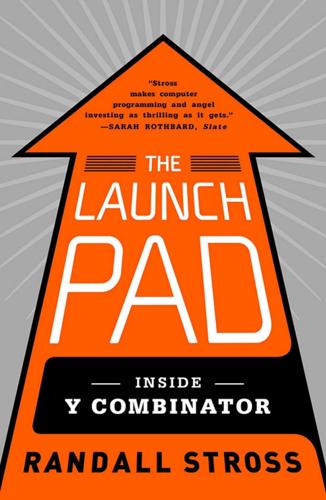
The Launch Pad: Inside Y Combinator, Silicon Valley's Most Exclusive School for Startups
by
Randall Stross
Published 4 Sep 2013
“NFC seems like it’s going to be something real, more so than maybe QR codes,” says Buchheit. “Because it’s useful for payments or whatever.” “I guess so,” says Ralston. “The thing about QR codes is I’m starting to see them in places that are really surprising to me.” “They’re all over the place,” Buchheit agrees. “But I’ve never seen someone use them. I think they still might be a fad. Because it takes effort.” NFC seems to him more practical, as he imagines using it to pay for things or unlock the door of his house with a wave of his cell phone. “QR codes are so much cheaper than these things. So much cheaper,” says Graham.
…
You knew it immediately.” He does not feel the same about scanning QR codes, though. “Oh, no, no,” says Buchheit, making clear he did not mean to imply that QR codes are the same as the CueCat. “But it’s that same dream, ‘Oh, this is great, ’cause our customers want to interact with advertisements.’ I think the answer is, ‘Not really.’ I think marketers are deluding themselves about the extent to which their customers want to interact with the advertisements.” Ralston gets his phone out to see how long it takes him to scan a QR code. He succeeds quickly. “That was surprising,” Graham says, impressed.
…
Graham has not heard of this plan. “No shit? Bus stop advertising!” “On the guerrilla side of that, we’ve actually printed up these labels, which are like, ‘Tap here’ or ‘Scan a QR code.’ We’re going to put them up on MUNI stops around San Francisco. Just to see what people do.” Geoff Ralston speaks up. “Aren’t a lot of people doing that kind of thing?” He knows that there is a startup in this batch that is doing QR codes—Paperlinks. “Isn’t that really a crowded space? Or becoming one?” Graham tries to turn the conversation back to the question: how is the company going to generate revenue? “You’ve got to figure out some plan for making money so you can survive.”
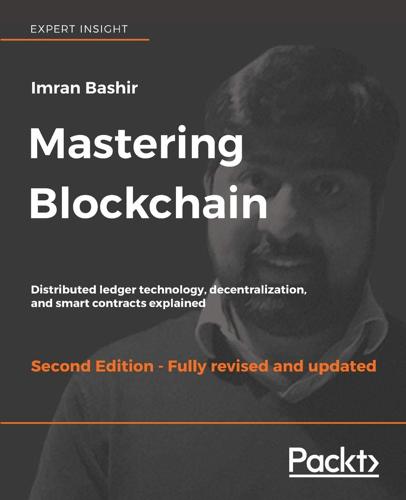
Mastering Blockchain, Second Edition
by
Imran Bashir
Published 28 Mar 2018
If Irshad requests money from Bashir, then she can send a request to Bashir by using QR code. Once Bashir receives this request he will either scan the QR code or manually type in Irshad's Ethereum address and send Ether to Irshad's address. This request is encoded as a QR code shown in the following screenshot which can be shared via email, text or any other communication methods. You can download Jaxx wallet from https://jaxx.io. QR code as shown in the blockchain wallet application Once Bashir receives this request he will either scan this QR code or copy the Ethereum address in the Ethereum wallet software and initiate a transaction.
…
As an example, the Blockchain wallet is shown here where a payment request is created: bitcoin payment request (using Blockchain wallet) The sender either enters the receiver's address or scans the QR code that has the Bitcoin address, amount and optional description encoded in it. The wallet application recognizes this QR code and decodes it into something like Please send <Amount> BTC to the Bitcoin address <receiver's Bitcoin address>. This will look like as shown here with values: Please send 0.00033324 BTC to the Bitcoin address 1JzouJCVmMQBmTcd8K4Y5BP36gEFNn1ZJ3. This is also shown in the screenshot presented here: Bitcoin payment QR code The QR code shown in the preceding screenshot is decoded to bitcoin://1JzouJCVmMQBmTcd8K4Y5BP36gEFNn1ZJ3?
…
The resultant 160-bit hash is then prefixed with a version number and finally encoded with a Base58Check encoding scheme. The bitcoin addresses are 26-35 characters long and begin with digit 1 or 3. A typical bitcoin address looks like a string shown here: 1ANAguGG8bikEv2fYsTBnRUmx7QUcK58wt This is also commonly encoded in a QR code for easy distribution. The QR code of the preceding bitcoin address is shown in the following screenshot: QR code of a bitcoin address 1ANAguGG8bikEv2fYsTBnRUmx7QUcK58wt Currently, there are two types of addresses, the commonly used P2PKH and another P2SH type, starting with number 1 and 3, respectively. In the early days, Bitcoin used direct Pay to Pubkey, which is now superseded by P2PKH.

Lonely Planet Pocket Reykjavík & Southwest Iceland
by
Lonely Planet
Glacierheli (glacierheli.is) Helicopter flights from Reykjavík and Möðrudalur in the northeast. Horse-Riding Tours Eldhestar (eldhestar.is) Rides on grasslands surrounding Hveragerði. Íshestar (ishestar.is) One of the oldest stables with trots through lava fields and longer rides. Stóri Kambur (storikambur.is) Rides on the Snæfellsnes Peninsula. Scan this QR code to check visitreykjavik.is or head to Iceland’s official regional tourist websites for loads of information on activities and tours, maps, and self-guided walking-tour brochures. Bicycle Tours Reykjavík Bike Tours (icelandbike.com) Bike hire and tours of Reykjavík and surrounds. Bike Company (bikecompany.is)Mountain-bike tours throughout the region.
…
Brilliantly curated exhibits lead you through the struggle to settle the forbidding island, the radical changes wrought by the introduction of Christianity, the lean times of domination by foreign powers and Iceland’s eventual independence. map Google map TRABANTOS/SHUTTERSTOCK © PLANNING TIP The free audio-guide app has loads of useful detail in nine languages. The one for kids is in Icelandic or English only. Leave extra time for the museum’s rotating photographic exhibitions. Scan this QR code for full opening hours and to book ahead. Settlement-Era Finds The premier section of the museum describes the Settlement Era – including the rule of the chieftans and the introduction of Christianity – and features swords, drinking horns, silver hoards and a powerful bronze figure of Thor.
…
The Aðalstræti Settlement Exhibition, a fascinating archaeological-ruin-museum spanning Aðalstræti 10 and 16, is based around a 10th-century Viking longhouse and other Settlement Era finds from central Reykjavík, and reconstructs how the city came to be. map Google map ARCTIC-IMAGES/GETTY IMAGES © PLANNING TIP Excellent English-language tours run at 11am May to August. Multilingual audio guides are free. The kids’ corner has traditional Icelandic toys, rune spelling exercises and computer games. Scan this QR code for info on the full Aðalstræti complex. Viking Longhouse The Aðalstræti complex is constructed around a 10th-century Viking longhouse unearthed here in 2001–02. Mainly a series of foundation walls now, it was thought to be inhabited for only 60 years. Look for areas of the longhouse with animal bones deliberately built into the structure (for good fortune, perhaps) and for the old spring.
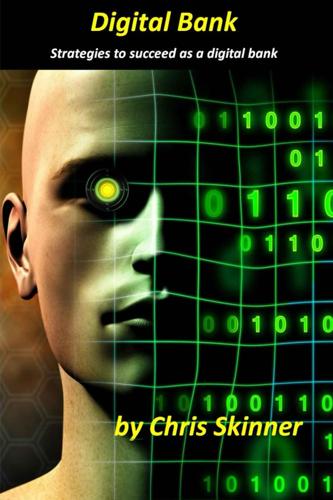
Digital Bank: Strategies for Launching or Becoming a Digital Bank
by
Chris Skinner
Published 27 Aug 2013
Now they’re pushing for merchants to offer Pingit via simple QR codes and Corporate Identifiers. The idea of the Corporate ID is that firms can buy Pingit accounts such that customers just put in “Tesco” or “Waterstones” and the payment is made without needing to know the company’s account numbers or other details. That’s pretty cool. Even better is that you can embed all the data you need in a QR code. So, as you walk past an ad for a charity campaign, hold your phone over the QR code and make an immediate donation or, even better for the utility firms, send out a bill to a customer with a QR code embedded that includes all the payment details and the payment amount.
…
Meanwhile, in Asia, images are being used along with QR codes[18] to support completely automated banking. For example, Jibun Bank and eBank in Japan both accept account opening on the basis of just a photograph via mobile of your driving licence. The driving licence is read by a character recognition system and checked with the government’s driving database. As long as all is aligned, the account is opened. More recently, Barclays Bank in the UK introduced QR codes to their P2P payments app, Pingit. The app allows billing companies to send paper payment requests to customers with a QR code and, if the customer uses their smartphone to read the code, all of the billing information and customer account information is embedded with the code so that the customer purely has to confirm payment.
…
Nevertheless, it is gradually expanding in usage and, as mentioned, you can use Bitcoins at Point-of-Sale. For example, Verifone launched a Point-of-Sale (PoS) system in 2011 that will allow Bitcoins to be traded on merchants terminals in stores. The system is based upon QR codes – digital barcodes for mobile – and these are printed by the Verifone terminal. The customer can then scan this into their phone. Equally, they can make a Bitcoin payment by presenting the QR code on their phone for the merchant to scan. This does not mean that Bitcoins emergence into the public domain has been without issue. For example, one key challenge is liquidity and the fact that this is a limited market today.

Deadly Quiet City: True Stories From Wuhan
by
Murong Xuecun
Published 7 Mar 2023
On this vast land from Shanghai in the east to Guiyang in the southwest, hundreds of millions of Chinese people must report their location and status to the government like criminals on parole. Everyone has a personal QR code which is required to prove you are legal and uninfected just to be able to take subway journeys, enter restaurants, or shop at supermarkets. No one cares anymore about privacy or rights because they disappeared long ago in China. In the foreseeable future, COVID-19 prevention policies that treat people with contempt will continue. When the day comes that COVID-19 is no longer a pandemic, Xi Jinping will not relinquish ruling by QR code. It will shackle China for a long time to come because the QR codes report people’s movements; and when required it can be changed to ensure that ‘petitioners’ and dissidents, as well house church congregants, have no options to seek justice.
…
Zhang Zhan responds with the ‘beneficiary’ argument: ‘Who is the biggest beneficiary of this pandemic? It’s the Communist Party, it uses the pandemic to strengthen its totalitarian rule.’ Zhang Zhan is right about that. Not long after the epidemic broke out, the Communist Party rolled out its ‘rule by QR code’. First in Zhejiang and then nationwide, every Chinese citizen has to live a QR-code life. They must swipe their own QR code to get on a bus, a subway or a taxi, and at train stations and restaurants, informing the government of their whereabouts at all times. It’s a new technology George Orwell hadn’t thought of. Few people in China openly object. ‘I really don’t understand why nobody is talking about this,’ says Zhang Zhan.
…
As Wuhan’s June heatwaves are making people wilt and flowers bloom, Yang Min is still living under surveillance and house arrest. Across the nation, at malls, supermarkets, train stations and airports, everyone has to scan QR codes to record their health details, movements and modes of transport. Yang Min suspects her mobile phone has been tampered with. ‘I can never scan the QR codes,’ she says. ‘Other people scan just once, but when I try, it just keeps on spinning, but nothing ever appears on the display.’ Almost inaudibly, she says, ‘But even if I could scan, they won’t let me out, let alone now that the scans don’t work.’

Blockchain: Blueprint for a New Economy
by
Melanie Swan
Published 22 Jan 2014
To send someone else Bitcoins, you need his address and the private-key part of your wallet where the software checks that you have control over the Bitcoins you would like to spend or transfer. To send someone Bitcoins, you scan his wallet address QR code or otherwise obtain his address characters or QR code (e.g., by email or SMS). The sender scans the QR code address of the receiver’s wallet and uses the wallet application to enter additional information about the transaction, such as amount, transaction fee (usually affirming the amount prespecified by the wallet software), and any other parameters to send the receiver Bitcoins.
…
The doors of physical property such as vehicles and homes could be “smartmatter”-enabled through embedded technology (e.g., software code, sensors, QR codes, NFC tags, iBeacons, WiFi access, etc.) so that access could be controlled in real time as users seeking entry present their own hardware or software token to match that of the asset. Absent preconfigured access tokens, when the user submits a real-time access request, the blockchain smart contract could send an acknowledgment or token access mechanism to the physical asset or user ewallet, such as a one-use QR code to open a rental car or hotel room. Blockchain technology offers the ability to reinvent identity authentication and secure access in ways that are much more granular, flexible, and oriented to real-time demand than are currently possible, elegantly integrating physical-world hardware technologies with digital Internet-based software technologies.52 Smart property transacted with blockchains is a completely new kind of concept.
…
OneName is an open source protocol built on the Namecoin protocol that puts users in charge of their digital identity verification, rather than allowing centralized social media sites like Facebook, LinkedIn, and Twitter to be the de facto identity verification platform, given that many websites have opted to authenticate users with social media APIs.88 A similar project is BitID, which allows users to log in to websites with their Bitcoin address. Instead of “Login with Facebook,” you can “Connect with Bitcoin” (your Bitcoin address). BitID is a decentralized authentication protocol that takes advantage of Bitcoin wallets as a form of identification and QR codes for service or platform access points. It enables users to access an online account by verifying themselves with their wallet address and uses a mobile device as the private-key authenticator.89 Another proposed digital identity verification business is Bithandle, which was developed as a hackathon project.
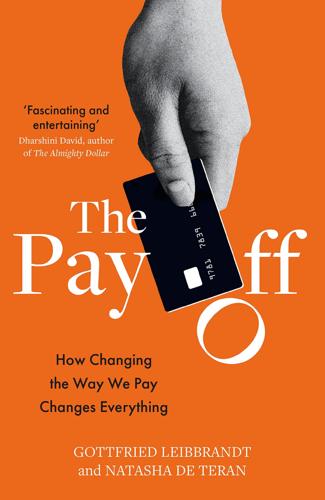
The Pay Off: How Changing the Way We Pay Changes Everything
by
Gottfried Leibbrandt
and
Natasha de Teran
Published 14 Jul 2021
The two Chinese systems are inherently peer to peer: anyone can send and receive money to or from anyone else, whether they are consumers or merchants. Similarly, anyone can act as a merchant and accept payments. Street vendors often show printed QR codes on their stalls, which buyers scan to make their payments. Apparently, even beggars now have them. The QR code turns the traditional card model upside down. With cards, consumers are offline and just show their cards, while the merchants are online thanks to the card terminals that are connected to phonelines or the internet. With QR codes, however, consumers are online (through their phones), while merchants can be offline. It’s much easier for merchants to accept payments through Alipay and Tenpay than it is for them to take card payments.
…
The number of card-accepting merchants and card terminals in China declined by 15 per cent between 2018 and 2019, one of the very few payment statistics in China that’s going down (the other is ATMs, which declined at a much slower 1 per cent).1 QR codes have spread throughout China. They even featured during the 2019 grand military parade marking the seventieth anniversary of the founding of the People’s Republic of China. During the parade, the elite troops of the People’s Liberation Army sported QR codes on their body armour, presumably for identification purposes – digital ‘dog tags’ – rather than to solicit donations. Alipay and Tenpay have come to dominate retail payments in the country in record time.
…
The report also mentions 378 billion transactions for the Nets Union platform, through which the two super apps have to route all ‘QR code’ payments. The true number of super-app transactions therefore lies in between 378 and 720 billion. We have taken the conservative approach and used the lower figure. Data in Figure 3 are for 25 CPMI countries and taken from BIS, except the Chinese data, which are taken from the PBoC. The data for the Eurozone represent the total for the six Eurozone countries in the CPMI 25. Transaction fees for the Chinese super apps are taken from: www.chinadaily.com.cn/bizchina/2016-09/13/content_26778445.htm For the story on QR codes replacing tin cups, see: www.brookings.edu/research/is-chinas-new-payment-system-the-future/ For QR codes on uniforms, see: www.businessinsider.co.za/chinese-troops-qr-codes-on-body-armor-massive-parade-2019-10 For the story on Alipay’s Yuebao fund, see: www.forbes.com/sites/ywang/2020/01/17/ant-financial-is-shifting-away-from-chinas-76-trillion-online-payments-market/ Chapter 11 For an overview of instant payment systems in fifty countries, see: www.fisglobal.com/flavors-of-fast The number of UPI transactions is taken from the National Payments Corporation of India (NPCI): www.npci.org.in/product-statistics/upi-product-statistics Chapter 12 Figures on global payment revenues taken from McKinsey and BCG: ‘The 2020 McKinsey Global Payments Report’ https://www.mckinsey.com/~/media/mckinsey/industries/financial%20services/our%20insights/accelerating%20winds%20of%20change%20in%20global%20payments/2020-mckinsey-global-payments-report-vf.pdf; ‘Global Payments 2020: fast forward into the future’ https://web-assets.bcg.com/7c/e0/596af1214f32820093f1f88c05f0/bcg-global-payments-2020-fast-forward-into-the-future-oct-2020-1.pdf How much consumers account for payment revenues depends on who you ask.

The Complete Android Guide: 3Ones
by
Kevin Purdy
Published 15 Apr 2011
Whether you upgrade, or replace the phone you dropped in the pool, you can always re-download any app you've paid for, unless the developer has released a version so new and different that they've cut off access. Then again, a kind email can often rectify that kind of oops-too-late hang-up. Alternate App Finding: QR Codes QR Code Because searching is so non-specific in the Market, and because apps can share common names and descriptions, many developers have taken to providing direct Market links to their apps through QR codes. They're like bar codes with another dimension thrown in, and you'll need an app to scan them from a web page or paper document. Search for Barcode Scanner in the Market, find the one made by ZXing Team, and install it (it's one of the 10 things we suggest new Android owners should do right away).
…
This author has yet to meet an Android enthusiast who's been able to say more than “meh” or “it works” about the stock Music app—though that may change when a forthcoming update enables over-the-internet desktop music streaming. Regardless, you'll be glad to give a slicker player a try. 7 - Install a Barcode Scanner QR Code Open the Market app, search for “Barcode Scanner,” and install the app from the ZXing Team. Why? Soon enough (late fall of 2010, actually), Google will offer a way for Android owners to simply click on an application they want on the internet, then have it instantly beam over the air to their phone. In the meantime, there are QR Codes. They look like alien barcodes, they're all over the geekier parts of the internet and a growing number of magazines. You'll need an app like Barcode Scanner to scan them, which in turn loads the right Market page you can install from. 8 - Create an unlock pattern, PIN, or password Unlock Gesture Pattern Hit your Menu button from the home screen, choose Settings, select “Location & security,” then pick “Change screen lock.”
…
But grabbing non-Market apps can also be very useful. As of this writing, audiobook maker Audible has a beta version of its player for Android that can't be had in the Market, but which made listening to Girl with the Dragon Tattoo possible on a recent car trip. To install it, you need to download the installer, or grab it using a QR code, and have your phone set to allow non-Market installations. I've also installed a little-known application, Chrome to Phone, that can instantly beam web URLs, Maps locations, and even text I've selected in my laptop browser right to my Android phone. Enabling Non-Market App Installation To unlock a non-Market app installation, head to your Settings, into the "Applications" menu, check the box next to "Unknown sources," and confirm in the pop-up warning dialogue that you're aware of what you're doing.

Designing Search: UX Strategies for Ecommerce Success
by
Greg Nudelman
and
Pabini Gabriel-Petit
Published 8 May 2011
A person can use a mobile phone with the free mobile QR code reader app (such as NeoReader or RedLaser) to read the link’s URL and navigate to the Web page providing Wikipedia content about the object or place that a person is looking at. Other historic landmarks are developing their own solutions. As reported by an on-line magazine 2d code, the Italian city of Senigallia has declared itself a “QRCity” by tagging all the historic buildings with QR codes. When scanned with a mobile phone, these QR codes transfer the user to the city’s mobile site with extensive tourist information in Italian and English. Figure 14-9 shows a QR Code in the plaque on the Senigallia’s Palazzo Comunale.
…
Figure 14-9 shows a QR Code in the plaque on the Senigallia’s Palazzo Comunale. Figure 14-9: Senigallia’s Palazzo Comunale historical site tagged with a Semapedia barcode Another example of the capability of mobile barcode-recognition technology comes from the Suntory Company in Japan, which tagged its beer cans with a QR code. Scanning this barcode with a QR code reader app navigates consumers to a mobile Web site where visitors can register to offset 100g of CO2 emissions once per day and get tips for mitigating their own greenhouse gas emissions. Both of these examples demonstrate that we are moving ever faster toward a world populated by smart objects, which Bruce Sterling dubbed spimes—a word made up by combining space and time.
…
Some search features that might support fact finding include the following: alphanumeric string correction—which uses fuzzy matching so users can mistype a model name and still find it autophrasing—which detects when multiword combinations are likely compounds, automatically boosting the relevancy of those results barcode or QR code scanners—which use a mobile phone’s camera to directly retrieve product information At the other extreme of the continuum is discovery, where people don’t yet know what they want or even how to describe it. For example, they know they want a more durable grill, but they don’t yet know the attributes that make a grill durable or the brands they trust to build a reliable one.

Lonely Planet Singapore
by
Lonely Planet
Published 14 May 2024
Sprawling across 101 hectares of reclaimed land in the city centre, Gardens by the Bay is an ambitious masterpiece of urban planning that cost S$1 billion to build. The result? A mind-blowing display of horticultural and architectural artistry that has completely transformed Singapore’s cityscape. Supertree Grove | FuuTaMin/shutterstock © TICKETS Scan this QR code to get tickets in advance at gardensbythebay.com.sg. Bundle tickets are available. Supertree Grove The centrepiece of Gardens by the Bay, the colossal Supertrees tower over the canopy like bionic sci-fi timber. Adorned with 162,900 plants from over 200 species, these steel-clad concrete structures act as vertical gardens.
…
Food Playground is a hands-on cooking school that explores Singapore's multicultural make-up and sees you prepare classic dishes such as laksa, nasi lemak (coconut rice) and char kway teow (stir-fried rice noodles with cockles, Chinese sausage and dark sauces). Courses usually run for three hours and include an informative history of the dishes and an introduction to local ingredients. Classes book out early, so make sure to reserve your spot via foodplayground.com.sg. Scan this QR code to book your course. BEST FINE DINING IN CHINATOWN Cloudstreet An unmissable 2½-hour gastronomic experience. $$$ Olivia Restaurant & Lounge Be transported to Barcelona with these tantalising dishes inspired by Catalan and Mediterranean cuisines. $$$ Tippling Club Stylish dining that pushes the boundaries with modern techniques and unexpected flavour pairings. $$$ Little India & Kampong Glam COLOURFUL ENCLAVES STEEPED IN HISTORY Little India originally emerged as a settlement for Indian immigrants who arrived during the colonial era.
…
Lorong Buangkok | DerekTeo/shutterstock © JOIN A GUIDED TOUR Those keen to go deeper could join Let’s Go Tour Singapore (letsgotoursingapore.com/tours/kampong-experience/) on a guided wander through the kampong, listening to stories about provincial life and learning about the traditional village spirit. Take a stroll around the neighbourhood with your local guide and get the chance to step inside one of the kampong houses and chat with local residents. Scan this QR code to book your tour. Singapore Zoo One of the world’s best zoos Sprawled across 26 lush hectares on a peninsula jutting into the Seletar Reservoir, 50-year-old Singapore Zoo (mandai.com/en/singapore-zoo) is a tropical wonderland where 300 species of animal roam in spacious enclosures and across wide open spaces.
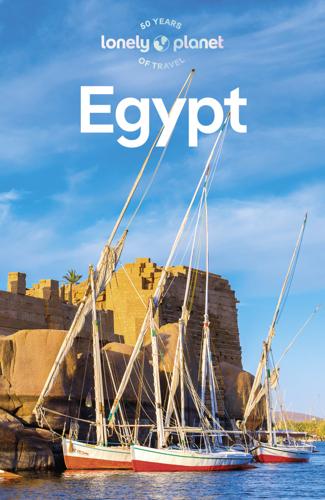
Lonely Planet Egypt
by
Lonely Planet
. $$ TOP SIGHT The Giza Pyramids The Giza Pyramids are one of the most recognisable landmarks in the world, but nothing quite prepares you for seeing the world’s last-standing Ancient Wonder up close. It’s not all about the Sphinx and the three massive Pyramids though. The entire Giza Plateau is a necropolis dedicated to ancient Egypt’s 4th dynasty so take your time and explore beyond the major monuments. KANUMAN/SHUTTERSTOCK © PRACTICALITIES Scan this QR code for prices and opening hours. DON’T MISS Great Pyramid of Khufu Interior of the Great Pyramid Sphinx Pyramid of Menkaure Pyramid of Khafre Tomb of Meresankh III Tomb of Qar Great Pyramid of Khufu The Great Pyramid is both the largest in Egypt and the oldest here on the Giza Plateau.
…
TOP SIGHT Egyptian Museum While Giza’s GEM may generate headlines, this grand dame museum simply potters along being Egypt’s major ancient history showcase as it has done since it moved to this location in 1902. Mindful of the GEM’s impending opening, the museum has been busy refurbishing its galleries (an ongoing process), creating a more approachable space for you to explore the riches within. Sphinx of Hatshepsut | LEXOSN/SHUTTERSTOCK © PRACTICALITIES Scan this QR code for prices and opening hours. DON’T MISS Narmer Palette Limestone statue of Zoser Statue of Khafre Wooden statue of Ka-Aper Death masks of Yuya and Thuya Silver coffin of Psusennes I Death mask of Tutankhamun (it will move to the GEM when it opens) Tutankhamun’s death mask | PHOTOFRAME123/SHUTTERSTOCK © Museum Highlights The ground-floor galleries are set up so you sweep through ancient Egypt’s history in chronological order.
…
TOP SIGHT Cairo Citadel (Al Qala’a) This is where you come for city vistas that, on a clear day, stretch to the Pyramids, and to soak up the ostentatious domed ceiling of Mohammed Ali’s grand mosque. Parts of the Citadel are perpetually under restoration with large sections blocked off. Even with half the site out of bounds, though, you’ll need a good two hours to get through everything. WITR/SHUTTERSTOCK © PRACTICALITIES Scan this QR code for prices and opening hours. WHAT’S OPEN? On our last visit only the Mosque of Mohammed Ali, Mosque of An Nasir Mohammed, the two main terraces and the Harem Palace (National Military Museum) were open. Gawhara Palace & Gawhara Terrace The palace (closed for years and completely dilapidated) is the first building you see on entering the Citadel compound.
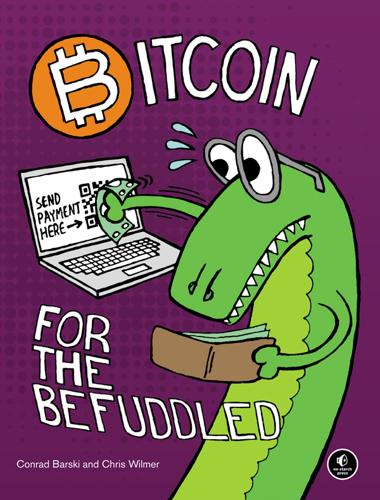
Bitcoin for the Befuddled
by
Conrad Barski
Published 13 Nov 2014
Because Bitcoin addresses are cumbersome to type, many people use quick response (QR) codes to represent their address (see Figure 2-1).2 For convenience, you can put your Bitcoin address, either typed or as a QR code (or both), on your business card, personal website, or storefront (if you’re a merchant). Although you need an Internet connection to send bitcoins, you don’t need to be connected to receive them. For example, if you work for a charity and pass out thousands of business cards containing your Bitcoin address and a statement like “Please consider donating in bitcoins,” your organization can collect bitcoins while you sleep. Figure 2-1: QR codes can be used to represent arbitrary data.
…
To enhance your privacy, you can use many Bitcoin addresses but publicly share only some of them.3 So how do you move bitcoins from one address to another (i.e., spend them)? Well, this action requires a private key. The Private Key A private key, like a Bitcoin address, is a long string of numbers and letters (usually beginning with the number 5). As with Bitcoin addresses, QR codes are often used to represent private keys because of their length. Each private key is paired with a single Bitcoin address and is able to unlock the bitcoins at that address (i.e., move them elsewhere).4 The following is an example of a private key: 5J2ae37Jwqzt7kSp9rE17Mi2LbkHXx4tzNSzbq7xDp2cQJCzhYo Whereas a Bitcoin address is similar to a bank account number, a private key is more like a PIN: You need it to authorize a withdrawal or an expenditure.
…
Other Common (and Not So Common) Bitcoin Wallet Features In addition to features dictated by the underlying design of different wallet architectures, some Bitcoin wallets have a variety of other basic and advanced features. Some basic features you should expect to see include password protection, the ability to make backups of your private keys, QR code scanning and generation, and the ability to generate and import paper wallets.4 A somewhat advanced feature that is common to many Bitcoin wallets is the ability to sign messages with your private key. Recall that Chapter 7 discussed how digital signatures are used to sign Bitcoin transactions with your private key.
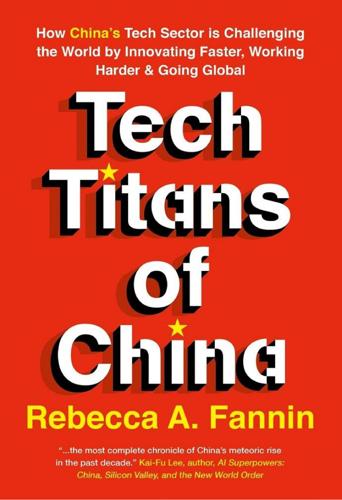
Tech Titans of China: How China's Tech Sector Is Challenging the World by Innovating Faster, Working Harder, and Going Global
by
Rebecca Fannin
Published 2 Sep 2019
WeChat has more than 1 billion users worldwide, and it’s hard to beat it for work or for play. A San Francisco venture capitalist completed a term sheet for an investment deal in Beijing entirely on WeChat. Fans surrounding a Bay Area venture investor speaking at a Shenzhen conference connected instantaneously with him by scanning his WeChat QR code from their smartphones. Even beggars in China’s major cities carry smartphones with QR codes to receive donations. Cash and email are things of the past in China. WeChat is just one of many Chinese innovations that is revolutionizing the future with advances that are still rare in the West. China’s e-commerce startup Pinduoduo makes online shopping on your mobile for bargains truly social and fun.
…
On his first trip to Israel in May 2018, he led a delegation of 35 Alibaba executives to visit investors and check out startups in Israel’s stronghold of cyber-security as well as augmented reality, online gaming, QR codes, and AI. Alibaba promptly invested $26 million in big data company SQream Technologies, co-invested $40 million in mass transit software startup Optibus, and added to its $30 million co-investment in safe driving technology startup Nexar. These deals were on top of its first Israeli deal, an acquisition of personalized QR code designer Visualead in 2017 to establish a Tel Aviv research and development center. China to Israel deals are a growing trend, marrying capital and market potential.
…
An intelligent voice assistant lets couriers receive and report orders when delivering without having to operate their mobile phones while riding. Such advances have helped Meituan to shave seven minutes off its average delivery times since 2016. Other techie stuff Meituan has built in are security checks that identify and verify riders by QR code and an advanced electronic record management system to confirm business licenses of merchants on its platform by connecting with a government supervision database. The system also can synchronize data to track food safety and hygiene and check and analyze customer reviews by time period, location, and product category to spot any trouble.

Creative Intelligence: Harnessing the Power to Create, Connect, and Inspire
by
Bruce Nussbaum
Published 5 Mar 2013
Our drive to increase our participation and engagement with everything around us extends increasingly to our stuff. Smartphone users can scan QR codes, now pervasive in magazines, billboards, labels, and even the things we buy, to directly connect to a website or some other online source of additional information. Just wave your smartphone in front of the QR code to connect. Innovators from a number of different fields are embracing the codes. Pat Pruitt, a metalsmith from New Mexico, won the Innovation Award at the Santa Fe Indian Market in 2011 for his concho belt that used QR code as decoration. Each of the nine conchos had its own code, stylistically inscribed as an abstract piece of art.
…
When you scanned it with your phone, a line of a poem written by Pruitt appeared, as well as a link to Pruitt’s website. There are billboards for Calvin Klein with no picture, no model, no advertising—just a huge QR code and the words: “Get It Uncensored.” When you scan the code, you obtain access to a racy video of models in Calvin Kleins. Like a secret handshake, QR codes are an exclusive form of engaging. The art world, too, is embracing the use of QR codes. In 2011 MoMA featured an exhibit called Talk to Me, curated by Paola Antonelli, Senior Curator of Architecture and Design at the museum. We’re used to museum exhibits that feature beautiful and sometimes provocative things hanging on walls or projected onto screens; our engagement is typically limited to our response to what’s in front of us.
…
We’re used to museum exhibits that feature beautiful and sometimes provocative things hanging on walls or projected onto screens; our engagement is typically limited to our response to what’s in front of us. But Antonelli’s exhibits focus more on our interaction with the objects around us. Nearly all the items in Talk to Me had QR codes that gave people a chance to interact more deeply with the exhibit. In their 1999 book The Experience Economy, Joseph Pine and James Gilmore argued that we were evolving from an economy that valued things to an economy that valued experiences. While that was an important step toward focusing on what was meaningful to people, the term “experience” implies a passiveness that won’t fly with a population that wants to create its own engagements.
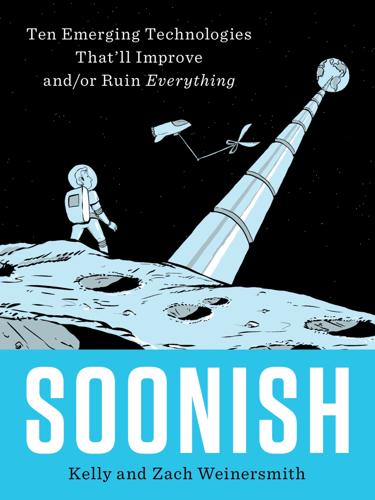
Soonish: Ten Emerging Technologies That'll Improve And/or Ruin Everything
by
Kelly Weinersmith
and
Zach Weinersmith
Published 16 Oct 2017
Basically, a fiducial marker is an object placed in reality that is easy for a computer to recognize visually. Visualize something like the now common QR code. Imagine you have a table with a QR code in its middle. For simplicity, let’s imagine you are wearing an augmented reality headset that projects images into your eye. The headset’s cameras see the QR code and determine two things: (1) that its pattern codes for “put a vase here,” and (2) that you’re looking at the QR code from a particular angle. As you move, the headset detects the changing orientation of the QR code and adjusts the vase accordingly. If it works right, you perceive a vase sitting on your table, even if you walk around or jump up and down.
…
It also tells you that, by the way, a Civil War battle happened in this forest in 1864, and offers you the option to see a virtual reenactment laid over. This is all awesome, but it would ruin the mood (and be hard to set up) if you had to put a QR code on every object the user might be interested in. So a big area of current research is how to use regular ambient markers to determine all the stuff a QR code might tell you. That way, instead of putting markers all over the Eiffel Tower, you’d have a device that just recognizes the Eiffel Tower. “But wait,” you say. “I’ll just use my GPS. My GPS knows where the Eiffel Tower is.”
…
Craig Venter Institute, 214–15 Jell-O, 298 Jell-O shots, 161 jet fuel, 209–10, 218 Jin, Yaochu, 122 joinery, 143–44 Joint BioEnergy Institute, 210 Joint European Torus (JET), 89 Josephson, Brian, 5–6 Josephson junction, 6 Jurassic Park (film), 222 Kazakhstan, 100 Keasling, Jay, 199 Keating, Steven, 146–48, 153, 155, 253 Kennedy, Philip, 315–17 Kevlar, 35 Khoshnevis, Behrokh, 145, 146, 147, 158 kidneys (organ), 280 Kilobot project, 115, 119 Kohler, Matthias, 152 Kurman, Melba, 159 Lake Chagan, 100 lasers, 2, 27–29, 84, 86–87 Law of the Sea, 33 leukemia, 238, 239, 242 Leuthardt, Eric, 303, 314–15 Levin, Gilbert, 334 levitation, 326–27 LiDAR, 174 life insurance, 250 LIFT (laser-induced forward transfer), 265–66 Limited Test Ban Treaty (LTBT), 99 Lipschultz, Bruce, 91–92, 93 Lipson, Hod, 159 Lipton, Jeffrey, 162 liquid hydrogen, 39 liquid oxygen, 20, 39 lithium, 77 LIT ROOM, 110–11 livers (organs), 257–59, 260–61, 280 lizards, 187 locked-in syndrome, 316 Lockheed Martin, 90 lossless power transmission, 325 Low Earth Orbit (LEO), 14, 15–16, 21, 34, 38 Lowther, William, 50 lung cancer, 238–40 lungs (organ), 261 Lyme disease, 255 lymphoma, 242 McAlpine, Michael, 271 McCracken, Garry, 77 Magee, John Gillespie, Jr., 13 “magic book,” 176 MagLIF (Magnetized Liner Inertial Fusion) project, 87–88 “magnetic confinement”-type reactors, 85 magnetic levitation (MagLev) trains, 24–25, 30, 327 magnetosphere, 59 magnets, 5 MakerBot, 162 malaria, 198–203, 207 mammoth genome, 222–24 Mankins, John, 320 marble, 144 marching bands, 119–20 Mars, 19, 40, 45n, 52, 55, 158–59 Mars One project, 45n Masiello, Carrie, 210–11 Massachusetts General Hospital, 242 Massachusetts Institute of Technology (MIT), 102, 103, 104, 106, 107n, 108, 214, 216 Mediated Matter lab at, 146 Plasma Science and Fusion Center at, 91 matching markets, 275–81 Matthews, Kirstin, 250 Maus, Marcela, 242–43 Max Planck Institute for Infection Biology, 212 µBiome, 2 M-blocks, 118 MD Anderson Cancer Center, 232, 234 Mediated Matter lab, 146 medical tourism, 272 medical trials, 254–55, 268–69 medicine, 221 augmented reality in, 179, 185–86 bioprinting and, see bioprinting origami robots in, 106–7 programmable matter in, 127–28 synthetic biology in, 198–207 see also precision medicine Meetup.com, 175, 179 MEG (magnetoencephalography), 289–90, 291 Meissner effect, 326 meltdown, 91–92 memory, 220, 304, 307–8, 311 Mendelsohn, John, 232, 234 Meng, Yan, 122 Menges, Achim, 104 Menon, Sandeep, 235 messenger RNA, 193 metabolome, 244–46 meteorites, 53, 67 Michigan Array, 296, 298 microRNA, 239–40, 246–47 Microsoft, 272 Miller, Jordan, 261, 269, 270–71, 274 miniaturization, 176 “Minibuilders,” 151–52 miRBase, 240 mirror humans, 332–35 MIT Technology Review, 6n molds, configurable, 134 molecular scissors, 212, 213–14 molecules, mirror, 334 monogenic traits, 196–97 mononucleosis, 230 moon, 55 moon landing, 19 moral hazard, 273–74 Moravec’s Paradox, 139 mosquitoes, 200, 203, 218 Mossad, 50 motion sickness, 168 movies, 183 MRI (magnetic resonance imaging), 290–91 M-type (metal) asteroids, 53, 54 mucociliary escalator, 187–88 mucus, 236 Mukhopadhyay, Aindrila, 210 multiverse, 329 Munger, Steven, 334–35 Musk, Elon, 19 mutation breeding, 191–92 mutations, 219, 236–37 Mycoplasma genitalium, 214–15 Mycoplasma laboratorium, 215 Mycoplasma mycoides, 215n Nagasaki bombing, 98 nano-bio-machines, 3 nanobots, 118 nanotechnology, 221 NASA Innovative Advanced Concepts (NIAC), 25, 31, 35 nasal cycle, 186–89 nasal venous sinusoids, 188 NASA (National Aeronautics and Space Administration), 20, 47, 60, 65, 92, 158, 159–60 National Academy of Sciences, 203 National Cancer Institute, 238 National Defence Department, Canada, 47 National Ignition Facility (NIF), 86–87 National Institutes of Health, 214, 234, 235 Native Americans, 196n natural gas, 73, 98–99 Nebraska, University of, 176 Neufert, Ernst, 135 neural dust, 299 neural implants, 310 Neurobridge, 312 neuro-cyber-connection, 312–13 neurons, 286–87, 290, 298, 306 EEGs and, 287–90 NeuroPace, 302 neuroprosthetics, 311, 315, 322, 324 neurotrophic electrodes, 297–98, 315, 316 Neutron Club, 80 neutron gun, 80–81 neutrons, 73, 91 New Jersey, 299 New Mexico, 96 nickel, 54 Nocera, Dan, 208 North Carolina State University, 63 Norway, 22n nostrils, 186–89 Nuclear Explosions for the National Economy, 100 nuclear reactors, 58 Nucleon (concept car design), 97 nucleus, 192, 193 nutrition, 245–46 Olestra, 334 Oliver, John, 326n Open Humans Foundation, 252n “optical mining,” 63 orbiting factory, 24 organ donation, 257n organ markets, 274, 275–81 Organovo, 268 organ rejections, 275 organ sales, 258, 280–81 organ transplant list, 257–58, 272 organ transplants, 206–7 origami robots, 105–8, 129 OSIRIS-REx, 65 “Our Friend the Atom” (Disney cartoon), 97 Outer Space Treaty (1967), 63–64 oxidizer, 20 Oxman, Neri, 146, 148 oxygen, 208–9 oxygen deprivation, 205 oxygen gas, 82 Pacific Ocean, 35–36 Paddon, Chris, 199 Palo Alto Research Center, 116 Panama Canal, 97 pancreas, 236 parallel universe, 329 paralysis, 312 Parkinson’s disease, 301 patenting, 124 patent law, 272 peacekeepers, 181 Pennsylvania, University of, 108 Personal Genome Project, 252–53 personal security, 124–25 PERVs, 207 pesticides, 200 Petersen, Kirstin, 149, 150–51 Pfizer, 235 phobias, 179 Phobos (moon of Mars), 55 phosphenes, 306 photosynthesis, 208 Picon, Antoine, 138 pigs, 206 Piraha (Amazonian tribe), 140n Pitt, Brad, 167 Plait, Phil, 36, 38 plants, 125 Chinese sweet wormwood, 198–99 plasma, 85, 88 Plasma Science and Fusion Center, 91 platinum, 52, 55 pluripotent stem cells, 273 plutonium, 58 pogo sticks, 27 Pokémon GO, 8n, 166, 182–83 pollution, 94 porcine endogenous retroviruses (PERVs), 207 positive transcriptional autoregulation, 205n potassium iodide pills, 60 poverty, 157 precision medicine, 229–56 benefits of, 254–56 cancer diagnosis, treatment, and monitoring in, 238–44 concerns about, 248–53 data collection in, 234–35 genetic disorders and, 235–37 metabolome and, 244–46 privacy issues in, 248, 250–53 Precision Medicine Initiative Cohort Program, 234 predictive ability, 1–2 Princeton University, 142, 271 privacy issues, 130, 182, 248 of AR, 180–81 in brain-computer interfaces, 309–10 in precision medicine, 248, 250–53 programmable matter, 101–32 benefits of, 125–29 computers as, 101 concerns about, 122–25 in everyday life, 105 hacking of, 122–23 military applications of, 123–24 origami robots as, 105–8 power for, 118 reconfigurable houses and, 109–11 see also robots programmed materials, 103–5 Project Babylon, 48–49 Project Esper, 185 Project HARP (High Altitude Research Project), 47, 48 Project Plowshare, 96–100 Project Rulison, 98 Promobot, 129 Promobot IR77, 129 propellants, 14–15, 18, 20, 23 prostate cancers, 239n, 247 prosthetics, advanced, 322–24 proteins, 193, 194, 195, 221, 234, 239, 332 protium, 73 protons, 73, 77 Pryor, Richard, 328n QR code, 169–71 quantum computing, 328–30 quantum mechanics, 329, 330 Quinn, Roger, 151n radiation, 59–60, 62, 99 radiation therapy, 241 radioactive waste, 91 railgun, electromagnetic, 24–25 ramjet, 21, 22, 26 Reaction Engines, 22 Recognizer, 180 Reconfigurable House exhibit, 111 recycled fecal matter, 160 recycling, 128 Reece, Andrew, 247 refining, 56 refrigeration, 4 “Registry of Standard Biology Parts,” 216 Reichert, Steffen, 104 Reiss, Louise and Eric, 99 RepRap, 269–70 “repugnance,” in markets, 276 reuse, 128 ribosome, 193–94, 195 Rice University, 200n, 210, 250, 261 rigid airship, 29–30 Ringeisen, Bradley, 259 RNA, 193–94, 195, 332 RNS System, 302 Robinette, Paul, 130 Robot Baby Project, 120n robotic construction, 134–63 benefits of, 156–59 concerns about, 153–56 and space travel, 158–59 swarm robots in, 149–53 3D printing for, 144–49 robots, 102, 129–32 autonomous, 113–16 as construction workers, 139–44 coordinating movement of many, 119–22 evolving of, 120–22 generalization in, 142 industrial, 136 in medicine, 127–28 modular, 112–16 neuroprosthetics and, 311 origami, 105–8, 129 termite-inspired, 150–51 see also programmable matter rocket launches, 3 rockets, 23, 39 air-breathing, 19–24 aircraft-launched, 29–30 cost of, 14 laser ignition for, 27–29 propellant for, 14–15, 18, 20, 23 reusable, 14, 15, 18–19, 39 simplicity of, 22 stages of, 18n rocket sled, 25, 26 rockoon, 29 rod from God, 38 roller coaster, 23, 42 Romanishin, John, 118 Roombots, 112–13, 121, 127 Roth, Alvin, 276, 277, 279, 280 “Ruby Red” grapefruit, 192 Rus, Daniela, 106–7, 108, 118, 128 Russia, 67, 99, 217n SABRE (Synergetic Air-Breathing Rocket Engine), 22 Saddest Generation, 166 Safe Is Not an Option: Overcoming the Futile Obsession with Getting Everyone Back Alive That Is Killing Our Expansion into Space (Simberg), 44 Sahara Desert, 321 SAM (robot), 141, 142, 153–54 Sandia Labs, 85, 87 San Francisco, Calif., 154 sanitation, 157 satellites, 20, 34, 41, 47 Schalk, Gerwin, 313 Schall, Gerhard, 177 Schrödinger’s cat, 329 Schrödinger’s Killer App (Dowling), 330n Schwenk, Kurt, 187 See No Evil, Hear No Evil (film), 328n seizures, 300, 301, 302 Select Sires, Incorporated, 197n self-driving cars, 123 Sensorama, 168 Shapiro, Beth, 222, 223–24 Shotwell, Gwynne, 19 Shtetl-Optimized (blog), 330n Siberia, 224 sickle cell amenia, 237 Silberg, Joff, 210–11, 218–19 silicon, 52, 54 Silver, Pamela, 204, 205–6, 208–10, 219 Simberg, Rand, 44 Skylon, 22 Skype, 314 Skywalker, Luke (char.), 324 Slingatron, 25–26 slums, 157 smallpox, 216, 217 Smart Helmet, 179 “smart homes,” 111 smartphones, 169 smell, sense of, 174–75, 186–89, 334 Smith, Noah, 153n, 154 snakes, 187 social media, 248, 250 privacy issues of, 180–81 software, 102, 104–5, 124 hacking of, 122 solar flares, 60 solar panels, 58 cost of, 320 solar photovoltaic cells, 92, 208 solar power, space-based, 319–21 solar wind, 37 Solid Freeform Fabrication Symposium, 162 solid rocket boosters, 39 solid tumors, 238, 240–41 Solomon, Scott, 200n sound, speed of, 21 South Africa, 48 Southern California, University of, 145, 308 Soviet Union, 38, 58, 99, 100, 135 space cannon, 23–26 space debris, 39–40 space elevators, 31–38, 39, 41, 42–43, 314, 320 spaceflight, 13–50 air-breathing rockets and spaceplanes for, 19–24 benefits of, 41–45 concerns about, 38–40 cost of, 41, 44–45 present cost of, 13–14 reusable rockets for, 18–19 space elevators and tethers for, 31–38 starting at high altitude, 29–30 spaceplanes, 19–24, 39 space settlements, 40 Space Shuttle, U.S., 18, 39 space tethers, 31–38 space tourism, 42 space travel: fusion energy in, 94 supergun for, 23–26 SpaceX, 8n, 18–19, 30 spatial resolution, 288, 289, 292–93 spearmint, 334 spinal damage, 312 Sputnik, 39 SR-71 spy plane, 21 Starbucks, 180 Star Trek franchise, 34, 86 Star Wars franchise, 78n, 82, 263 steam turbine, 76 stem cells, 263, 272–73 Stevens Institute of Technology, 92, 122 STL-file, 267 storytelling, 178 stratospheric spaceport, 29–30 straw, reconfigurable, 103–4 stress, 246 stroke, 247 strong nuclear force, 77 strontium-90 (Sr-90), 99 Stuttgart, University of, 104, 143 S-type (stony) asteroids, 53, 54 sugar molecules, 210 sugar sintering, 270–71 sun, 59, 78 Sung, Cynthia, 108, 119, 127 superconducting levitation, 326–27 superconducting quantum interference device (SQUID), 4, 6, 290 superconductors, 4–6 room-temperature, 325–28 supergun, 46–50 supersonic ramjet (“scramjet”), 21–22, 26, 126 Sure Shot Cattle Company, 197n surgery, 185–86 Surrey, University of, 122 swarm bots, 119–20, 121–22 SWARMORPH project, 113–15 swarm robots, 149–53 switchgrass, 209–10 Switzerland, 22n SYMBRION, 115 Syn 3.0, 215 synthetic biology, 190–225 benefits of, 220–21 concerns about, 216–19 environmental monitoring by, 210–12 fuel production by, 208–10 generalizing of, 212–14 grassroots approach to, 216 “Synthetic Biology for Recycling Human Waste into Food, Nutraceuticals, and Materials: Closing the Loop for Long-Term Space Travel” project, 160 synthetic materials, 101–2 syphilis, 230n Syria, 156 Systems & Materials Research Consultancy, 159 T cells, 242–43 technology, 3–4 asteroid-moving, 67 contingent nature of development of, 3–7 discontinuous leaps in, 2 Telegraph, 183 Teller, Edward, 98 temporal resolution, 288, 292–93 Terminator (film), 103 termites, 120, 149, 150–51 terrorism, 36, 38, 217 Tethers Unlimited, 63 tetracycline, 200 theft, 130 3D printers, 144–49, 151–52, 259 prosthetics and, 322 3D printing, 125, 152 of food, 159–63 of organs, see bioprinting software for, 267 3554 Amun, 53 Throw Trucks with Your Mind (game), 312 thyroid, 60 Tibbits, Skylar, 103–5, 118, 123, 126 titanium, 35 “tokamak” configuration, 88, 92 tornados, 25 touch, sense of, 175 Tourette’s syndrome, 301 transcranial magnetic stimulation, 302, 304 transfer RNA, 193–94, 195 Transformers series, 102 The Tree of Life (Web site), 234n tritium, 74, 77n, 91 tumor cells, 205 tumors, 290 “Tunable Protein Piston That Breaks Membranes to Release Encapsulated Cargo, A” (Silver, et al.), 206 “Tunguska event” (1908), 67 turbofan engine, 20–21, 22 Turner, Ron, 35, 36, 37 23andMe, 251, 252 Twitter, 20n, 187, 250 Two and a Half Men (TV show), 310 Type II superconductors, 326 Umbrellium (Haque Design + Research), 111 Underground Railroad, 178 UN-Habitat, 157 Unilateral Forced Nostril Breathing (UFNB), 189 United Nations, 96 United States, 39, 135–36 Universal Semen Sales, Inc., 197n uranium, 58 U.S.

AI Superpowers: China, Silicon Valley, and the New World Order
by
Kai-Fu Lee
Published 14 Sep 2018
The idea was simple, but the speed of execution, impact on consumer behavior, and resulting data have been astonishing. During 2015 and 2016, Tencent and Alipay gradually introduced the ability to pay at shops by simply scanning a QR code—basically a square bar code for phones—within the app. It’s a scan-or-get-scanned world. Larger businesses bought simple POS devices that can scan the QR code displayed on customers’ phones and charge them for the purchase. Owners of small shops could just print out a picture of a QR code that was linked to their WeChat Wallet. Customers then use the Alipay or WeChat apps to scan the code and enter the payment total, using a thumbprint for confirmation.
…
And then, suddenly, China’s alternate universe reversed the tide. Beginning in late 2015, bike-sharing startups Mobike and ofo started supplying tens of millions of internet-connected bicycles and distributing them around major Chinese cities. Mobike outfitted its bikes with QR codes and internet-connected smart locks around the bike’s back wheel. When riders use the Mobike app (or its mini-app in WeChat Wallet) to scan a bike’s QR code, the lock on the back wheel automatically slides open. Mobike users ride the bike anywhere they want and leave it there for the next rider to find. Costs of a ride are based on distance and time, but heavy subsidies mean they often come in at 15 cents or less.
…
Given the extremely low barriers to entry, those payment systems soon trickled down into China’s vast informal economy. Migrant workers selling street food simply let customers scan and send over payments while the owner fried the noodles. It got to the point where beggars on the streets of Chinese cities began hanging pieces of paper around their necks with printouts of two QR codes, one for Alipay and one for WeChat. Cash has disappeared so quickly from Chinese cities that it even “disrupted” crime. In March 2017, a pair of Chinese cousins made headlines with a hapless string of robberies. The pair had traveled to Hangzhou, a wealthy city and home to Alibaba, with the goal of making a couple of lucrative scores and then skipping town.

Lonely Planet Malta & Gozo
by
Lonely Planet
It’s full-throttle baroque, with its mind-boggling interior the result of a 17th-century revamp. Designed by architect Gerolamo Cassar, the original church was built between 1573 and 1578, taking over from Vittoriosa’s Church of St Lawrence as the place where the Knights would gather for communal worship. Vladimir Zhoga/Shutterstock © Scan this QR code for prices and opening hours. DON’T MISS Mattia Preti altarpieces Chapel of Germany Chapel of the Holy Relics statue of St John Preti ceiling Caravaggio’s Beheading of John the Baptist Caravaggio’s St Jerome Cathedral Interior The nave is long and low and every wall, pillar and rib is encrusted with rich ornamentation, giving the effect of a dusty gold brocade.
…
TOP EXPERIENCE Hal Saflieni Hypogeum In the unassuming suburb of Paola is the extraordinary UNESCO World Heritage–listed Hal Saflieni Hypogeum, an interlinked, sculpted subterranean set of rooms, and the world’s best-preserved Neolithic structure. It appears to have been conceived as a place of worship, and later turned into a burial site, with around 7000 tombs enclosed here. Book well ahead to experience Malta’s marvel of prehistory. DEA / A. DAGLI ORTI/De Agostini via Getty Images © Scan this QR code for prices and opening hours. DON’T MISS Multimedia display Cave art of the Decorated Room Amplified echoes in the Oracle Room The incredible Holy of Holies In previous decades, carbon dioxide exhaled by visitors did serious damage to the delicate limestone walls and cave paintings of the burial chambers, and the Hypogeum was closed to the public for 10 years until mid-2000.
…
The geological and social aspects of the archaeological park are explored in depth, as are the natural history and flora and fauna here. There’s also a 3D video that shows what the temples looked like when they were built. Detailed models of the site provide context to its scale and coastal location. An audio guide in six languages is available as a smartphone app. Download the app from the QR code at the ticket desk before continuing on to explore Ħaġar Qim and Mnajdra. For younger visitors there are interactive games and displays bringing to life the culture and achievements of the prehistoric society who lived here, and a special audio guide tailored to children. Free wi-fi access is available for downloading if you don’t have phone service.

The Bitcoin Guidebook: How to Obtain, Invest, and Spend the World's First Decentralized Cryptocurrency
by
Ian Demartino
Published 2 Feb 2016
You will understand it, you will understand how to use it, you will know where it came from, and you will have an idea of where it is going. However you have obtained this book, I thank you for taking the time to read it and I hope you find it helpful in some way. If you would like to donate to the author, you can do so with the following QR code: Bitcoin Address: 3Bi1fhng5LfoDzue5MTfGw9PgHNKKgRkVt Disclaimer: Although I have attempted to make this book as accurate as possible, cryptocurrencies are complex and constantly evolving. So it is worth mentioning right off the bat: do your own research—things can change from month to month and week to week.
…
For a more secure wallet, it is recommended that you download the software itself (a link is provided on the site that lets you do this). After that, simply print out the wallet and use your previously created web wallet to send bitcoins to the public address that was created for your paper wallet using the QR code (or by manually entering the public address). There is, of course, the option of doing everything yourself; that is what Bitcoin is all about, after all: money without third-parties. By downloading your own copy of Bitcoin Core—about which we will talk more in a moment—and the blockchain, you can have a Bitcoin wallet that is as secure as the computer you put it on and help secure the Bitcoin network while you are at it.
…
The details of how this works will be covered in another chapter but the first use case of Bitcoin and the blockchain is the ability to transfer value on the Internet as easily as sending an email and almost as cheaply. More uses for the blockchain are being developed every day but this is the most obvious. Many experts have called money transfer the first “application” of the blockchain; however, even that one application has near-endless uses. Using the QR code found in the front of this book, any reader with a Bitcoin wallet can send bitcoins to me, the author. No banking institution needs to approve it; it doesn’t matter where you are or when you are reading this. If I still have access to the wallet, I can receive the money. In fact, regardless of whether I have access to that wallet, any user can send money to that address at any time for as long as the Bitcoin blockchain is in existence.

Matchmakers: The New Economics of Multisided Platforms
by
David S. Evans
and
Richard Schmalensee
Published 23 May 2016
Nandita Bose, “In ‘Year of Apple Pay,’ Many Top Retailers Remain Skeptical,” Reuters, June 5, 2015, http://www.reuters.com/article/2015/06/06/us-apple-pay-idUSKBN0OL0CM20150606. 27. The cost for a merchant to implement QR code technologies is lower than for implementing NFC technologies. Cynthia Merrit, “QR Codes versus NFC: Cheaper, but Worth the Risk?” Federal Reserve Bank of Atlanta, February 27, 2012, http://takeonpayments.frbatlanta.org/2012/02/qr-codes-versus-nfc-cheaper-but-worth-risk.html. 28. Luke Dormehl, “Starbucks Mobile App Payments Now Represent 16% of All Starbucks Transactions,” Fast Company, January 23, 2015, http://www.fastcompany.com/3041353/fast-feed/starbucks-mobile-app-payments-now-represent-16-of-all-starbucks-transactions.
…
One large retailer noted in June 2015 that “the company hasn’t adopted Apple Pay … because not even a ‘small percentage’ of its customers have asked for it.”26 This lack of consumer interest limited the positive feedback between the two sides of the Apple Pay platform and prevented the “cool” new payment method from gaining momentum. Apple Pay had difficulty getting to critical mass. Starbucks, by contrast, launched a mobile payment app in 2011 for use in its stores. A “quick response” or “QR” code, which carried the consumer’s payment credentials, appeared on the smartphone screen when consumers went to pay. This worked with all major smartphones. Consumers pointed the phone at a QR code reader at the checkout counter at Starbucks. Virtually all Starbucks shops already had one of these.27 By the end of its first year, more than 2 percent of the transactions at Starbucks were made using its smartphone app.
…
It could take steps to increase positive feedback effects and enhance the likelihood of ignition. It could, for example, develop additional features for Apple Pay that address more substantial frictions than just paying at the point of sale. It could also give retailers incentives to make NFC terminals available to consumers. Apple could also move to QR codes or some other approach that increases the portion of merchants that could accept it. Samsung Pay, which was available on Samsung 6 phones as of September 2015, has technology that enables people to use it at older mag-stripe terminals. Unlike most platform pioneers, Apple Pay has a large enough bank account and a strong enough reputation to weather a slow ignition phase and eventually reach critical mass.
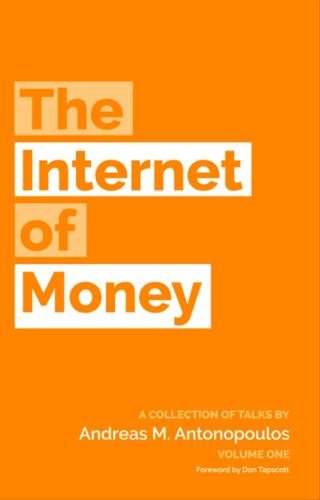
The Internet of Money
by
Andreas M. Antonopoulos
Published 28 Aug 2016
You’re not ready for that. Please open your phone and display your QR code. You’re like, “What? What’s a QR code? . . . Hang on, let me go to Google Play and search for ‘QR code.’ There’s an app that scans them, . . . maybe I should use that one. Shouldn’t use that one. Maybe I should use a bitcoin wallet. Oh, there are 26 of them. Which one’s the best? I don’t know. I’ll use Circle. . . . Oh, that requires a pre-existing relationship, whoops. I’ll use Coinbase. . . . Oh, that requires a pre-existing relationship, oops. . . .” Finally, I’ve got my wallet and I display the QR code, put some money in, and I’ve got the bitcoin.

Doppelganger: A Trip Into the Mirror World
by
Naomi Klein
Published 11 Sep 2023
But how, you might well ask, could this gruesome dystopia be ushered in via one vaccination app? Easy, Wolf explained. All it took was “a tweak of the back end.” To be clear, once again: this is not true. Scanning a QR code to get into a restaurant or a stadium does not also allow the government to listen to the conversations you have at that restaurant, as Wolf claimed. When it is not being scanned (which is most of the time), a QR code also does not have the power to “geolocate you”; neither can it find you in your home. It does not know your search history, is not linked to PayPal, and cannot turn your life on and off. It is not a social credit system, and it has nothing to do with what IBM did in Nazi Germany.
…
In what she described as her “most serious warning” to date, Wolf said the apps were actually a backdoor attempt to usher in a “CCP-style social credit score system”—a reference to China’s all-pervasive surveillance net that allows Beijing to rank citizens for their perceived virtue and obedience, a chilling hierarchy that can determine everything from access to schools to eligibility for loans, and is one piece of a broader surveillance dragnet that pinpoints the location of dissidents for arrest and ruthlessly censors speech that casts the ruling party in a critical light. The vaccine app was like all that, Wolf said, a system that “enslaves a billion people.” She explained that the vaccination-status QR codes that would be scanned to gain access to restaurants, theaters, and the like would not merely give health authorities data on a person’s presence in these indoor venues. They would also allow a “tyrannical” state to know who you were gathering with and what you were talking about—not only in those restaurants where the code had been scanned but also, she claimed, inexplicably, in your own living room: “If you’re talking about staging a protest or writing an op ed or mobilizing support for a representative to pass a bill to roll back this system, the platform will know.”
…
(As doppelgangers teach us, walling off that which is inherently connected rarely ends well.) There were also social costs inside wealthy countries to placing so much of the virus-control strategy on vaccinations and verification apps. Whenever access to spaces and services requires a smartphone and QR codes, it further marginalizes those who are unhoused and otherwise vulnerable and are less likely to have access to those tools—“the viral underclass,” as the author Steven W. Thrasher has described the already marginalized groups who are treated as disposable during times of pandemic. These are difficult and important debates to have, alongside an honest reckoning with the brutal histories that underlie mistrust toward government-mandated health programs among many Black, Indigenous, Puerto Rican, and disabled people.

The Age of Cryptocurrency: How Bitcoin and Digital Money Are Challenging the Global Economic Order
by
Paul Vigna
and
Michael J. Casey
Published 27 Jan 2015
D.C. lobbying firm Peck Madigan Jones to lobby Congress: Olga Kharif and Elizabeth Dexheimer, “MasterCard Lobbyist Adds Bitcoin to List of Topics,” Bloomberg, April 30, 2014, http://www.bloomberg.com/news/2014-04-30/mastercard-lobbyist-adds-bitcoin-to-list-of-topics.html. Jason Oxman, the CEO: Jason Oxman, interviewed by Michael J. Casey, June 24, 2014. supports payments at retail outlets via QR codes: Donna Tam, “PayPal Offers QR Codes Retail-Store Purchases,” CNET, October 8, 2013, http://www.cnet.com/news/paypal-offers-qr-codes-for-retail-store-purchases/. Facebook is widely believed to be working: Samuel Gibbs, “Facebook Prepares to Launch e-Money Transfer Service in Europe,” Guardian, April 14, 2014, http://www.theguardian.com/technology/2014/apr/14/facebook-e-money-transfer-service-europe.
…
As the owner of such an address, you are free to share it with outsiders and invite them to make a deposit there. But only you have the power to make a withdrawal, which you can do with the aid of a wallet. Here’s how you might carry that out: You could open a smartphone app that’s linked to your online wallet and then use its built-in QR code-scanner to import a merchant’s address into the “To” line of a transaction window. You would then type in the desired payment amount and hit “Send,” thereby instructing the wallet software to find a sufficient bitcoin balance in one or more of your preexisting addresses and send that balance to the merchant.* To do this, the wallet program accesses an embedded passcode that’s known as the private key; each private key is uniquely associated with one address.
…
When paired with “smart property”—where deeds, titles, and other certifications of ownership are put in digital form to be acted upon by software—these contracts allow the automatic transfer of ownership of a physical asset such as a house or a car, or an intangible asset, such as a patent. Similarly, the software initiates the transfer when contractual obligations are met. With companies now busily putting bar codes, QR codes, microchips, and Bluetooth antennae on just about every gadget and piece of merchandise, the emerging “Internet of Things” should make it possible to transfer ownership in many kinds of physical property in this manner. One creative solution applies to cars purchased on credit. Right now, if an automobile owner misses his or her payments, it’s laborious and costly for the finance company to reclaim both the title to and physical possession of the car, involving lawyers, collection agencies, and, in worst cases, repo men.
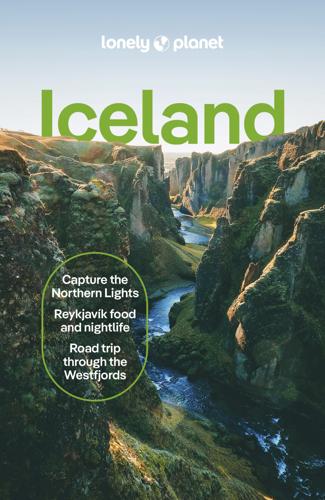
Lonely Planet Iceland
by
Lonely Planet
. €€ TOP SIGHT Silfra Fissure This water-filled crack between the North American and Eurasian tectonic plates is the only place in the world where you can swim between continents. The crystal-clear water here flows from the Langjökull glacier, winding through porous lava rock for decades before emerging here. The name ‘Silfra’ means silvery. VICPHOTORIA/SHUTTERSTOCK © Scan this QR code to book snorkelling and diving tours DON’T MISS Silfra Big Crack – deep, expansive canyons Silfra Hall – towering rock formations Silfra Cathedral – otherworldly deep blue water Silfra Lagoon – lagoon with a view Dive Between Continents Silfra is a diving destination that tops many travellers’ bucket lists.
…
It’s surrounded by a UNESCO World Heritage geopark that accounts for nearly 10% of the land in Iceland. Katla makes it clear that Iceland truly is a land of fire and ice. Katla’s last major eruption was in 1918. That eruption lasted 24 days, fortunately without loss of life. Fjaðrárgljúfur canyon | MUMEMORIES/GETTY IMAGES © Scan this QR code for more information on Katla Geopark. Journey into an Ice Cave Head underground and into the Katla Ice Cave to see black ash from centuries of eruptions encased in ice. Notice the older blue ice layers and trapped air bubbles as you move through this space underneath an offshoot of Iceland’s fourth-largest glacier.
…
When you can not only admire the wondrous glinting ice sculptures in the lagoon and on the beach – some of them striped with vivid ash layers from volcanic eruptions – and scout for seals, but also take a thrilling lagoon boat trip. Amphibious tour, Jökulsárlón | FEDERICO NERI/SHUTTERSTOCK © Scan this QR code for parking rates at the lagoon and trail maps. On the Water In summer, the lagoon is a hub for boat tours and some kayaking – a chance to get out among the bergs. Check in 30 minutes before to avoid missing the boat (as it were). Amphibious Boat Tours Take a memorable 40-minute trip with Glacier Lagoon (icelagoon.is) in an amphibious boat, which trundles along the shore like a bus before driving into the water.
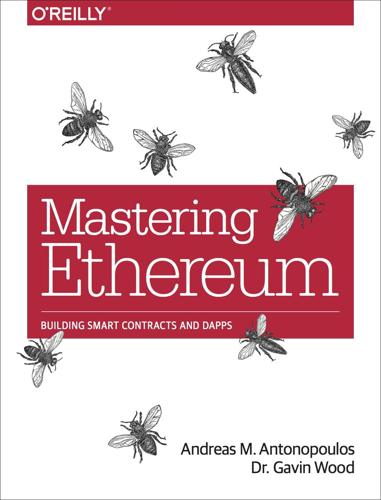
Mastering Ethereum: Building Smart Contracts and DApps
by
Andreas M. Antonopoulos
and
Gavin Wood Ph. D.
Published 23 Dec 2018
Figure 6-7 shows the process: Create an unsigned transaction on the online computer where the current state of the account, notably the current nonce and funds available, can be retrieved. Transfer the unsigned transaction to an “air-gapped” offline device for transaction signing, e.g., via a QR code or USB flash drive. Transmit the signed transaction (back) to an online device for broadcast on the Ethereum blockchain, e.g., via QR code or USB flash drive. Figure 6-7. Offline signing of Ethereum transactions Depending on the level of security you need, your “offline signing” computer can have varying degrees of separation from the online computer, ranging from an isolated and firewalled subnet (online but segregated) to a completely offline system known as an air-gapped system.
…
The authors do not endorse any of the companies or products mentioned. We have not tested the operation or security of any of the products, projects, or code segments shown in this book. Use them at your own risk! Ethereum Addresses and Transactions in this Book The Ethereum addresses, transactions, keys, QR codes, and blockchain data used in this book are, for the most part, real. That means you can browse the blockchain, look at the transactions offered as examples, retrieve them with your own scripts or programs, etc. However, note that the private keys used to construct the addresses printed in this book have been “burned.”
…
Offline signing of Ethereum transactions Depending on the level of security you need, your “offline signing” computer can have varying degrees of separation from the online computer, ranging from an isolated and firewalled subnet (online but segregated) to a completely offline system known as an air-gapped system. In an air-gapped system there is no network connectivity at all — the computer is separated from the online environment by a gap of “air.” To sign transactions you transfer them to and from the air-gapped computer using data storage media or (better) a webcam and QR code. Of course, this means you must manually transfer every transaction you want signed, and this doesn’t scale. While not many environments can utilize a fully air-gapped system, even a small degree of isolation has significant security benefits. For example, an isolated subnet with a firewall that only allows a message-queue protocol through can offer a much-reduced attack surface and much higher security than signing on the online system.

Blockchain Chicken Farm: And Other Stories of Tech in China's Countryside
by
Xiaowei Wang
Published 12 Oct 2020
Jiang shows us around the rest of the farm—several pristine feeding areas, and the “control” room where the base station sits. Each chicken wears an ankle bracelet that is physically tamperproof, which tracks characteristics such as number of steps taken and the location of the chicken. A chicken Fitbit of sorts. The front plate of the ankle bracelet has a QR code on it. All this data is viewable on a website accessible with a password, and the website includes constantly streaming surveillance footage of the chickens to ensure that they have not been adulterated in any way by an intruder. There’s also a map of the chickens’ movements. Data about the chickens is uploaded via the base station to Anlink, a proprietary enterprise blockchain that is an experiment by the sprawling ZhongAn, an online-only insurance company.
…
In addition to wearing the ankle bracelets, the chickens are tested every two weeks by the local branch of the Ministry of Agriculture for any signs of antibiotic usage, which is illegal under the category of free-range. While it may seem like overkill, it might be a small price to pay in order to win back public trust. These chickens are delivered to consumers’ doors, butchered and vacuum sealed, with the ankle bracelet still attached, so customers can scan the QR code before preparing the chicken. Scanning this code leads them to a page with details about the chicken’s life, including its weight, the number of steps it took, and its photograph. In Shanghai, these details are seen as a sign of authenticity and food safety, while in the United States they could easily be read from an animal-welfare angle.
…
But for hundreds of thousands of pigs, where do you even begin? And in order for China to achieve its pork miracle, millions of pigs must be farmed. Aliyun offers a way to help sort through data using AI. In these large-scale farms, pigs are stamped with a unique identity mark on their bodies, similar to a QR code. That data is fed into a model made by Alibaba, and the model has the information it needs to monitor the pigs in real time, using video, temperature, and sound sensors. It’s through these channels that the model detects any sudden signs of fever or disease, or if pigs are crushing one another in their pens.

Actionable Gamification: Beyond Points, Badges and Leaderboards
by
Yu-Kai Chou
Published 13 Apr 2015
When the sun reaches its greatest height at noon, the shadow of this statue suddenly transforms into a perfect QR Code where people can scan with their mobile phones and see unique content. Isn’t that cool? Because the QR Code can only be scanned within a limited window between 12PM to 1PM, people are now rushing to get there in time. Honestly, at that point, it doesn’t matter what the QR Code is about – the scarcity and intrigue (stemming from Core Drive 7: Unpredictability & Curiosity) is enough to get people to show up. In the case of eMart, the QR code links to a coupon that consumers can redeem immediately for a purchase online.
…
.↩ Kevin Johnson. Wikia Farmville. URL: http://farmville.wikia.com/wiki/File:Farmville-mona-lisa-by-kevin-johnson-300x186.png↩ Jenny Ng. Games.com Blog. “FarmVille Pic of the Day: Embrace of Swan Lake at Liveloula46’s farm.” 03/01/2012.↩ Amy-Mae Elliott. Mashable.com. “15 Beautiful and Creative QR Code”. 11/7/23.↩ Wikipedia Entry “Minecraft”: http://en.wikipedia.org/wiki/Minecraft↩ Raph Koster. A Theory of Fun. 2nd Edition. p122. O’Reilly Media. Sebastopol, CA. 10/2013. ↩ Chapter 8: The Fourth Core Drive - Ownership & Possession Ownership & Possession is the fourth Core Drive in Octalysis Gamification.
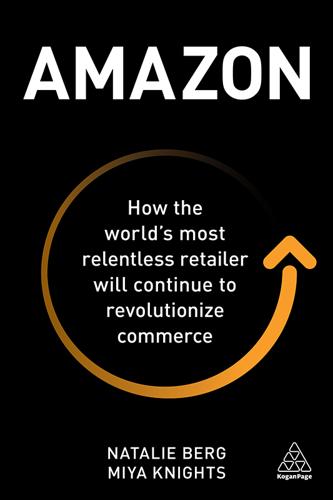
Amazon: How the World’s Most Relentless Retailer Will Continue to Revolutionize Commerce
by
Natalie Berg
and
Miya Knights
Published 28 Jan 2019
It would go on to launch new grocery formats such as AmazonFresh Pickup and Amazon Go, which we’ll discuss in the coming chapters, while also partnering with existing bricks and mortar retailers such as Kohl’s, Best Buy and less well-known examples like mattress start-up Tuft & Needle. Tuft & Needle – another retailer that started life online – has worked with Amazon to enhance the customer experience as it moves further into physical retailing. Its Seattle store features tablets for shoppers to read product reviews on Amazon, Echo devices to answer customer questions and QR codes that allow for one-click purchasing through the Amazon app. Daehee Park, Tuft & Needle’s co-founder, said that after much debate about how to go head-to-head with Amazon, they decided to go in the exact opposite direction. ‘We’ve decided, why not just embrace them? It is the future of retail and e-commerce… We focus on what we’re good at and plug in Amazon technology for the rest.’44 This could be a model for other brands that are already reliant on Amazon for online sales (Tuft & Needle generates around 25 per cent of its sales through Amazon).45 Similarly, we believe that Amazon will look to forge more retail partnerships as a means of addressing the ticking time bomb that is online returns.
…
An ESL can drive further positive engagement by offering more detailed pricing, origin and allergy information, etc than is possible to display on a traditional shelf-edge label. Some retailers have already deployed large-sized ESLs for their capacity to present more information, accompanied with QR codes that direct customers to more information online. European home improvement retailer Leroy-Merlin deployed ESLs to solve the accuracy, productivity and pricing velocity challenges already associated with paper-based labels. But it also used its ESLs to offer customers automatic and real-time geolocation of products inside the store.
…
The retrieval of goods and cleaning of tables is done solely by robotic arms attached to the appliances. Other unmanned prototypes include Auchan China’s Minute and BingoBox stores and the self-driving Wheelys MobyMart, which rely on the customer using an app to access the store and pay for goods by scanning QR codes, or computer vision that debits the customer’s account on exit. There’s also the 7-Eleven Signature concept in South Korea. These rivals to Amazon are setting the standard, but it is unlikely we will see the store of the future dominated by unmanned, robot-run boxes. The high cost of the technology involved limits them to small-footprint, convenience formats, and the human touch will always be most prized in sectors that require more consultative sales.

Mapmatics: How We Navigate the World Through Numbers
by
Paulina Rowinska
Published 5 Jun 2024
receive satellite pictures from Mars: María Chara, ‘An Introduction to Error Correcting Codes’, Mini Course 4, Mathematics sin Fronteras, Brown University, Lecture Notes 1, 12 May 2021, https://www.dam.brown.edu/MSF/Archives/Spring2021/notes/Course4Lecture1.pdf. comparing DNA strings: Joseph Malkevitch, ‘Mathematics and the Genome: part 5. Near and Far (Strings)’, Feature Column, American Mathematical Society, April 2002, https://www.ams.org/publicoutreach/feature-column/fcarc-genome5. use QR codes: Wouter Boot, ‘QR Codes: What You Didn’t Know’, Acolad Group blog, 18 January 2022, https://blog.acolad.com/qr-codes-what-you-didnt-know#:~:text=Each%20QR%20code%20has%20one,%25%2C%20level%20H%2030%25. constitute a positioning system in the brain: ‘The Nobel Prize in Physiology or Medicine 2014’, The Nobel Prize, 28 December 2013, https://www.nobelprize.org/prizes/medicine/2014/summary/.
…
Golay, who independently generalized Hamming’s error-correcting codes. This resulted in a decades-long priority controversy. Given the impact of error-correcting codes and abstract distances on our lives – for example, they let us receive satellite pictures from Mars, identify genetically related organisms by comparing DNA strings and use QR codes – the authorship was worth fighting for. It might seem that by defining metric spaces, mathematicians complicated the intuitive, map-inspired notion of distance. However, as we’ll see next, these abstract, theoretical distances are still simpler to understand than the distances we keep – quite literally – in our minds.
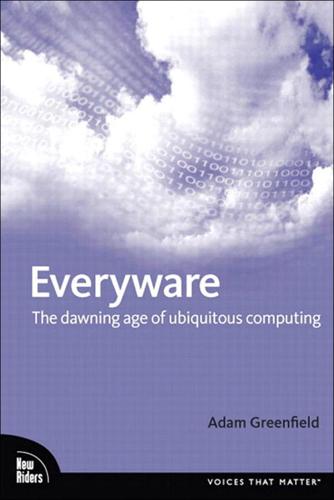
Everyware: The Dawning Age of Ubiquitous Computing
by
Adam Greenfield
Published 14 Sep 2006
Semacode stickers have been cleverly employed in this role in the Big Games designed by the New York City creative partnership area/code, where they function as markers of buried treasure, in a real-time playfield that encompasses an entire urban area—but what 2D coding looks like in daily practice can perhaps best be seen in Japan, where the QR code has been adopted as a de facto national standard. QR codes can be found anywhere and everywhere in contemporary Japan: in a product catalogue, in the corner of a magazine ad, on the back of a business card. Snap a picture of one with the camera built into your phone—and almost all Japanese keitai are cameraphones—and the phone's browser will take you to the URL it encodes and whatever information waits there.
…
This is a country where, more so than just about anywhere else, people plan gatherings, devise optimal commutes, and are advised of the closest retailers via the intercession of their phones. Given the facts on the ground, Japanese developers wisely decided to concentrate on the ubiquitous delivery of services via keitai—for example, the RFID-tagged streetlamps of Shinjuku already discussed, or the QR codes we'll be getting to shortly. And as both phones themselves and the array of services available for them become more useful and easier to use, we approach something recognizable as the threshold of everyware. This is a culture that has already made the transition to a regime of ambient informatics—as long, that is, as you have a phone.
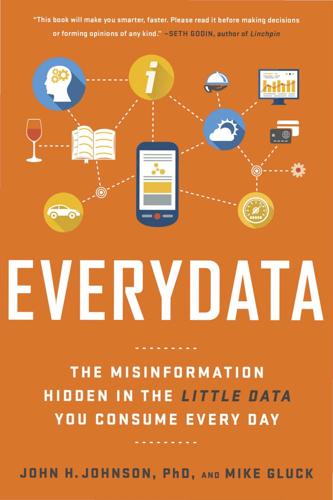
Everydata: The Misinformation Hidden in the Little Data You Consume Every Day
by
John H. Johnson
Published 27 Apr 2016
In his Ad Contrarian blog, Bob Hoffman wrote about an oft-repeated statistic that 60 percent of people say they use QR (quick response) codes.22 “This statistic was obviously total bullshit,” noted Hoffman, “and yet serious people seemed to be taking it seriously. Anyone who spent any time in the real world could see that no one was using QR codes.”23 So where did the 60 percent come from? Perhaps, as Hoffman theorizes, this was the percentage of people who have ever used a QR code. In framing the data without context, Hoffman notes that, “a truth is technically being told, but reality is being radically misrepresented.” Here’s the lesson—if you take data at face value, you may not be getting the full story.
…
Last Week Tonight with John Oliver, Episode 3: “Climate Change Debate,” Last Week Tonight video, 4:27, HBO, May 11, 2014, http://www.hbo.com/last-week-tonight-with-john-oliver/episodes/01/03-may-11-2014/video/climate-change-debate.html?autoplay=true. 21. Bryan Beverly, “3 Old Tricks for the Analytics Hall of Shame,” All Analytics website, November 25, 2013, http://www.allanalytics.com/author.asp?section_id=1828&doc_id=269454&f_src=allanalytics_sitedefault&utm_source=dlvr.it&utm_medium=twitter. 22. A quick response (QR) code is a type of bar code that users can scan using their smartphones to get video and other content. 23. Bob Hoffman, “How Marketers Lie to Themselves,” Ad Contrarian blog, April 20, 2015, http://adcontrarian.blogspot.com/2015/04/how-marketers-lie-to-themselves.html. 24. John Stossel, “Running on Empty,” ABC News website, June 5, 2008, http://abcnews.go.com/2020/Stossel/story?

Number Go Up: Inside Crypto's Wild Rise and Staggering Fall
by
Zeke Faux
Published 11 Sep 2023
She seemed embarrassed to be there and called the attendees nerds. “I don’t know what NFT stands for,” she said. “I’m assuming it’s, looking out, not fucking tonight, is that correct? Do I have that right?” I’d been warned that anyone I met might be trying to steal my ape. NFT collectors told me not to download any apps or scan any QR codes. I’d heard a rumor about an ape-stealing QR code on a billboard in Times Square. The best way to store my ape, I was told, was to transfer it to an encrypted thumb drive. This sounded tricky. I didn’t want to screw it up and accidentally lose Dr. Scum forever. Instead I left him in the fox head on my computer and turned it off.
…
They seemed a little too excited by the idea that there was finally a store or two where tourists could use their Bitcoins to buy regular stuff. “Okay, guys, we are about to order here at Minutas Mario, and we can pay with Bitcoin,” a German Bitcoin YouTuber said in a video I found. Standing at a rusty-wheeled pushcart, he got a minuta—a fruit-flavored shaved ice—and spent more than three minutes scanning QR codes to transfer 13,418 hundred-millionths of a Bitcoin (about five dollars at the time) to the vendor’s digital wallet. El Zonte proved to be a genuinely beautiful but tiny tourist town about an hour south of the capital, where I saw chickens hopping down rutted dirt roads, and residents living in corrugated-metal shacks next to hotels for foreign surfers.
…
He pulled up his shirt to reveal a V-shaped scar and a bruise. Other prisoners fared worse—he recalled seeing five inmates die. “They arrested half the world so they could have a number and say, ‘We arrested so many people,’ regardless of whether the person committed any crime,” García said. He asked if I could share the QR code on his sign, in hopes of getting donations so he could pay his electric bill and bank loans. But when I went to buy shaved ice using Bitcoin myself, the code didn’t work. * * * — TETHER’S LISTED ADDRESS in El Salvador proved to be an office tower in San Salvador housing a law firm that I wasn’t permitted to enter.
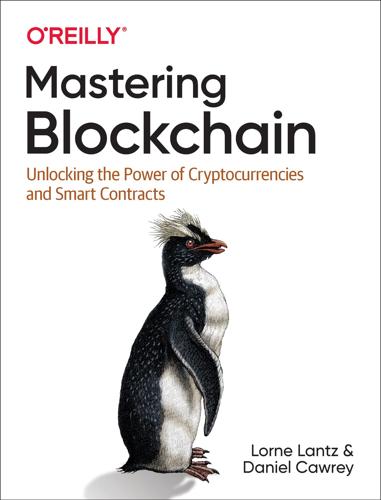
Mastering Blockchain: Unlocking the Power of Cryptocurrencies and Smart Contracts
by
Lorne Lantz
and
Daniel Cawrey
Published 8 Dec 2020
Identification services like Keybase and Blockstack make it easier for users to maintain private keys for different types of Web 3.0 services, covered later in this chapter. Naming Services Public keys are much more difficult to use than email addresses, usernames, or other identifiers, yet they are very important to decentralized services. Figure 7-1 shows examples of public and private keys. The QR codes are representations of the keys. Figure 7-1. Public and private keys Naming services allow users to have names that are much more easily read and typed than complex public keys are. An example is the Ethereum Naming Service, which allows people to use a <username>.eth naming convention that translates to a public key.
…
Bloomberg TV BTC Stolen In 2013, Bloomberg TV reporter Matt Miller demonstrated some basics of bitcoin on-air. He gave other hosts $20 worth of bitcoin in paper wallets. One of the hosts, Adam Johnson, proceeded to open the paper wallet on live television, displaying its private key for about 10 seconds. A viewer named “milkywaymasta” was able to scan the private key’s QR code and stole the funds. As a lesson in key security, milkywaymasta promised to return the $20 if Johnson created a new wallet, since the old one could be “sweeped” because the private key had been shared publicly. EtherDelta Redirection In 2017, hackers were able to obtain personal information on the dark web about decentralized exchange EtherDelta’s operator, Zachary Coburn.
…
Many crypto exchanges send an SMS as the second-factor authentication (2FA), but the hacker has already compromised the user’s phone. Access all documents in Google Drive. This might include private keys and sensitive business documents. Access all photos in Google Photos. This might include QR codes of private keys, Google Authenticator keys, or even compromising photos that could be used for extortion. Access the target’s passwords via chrome://settings/passwords, if the target is using Chrome’s built-in password manager. Get the target’s entire contact list, which likely includes the phone numbers of many others in the blockchain industry.

Inside the Nudge Unit: How Small Changes Can Make a Big Difference
by
David Halpern
Published 26 Aug 2015
As a result of a new consumer power pushed by BIT, energy companies were required to make it easier for customers to access information. In particular, they were required to print on bills a QR code that summarised the customers’ details, patterns of use and their current tariff (see Figure 26). In technical terms, this makes the customers’ data machine-readable. In everyday terms, it means that all customers need to do to save some money is to scan the QR code with their mobile phone, and a switching site app can search the market for the best tariff for them. Instead of switching being a task that would take a few hours, it can be done in a few seconds.
…
Until recently, the UK’s main six energy suppliers had more than 500 tariffs between them. For mobile phones, where there is a choice of networks, tariffs and handsets, the choices facing consumers run into the millions. These vast numbers make it very hard for a consumer to figure out what is the best choice for them. Figure 26. A stylised illustration of how having QR codes on bills makes switching easier. This illustration, together with an early prototype developed by one of the switching sites, was shown to Ministers in 2012 and helped make the case to wider, behaviourally based changes in the regulation of consumer markets in the UK and beyond. In a classic economic view, this shouldn’t much matter.
…
Several of the big energy companies, despite growing public frustration about how their prices seemed to ‘go up like a rocket and down like a feather’, continued to drag their feet. Some moved to make consumers’ data possible to download, but still rather difficult. As illustrated in Chapter 3, every extra friction can have a big impact. In the end, the PM’s patience snapped. We introduced a requirement for the big companies to print the data as QR codes on bills, and drove for common application program interfaces (APIs) to enable consumers, with the help of switching sites, to compare and switch more easily. This also opens the door to enable consumers to opt for ‘auto-switching’, so that a site can check the market for the best tariff automatically when their contract ends and switch if a better deal is found.
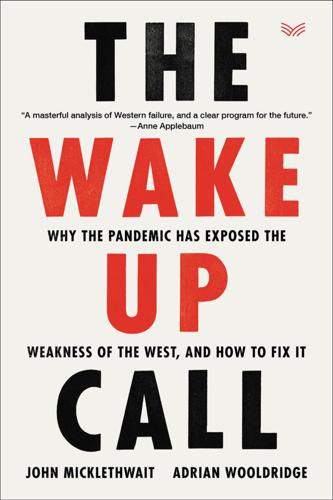
The Wake-Up Call: Why the Pandemic Has Exposed the Weakness of the West, and How to Fix It
by
John Micklethwait
and
Adrian Wooldridge
Published 1 Sep 2020
In Singapore, water pipes report back to the authorities if they spring a leak, while lampposts gather data on temperature, humidity, and traffic flow. Some American states are getting better at communicating with people through mobile phones and apps: but again, Covid underlined how far ahead East Asia is. In Shanghai, each subway car has its own QR code (or bar code) that you scan when you get on, so that if one of the passengers gets sick, only people who have traveled in that particular car need to be contacted.17 Of course there are privacy concerns with this, but the main barrier to this happening in America is technological. The New York subway system only started introducing Asian-style cashless payments in 2019.
…
Press, 2020), 4. 14.David Himmelstein, Terry Campbell, and Steffie Woodhandler, “Health Care Administrative Costs in the United States and Canada, 2017,” Annals of Internal Medicine, January 21, 2020. 15.OECD, PISA results for 2018, released December 3, 2019; https://www.oecd.org/pisa/publications/pisa-2018-results.htm. 16.Department of Health and Human Services, “Strategic Objective 5.3: Optimize Information Technology Investments to Improve Process Efficiency and Enable Innovation to Advance Program Mission Goals,” February 25, 2019, https://bit.ly/2WLdL8W. 17.“Shanghai Introduces QR Codes on Subway to Track Potential Contact with Coronavirus,” South China Morning Post, February 28, 2020. 18.Aditi Kumar and Eric Rosenbach, “Could China’s Digital Currency Unseat the Dollar?” Foreign Affairs, May 20, 2020. 19.Bloomberg: The Huawei barometer graphic. CONCLUSION: MAKING GOVERNMENT GREAT AGAIN 1.Daniel P.

Before Babylon, Beyond Bitcoin: From Money That We Understand to Money That Understands Us (Perspectives)
by
David Birch
Published 14 Jun 2017
It is in large part thanks to WeChat that Chinese consumers can navigate their day with no banknotes or bank cards (Economist 2016). Both companies have built payments businesses into their ecosystems. In 2016 Alipay handled $1.7 trillion in payments and WeChat handled $1.2 trillion. That’s nearly $3 trillion a year in mobile payments, fed by the simple and widespread use of QR codes. As an aside, the telcos are hoping that ‘new’ technology will bring them back into the game. China Mobile, the country’s biggest carrier, is focusing on NFC, but I suspect that Bluetooth, WiFi and other technologies will come along too. The ‘last millimetre’ problem is fading. Chinese e-payment volumes, 2Q16.
…
Meanwhile, as shown in figure 29, banks are not doing too well out of the mobile-centric electronic payments revolution in China. The country provides a window into the ‘cardmageddon’ (the time at which cards will cease to dominate non-cash retail payments by volume) that is approaching in developed markets. Since Chinese consumers switched to using those third-party QR code services, the banks lost something in the region of $20 billion in fees income in 2015 (Wildau 2016). If you think about it, though, there’s a much bigger problem looming. It’s one thing for banks to lose interchange income (they are losing that anyway because of the downward pressure on interchange everywhere), but hey, it’s only money.
…
To my surprise and delight the clerk told me that they did not accept cash after 7 pm and that it was cards only, so I bought a large chocolate bar as well to reward the store for their forward-thinking policy. There was not a single shop, restaurant, taxi or fast-food joint that I visited on my trip that needed cash. I saw plenty of contactless terminals and even a couple of vending machines that accepted mobile payments, contactless cards and (bizarrely) coins. I wanted to give a local QR code payment service, QuickTap, a try as well because it looked quite interesting but when I tried to download the app nothing happened. Maybe you have to be logged in to the NZ iTunes store or something ridiculous like that. Anyway, now that banks and the mobile operators have got together to launch an NFC service, I’ll use that instead.

Bit by Bit: How P2P Is Freeing the World
by
Jeffrey Tucker
Published 7 Jan 2015
And yet, you don’t have to resort to complicated monetary theory in order to understand the sense of alarm surrounding bitcoin. Many people, as I did, just have a feeling of uneasiness about a money that has no basis in anything physical. Sure, you can print out a bitcoin on a piece of paper, but having a paper with a QR code or a public key is not enough to relieve that sense of unease. How can we resolve this problem? In my own mind, I toyed with the issue for more than a year. It puzzled me. I wondered if Mises’s insight applied only in a predigital age. I followed the speculations online that the value of bitcoin would be zero but for the national currencies into which it is converted.
…
But then you have to get an email address, and you have to pay some fairly high fees, and the service isn’t really set up for casual friend-to-friend payments. It can happen but not without some difficulty. The other night I was out with friends at a bitcoin conference. At this event, most everyone had a bitcoin wallet. When the check came, it was super easy and wonderfully fun to split. You hold up your phone, scan the QR code from another phone or allow your code to be scanned, and send or receive whatever amounts are necessary to pay what you need to pay. The process is a delight. This works even if the establishment doesn’t accept bitcoin. One person accepts the bill and everyone else pays via bitcoin. No more excuses about lacking cash or promises to pay later.

Pirate Cinema
by
Cory Doctorow
Published 2 Oct 2012
I didn't know what was going on with my zeroed-out mates, but I was surely hoping that they got it sorted quickly. I texted another "1" to the projector crew and held my breath. Then I let it go in a whoosh as the opening frames of my beautiful, wonderful, perfect video started rolling on the crenelated walls of the Commons. We'd superimposed a QR code on the top right corner of the frame, and it rotated every ten seconds; each 2D barcode translated into the URL of a different mirror of the video with the embedded TheyWorkForYou stats. The little battery-powered video player plugged into the projector was programmed to roll the video, wait a random interval between ten and two hundred seconds, then roll it again.
…
The crowd that had gathered had already started to disperse, but we could see it was in the hundreds. More importantly, when I powered up my own mobile and looked at the server logs for our video landing pages, I could see that we'd got fifteen thousand views in the past ten minutes -- as people picked up the QR code and sent them around to their mates, and so on -- and this was accelerating. Now the mission phone buzzed again. It was the rooftop, also transmitting 1. I wondered what was happening to Rob in the garage. As it turned out, he was being arrested. Having dropped the reflector and smashed it to flinders, Rob found himself without much to do.
…
When Hester and Lenny sidled up alongside of us with their sheepish grins, we knew we weren't the only ones who lacked the discipline of hardcore urban paramilitary guerrillas. This was our greatest opening ever, and we wanted to be there. Luckily, there was a damn huge crowd to get lost in. Westminster Bridge was well rammed with gawpers, staring at the looping video on the side of Parliament, holding up their phones to video it or get the QR code and visit the site. "How'd you go, then?" Hester said, her eyes shining. "I think we did all right," I said. "Brilliantly," 26 confirmed. "How about you?" Hester assumed a mien of absolute nonchalance. "Nothing too collywobbly," she said. "Bit of running around, though, yeah?" She gestured at Lenny.
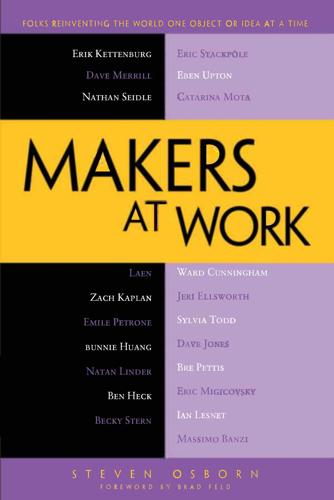
Makers at Work: Folks Reinventing the World One Object or Idea at a Time
by
Steven Osborn
Published 17 Sep 2013
So, yeah, if we can democratize that, it would be terrific. We’ve just started. Osborn: Tell me a bit about the Form I from the hacker’s perspective. Linder: I’m running the betas for the Form 1. There’s a guy using it to do 3D markers. You know, think about a QR code. Think about the 3D version of the QR code on a physical object. Imagine an elephant model, and that elephant has also a 3D QR code embedded into it. When you scan it with a camera, you can get some information and that information can come from three dimensions when you’re scanning the object, for example. There was another guy who is building a new type of—think about the Sifteo Cubes, but he’s only building it with a cube, literally a cube, six displays, six sides of a cube.
…
China manufacturing Wi-Fi module Xbox hack Human vision system I IEEE1901 Innovation Center Interactive Telecommunications Program (ITP) J Jones, Dave Amp Hour radio back and reshooting things big channels blowing stuff up brown Noctua building stuff “build your own oscilloscope” comment approved complex algorithm constant pressure EE degree electronics design engineer electronics hobbyists electronics magazines entertainment enthusiastic approach formal study fundamental principle/circuit building block “Fundamentals Friday” videos hacker/maker movement hardware high-end video ironic nature learn fundamentals magazine snail mail world mailbag marketing books microchip money and success niche audience open-source hardware passionate people PCB and screen photonicinduction physically holding and playing podcast pop-out things practical aspect project construction “Publish and be damned” redundant/retrenched regular segments spreading study electronics test equipment troubleshooting video blog-type video quality Wireless Weekly WordPress and text blogs work pattern worthwhile producing YouTube Google search engine K Kalanithi, Jeevan Kaplan, Zach Amazon CAD and CAM package Chicago Public Library commercial success consulting business content management system digital fabrication 3D printers Erector sets hardware store industrial revolution Innovation Center internship LEGOs Lever Works mechatronics personal manufacturing pilot program Pumping Station research subscription Shapeoko textiles third industrial revolution transaction Kettenburg, Erik Arduino community ATtinies command-line program Digispark community forward-reaching approach full Spectrum 40-watt hobby laser Kickstarter projects lightbulb moment maker community maker culture open-source community parallel computing project prototype build up Radio Shack surface-mount assembly shop Tesla coil unexpected challenges Vacasa Rentals (company) web developer Wi-Fi modules WordPress Kickstarter Kraftwerk video L Legal defense fund Lesnet, Ian Bus Pirate camera system community cost down crimping tool dangerous prototypes DIY Life electronics life electronics market entrepreneur and electrical engineer fapiao founder garage manufacturing line Hack a Day hardware environment hardware products hex standoffs JTAG debugger Maker Faire Mouser order open-hardware electronics projects open hardware retailers open-hardware shop open-source vision system PCB manufacturers pick-and-place machine pre-crimped wires Shapeoko CNC mill Shenzhen vision system wireless sensor networks Linder, Natan Brooks, Rodney (chairman and CTO of iRobot) CNC machine 3D and CAD design design-for-manufacturing 3D printer projects 3D printing landscape 3D QR code entrepreneurship filament-deposition method flexible-display technology Fluid Interfaces Group Form 1 Google glasses Jerusalem Venture Partners Kickstarter experience microfluidics MIT media lab one-click print OpenRC projector camera systems prosumers Samsung people Sinclair ZX81 PC SketchUp stopwatch application Sun Microsystems Logo programming language Luna-Tik M MakerBot MakerCAM.com Maker Faire Making Wireless Toys Marine Advanced Technology Education (MATE) MediaLab Prado RepRap team Merrill, David Arduino-compatible board BASIC Stamp computer science, majoring in digital photos e-mails entertainment and photography exploded-parts diagram hardware hardware products human vision system implementation inspiration interactive art installations interfaces Internet introductory programming iPhone LEGOs Logo programming language miniature steam engine MIT Media Lab musical instruments personal history physical manufacturing “physical Photoshop” physics programming prototype product role model roller coaster Siftables sketching and building software Symbolic Systems talk and the demos TED talk videogames video segments Microsoft Microsoft Xbox Migicovsky, Eric advice apps for InPulse challenges childhood economy of hardware company key successes Kickstarter experience learned lessons profile SDK for InPulse smartwatch software development Moore, Geoffrey Mota, Catarina altLab business models conductive ink digital fabrication 3D printer education electrical engineering electronics/programming Expancel graduate program human-level goal intellectual property interactive television and audiovisual systems Internet ITP media and physical goods Media Lab NYC Resistor object-oriented programming open-source approach open-source businesses open-source hardware open-source projects PhD programs Portuguese hackerspaces project proposal scientific theory social sciences Tech Crafts TED conferences TED Fellows Program Tisch School trial-and-error process video and filmmaking Motorola N NASA National Oceanic and Atmospheric Administration (NOAA) Neal, James (Laen) Adafruit learning system art project BatchPCB board designs 3D printers education electricity electronics education e-mails flux capacitor GPS Halloween-themed project Internet “maker movement” MAKE videos Nuvoton OSH Park PCB Order personal prototyping abilities production quality profit margin smartphone software SparkFun library UNIX system Nightline O Oomlout company Open Hardware Summit OpenMaterials.org.
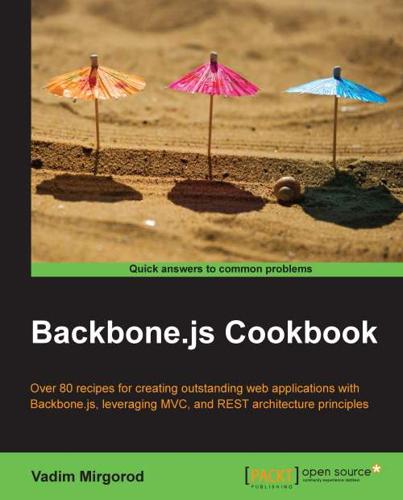
Backbone.js Cookbook
by
Vadim Mirgorod
Published 25 Aug 2013
After the project is pulled out from the GitHub repository, click on the Ready to Build button, which launches the building process for multiple platforms. To build an application for iOS or Blackberry, you are required to enter a developer's key. 235 Special Techniques 8. Now, the project is ready to be downloaded. You can do it by scanning the QR code on a mobile device. The QR code contains a link to your application. However, for many platforms, you need to place the built app on a special application market 9. When you are ready to build a new version of the application, click on the Update Code button, and then click on the Rebuild All button. See also ff Please refer to official PhoneGap docs at http://docs.phonegap.com/en/ edge/index.html Organizing a project structure with Require.js In this recipe, we are going to use the Asynchronous Module Definition (AMD) technique that is implemented in Require.js, the JavaScript library, which helps to bring more order into your project.

The People vs Tech: How the Internet Is Killing Democracy (And How We Save It)
by
Jamie Bartlett
Published 4 Apr 2018
And people trust bitcoin and the maths that underpins it. At the institute’s cafe the staff were paid in bitcoin; rent collected for their co-working space was paid in bitcoin, too. I was given a little plastic card with a QR code, and transferred bitcoin on to it using one of three yellow ATM machines. From that point on, every time I wanted anything I just scanned the QR code. A coffee. Ping! A Red Bull. Ping! Some goulash. Ping! A postcard of Edward Snowden. Ping! I didn’t use my koruna once.* Bitcoin is more than just money, though: it’s a new way of handling information. Bear with me on this short-but-important technical detour.

Beautiful Visualization
by
Julie Steele
Published 20 Apr 2010
To get a sense of how many points I could fit on a standard screen, I did some quick tests using random data (see Figure 13-9). Figure 13-9. Experimenting with dense pixel displays I found the results quite encouraging and decided to investigate further by looking at QR codes.[5] Could we actually build QR codes with meaningful URLs that also worked as area- or pixel-based data graphics? Another idea was to do something along the lines of Wattenberg’s (2005) colored segments of space-filling curves to produce diagrams similar to treemaps (so-called “jigsaw maps”). The real eureka moment, however, came when I remembered a placement algorithm I had used in an earlier project.
…
[1] See http://well-formed-data.net/archives/306/dbcounter-quick-visual-database-stats. [2] See http://www.tableausoftware.com. [3] See http://berglondon.com/blog/2009/10/23/toiling-in-the-data-mines-what-data-exploration-feels-like/. [4] See http://flare.prefuse.org. [5] See http://en.wikipedia.org/wiki/QR_Code. [6] See http://www.nytimes.com/interactive/2008/08/04/sports/olympics/20080804_MEDALCOUNT_MAP.html. [7] See http://mapspread.com. [8] All visualizations are documented online at http://vis.mediaartresearch.at. [9] A term first coined by Lev Manovich and explicated in detail in Lau and Vande Moere (2007)
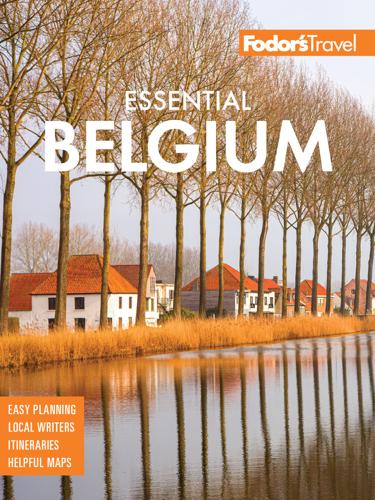
Fodor's Essential Belgium
by
Fodor's Travel Guides
Published 23 Aug 2022
Know Before You Go GET YOUR COVID-19 PAPERWORK SORTED For as long as COVID-19 is with us, all travelers to Belgium, even if entering overland from a neighboring country, need to complete a Passenger Locator Form (PLF) online (travel.info-coronavirus.be) , no more than 48 hours before arriving, providing a local address and other information; you’ll be sent a QR code to present at passport control. The only exception to this is if you arrive overland and stay for less than 48 hours. Chances are you will also need proof of vaccination or recovery, and—if arriving by air—a negative PCR test before traveling. This information is prone to change, however, so always check the website of the U.S.
…
Five floors of exhibits explore themes such as trade and shipping, men and gods, here and elsewhere, and prestige and symbols, showcasing everything from pre-Columbian artifacts to gas masks from World War II. It’s all capped off with a panoramic rooftop view (free to visit) and a Michelin three-star restaurant, ‘t Zilte. Note that most of the museum’s documentation is not in English; for a translation, use your smartphone to read the QR codes placed next to many exhibits, or pick up an information booklet at the entrance to each room. EHanzestedenplaats 1, Het Eilandje P03/338–4400 wwww.mas.be A€12 (€10 if no temporary exhibition) CClosed Mon. mTram: 7. HOnze-Lieve-Vrouwekathedraal CHURCH | A miracle of soaring Gothic lightness, the Cathedral of Our Lady contains some of Rubens’s greatest paintings and is topped by a 404-foot-high north spire.
…
Among its large collection of medieval art, the crown jewels are the 16th-century altarpiece Triptych of the Holy Spirit by Kortrijk-born Bernard de Rijckere and a magnificent 6.5-meter-high tabernacle tower with some fine reliefs. A free brochure explains many of the artworks. You can also climb its 246-step tower for sweeping views of the city; tickets for this are free but you’ll need to scan the QR code at the gate to download them. EJozef Vandaleplein, Kortrijk AFree. HTexture Museum HISTORY MUSEUM | Flanders’s damp conditions were perfect for growing flax, a crop used to make food, oil, and fibers, particularly linen. It might seem an uninspiring subject, but the crop is so woven into the history of Kortrijk that visits to Texture are surprisingly fascinating.
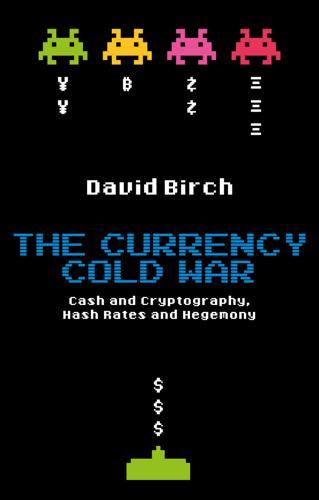
The Currency Cold War: Cash and Cryptography, Hash Rates and Hegemony
by
David G. W. Birch
Published 14 Apr 2020
YEAR MILESTONE 2012 Launched by six Swedish banks 2013 Becomes mobile payment app of the year 2014 Corporate version launched 2015 Reaches three million users 2016 E-commerce version launched 2017 QR codes added 2018 New mobile app launched 2019 48 million transactions per month, 215,000 companies accepting Swish, 7.5 million consumers in a population of 10 million, QR code use rising by one-third each month, 22 billion SEK transferred per month In Sweden, the anti-cash alliance is a broad church, embracing not only banks and law enforcement but also trade unions and retailers.
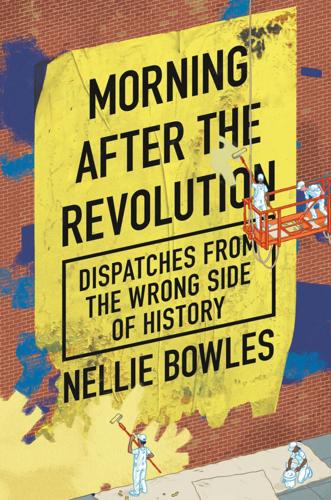
Morning After the Revolution: Dispatches From the Wrong Side of History
by
Nellie Bowles
Published 13 May 2024
Meanwhile, the commonsense reform efforts of the local activists were losing ground. “You know what we call TakeAction? Fake Action,” said Michelle. “You have Yes 4 Minnesota promoting this fake charter.” She’s shaking her head. “They’re talking about getting rid of the police but not what will replace it.” “By putting up posters with their little QR code in George Floyd Square, this group raised $30 million,” Michelle said. “All they’re doing is promoting a poorly written, illegal charter amendment. It makes it even harder to hold police accountable, did you know that? And we’re like, ‘Why are you pushing this?’ We know that the community does not even want it.
…
The father, Terrance, told me he was teaching his children about history, that “there’s always a better way.” People roamed about, soliciting donations to the cause of Black Liberation via Cash App. Kids came up to me selling Black Lives Matter rubber bracelets for five dollars. Others sold flower bundles to lay on the corner. Next to graffiti reading FUCK THE POLICE were foot-long QR codes—point your smartphone camera here and a website would pop up, urging visitors to give to that variety of newly launched black American causes with chic websites. The tent marked MEDIC was, inside, just piled up with firewood and garbage bags. The gardens with tomatoes, peppers, beans, and herbs had received glowing international coverage of their own—“A Garden Is The Frontline In The Fight Against Racial Inequality and Disease,” said NPR—but it was cold and they were now just dried-up sticks.
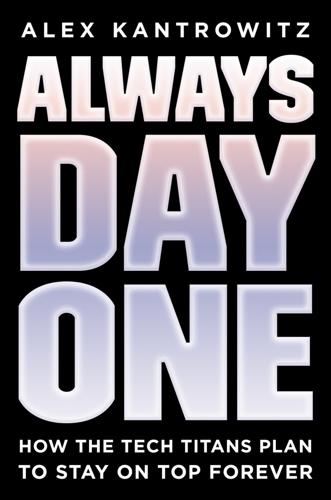
Always Day One: How the Tech Titans Plan to Stay on Top Forever
by
Alex Kantrowitz
Published 6 Apr 2020
He grabbed a product from a rack, dropped it into a bin, the robot scurried off, the next robot stopped by, a section of the rack lit up, he grabbed a product from that section, and off the robot went. It all moved very quickly. Advanced software under the hood makes the process run smoothly. The robots move through the FC by reading QR codes scattered across the floor. When a robot passes over a code, it’s instructed either to wait or to move to the next QR code, where it’s given more instructions. The system knows how fast each picker and stower works, and automatically sends more robots to the faster workers and fewer to the slower ones. At another FC I visited, in Kent, Washington, the robots stop in front of cameras that scan the racks, assess the amount of space left (using computer vision), and determine when they should be sent back for more stowing (or sent to a problem-solving team when items look askew).
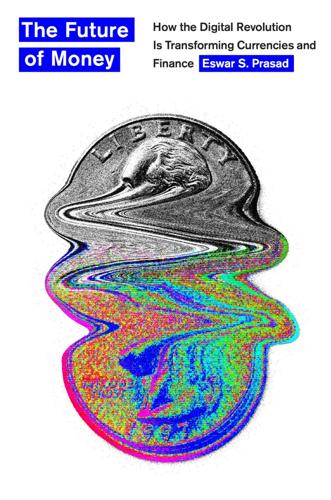
The Future of Money: How the Digital Revolution Is Transforming Currencies and Finance
by
Eswar S. Prasad
Published 27 Sep 2021
Alipay’s success in resolving the lack of trust between transacting parties resulted in its rapid and tremendous growth, which soon led to its adoption even on other platforms outside the Alibaba ecosystem. Alipay has played a key role in innovations such as the QR code–based payment technology that has put the means of payment in the hands of the customer (in the form of a mobile phone) and requires the merchant only to have a QR reader (QR code stands for “Quick Response code,” a machine-readable matrix bar code). This allows merchants to process payments even if they are off-line or lack a stable internet or mobile phone connection. QR readers are also markedly cheaper to set up and maintain than the point-of-sale processors associated with debit and credit cards.
…
Tencent saw an opportunity to expand its footprint and, riding on the mobile commerce wave, quickly added a number of features that allowed WeChat Pay to start competing with Alipay. WeChat payment accounts linked to bank accounts are now widely used to make digital payments for practically any product or service. Making a payment with a QR code reader In 2014, at the time of the Chinese New Year, WeChat introduced a feature for distributing virtual red envelopes, modeled after the Chinese tradition of exchanging packets of money among friends and family members during holidays. To add an element of excitement and unpredictability, money sent to groups can be distributed in random shares (Lucky Money).
…
See cash Paraguay, 344, 345 payment and settlement systems: back end of, 88–89; backup, CBDCs for, 198–199; Bitcoin in (see Bitcoin); cash in (see cash); CBDCs in, 12–13, 194–201, 205, 226, 229, 243, 246–257, 261–262, 265, 266–273 (see also central bank digital currencies); central bank management of, 47, 324–325, 328–329; characteristics of efficient, 109–118; counterparty risk in, 9, 199, 328; credit and debit card (see credit and debit cards); cross-border or international (see international payments and settlements); cryptocurrencies in (see cryptocurrencies); decentralization of, 8–9, 11, 56, 90, 267–268, 324–325, 334–335; in developing economies, 15–16, 64–68, 84–88, 344–346, 348–349, 351–352; financial system role of, 45–49; Fintech effects on, 63–68, 83–94, 102, 103–104, 280–285, 289, 327–329, 356–357; fraud in, 86, 102, 379n; legal tender in, 240–245, 253, 254, 260, 263, 419n; mobile money in, 64–68, 346, 370–371n; net deferred, 46, 195; real-time gross, 46–47, 48, 195, 269–270, 271, 283, 351; regulations on, 15–16, 88, 89, 327–329, 331–332, 334–335; remittances via, 16, 67–68, 91–92, 174, 311, 343, 371n; retail, 12–13, 45–46, 83–87, 195, 196–201, 205, 229, 234–235, 265, 284, 327–329, 351; transaction costs in, 8, 15, 48, 69, 85–86, 91, 92–93, 382n; trust and confidence in, 11, 18–21, 46–47, 56, 84, 86–87, 88, 107, 112, 119–120, 127–129, 136, 271–272, 324, 358–359; US dollar dominance in, 278; wholesale, 12, 46–47, 194–196, 266–268, 270–273, 324–325, 351 peer-to-peer (P2P) lending, 69–72, 78–79, 98–99, 372–373n peer-to-peer network, 120, 128, 283 Peru, 244, 344, 345, 347, 419n Philippines, 16, 174 Portugal, 215, 295 privacy: cash and, 229, 239; CBDC effects on, 22, 228–230, 237–238, 240, 252–253, 266, 358; cryptocurrencies and, 158, 358; digital payment systems and, 88, 229; Fintech implications for, 88, 103–105. See also anonymity private equity investments, 50–52. See also venture capital Proof of Stake protocol, 152–155, 197 Proof of Work protocol, 120–122, 124–125, 128, 129, 134, 135, 138–142, 152–155 QR code-based payment technology, 84, 85f, 88 quantitative easing, 108, 313 real-time gross settlement system (RTGS), 46–47, 48, 195, 269–270, 271, 283, 351 regulations: blind spots in, 327–329; cash acceptance, 232, 239, 241–245; cash undermining adherence to, 230–231; central bank implementation of, 317–318, 326–342; cryptocurrency, 151, 156–157, 165, 168, 170–171, 175–182, 185–186, 257, 405–406n; in developing economies, 15–16, 17, 78–79, 88, 352; digital lending, 78–79; financial system oversight and, 6–7, 45, 49, 102–103, 185–186, 318, 326–342, 352; Libra, 170, 171; microinsurance, 82; payment and settlement system, 15–16, 88, 89, 327–329, 331–332, 334–335; regulatory sandboxes of, 336–342, 352, 448–449n; risk-innovation balance with, 335–342; securities, 165, 168, 179, 257, 289, 368n; shadow finance, 49–50, 52–53, 368n; technology effects on, 332–335 remittances, 16, 67–68, 91–92, 174, 311, 343, 371n Ripple or XRP, 90–91, 135 risk: CBDC benefits weighed against, 235–238, 349–353; central banks balancing innovation with, 14, 335–342, 352; counterparty, 9, 199, 328; credit default, 271; default, 70, 75, 183; diversification mitigating, 36–37; financial system, 6–7, 35–38, 42–44, 184–186, 355; Fintech benefit trade-offs with, 17, 56–57, 78–79, 100–105, 335, 355; insurance assessing, 36, 80; interest rates reflecting, 56; Libra benefit trade-offs with, 174–175; at macro level, 37–38; of mobile money, 67–68; of peer-to-peer lending, 70–71, 78–79; settlement, 271, 273; in shadow financial system, 53; SWIFT, 281–282 Russia: cash in, 31, 32f–33f, 33, 218; cryptocurrencies in, 140–142, 141f, 257–258; economic reliance on oil, 37, 282; global distribution of money, 30f; payment systems in, 281, 282, 284–285, 298, 309; US sanctions on, 257, 258, 282, 284, 309 Saudi Arabia, 37–38, 272–273, 298 savings: deposit insurance for, 18, 100, 227–228; deposits into, 26, 28, 52; Fintech changes to, 8, 16; global capital markets and, 6, 287–288; interest rates on, 35, 202, 204, 206, 322–323; maturity transformation of, 39, 98; in shadow financial institutions, 52; transformation into investments, 34–35 securitization, 43–44, 367n Security Token Offerings (STOs), 167–168 seed capital, 50–52, 368–369n, 400n seigniorage, 219–220, 222, 414n SHA-256 hash function, 113, 115, 121, 386n shadow economy, 214–217, 347, 412–413n shadow finance, 49–53, 326, 367n, 368–369n Singapore, 11, 164, 195, 265–268, 270–272, 283, 336–337, 341, 350, 449n smart contracts, 159–162, 161f, 173, 182–187, 253, 398n smart money, 223–224, 238 Somalia, 67–68, 371n South Africa, 54 South Korea, 30f–31f, 177, 341 Spain, 91, 92, 93–94, 215, 295 Special Drawing Rights (SDRs), 304–307, 308, 441n stablecoins, 10, 155–157, 169, 173, 201, 287, 296, 300–301, 311–312, 351 Sweden: cash in, 3, 4f, 11, 31, 32f–33f, 46, 210–211, 218, 221f, 233, 244, 254–255; CBDCs in, 4, 12–13, 196, 198–199, 216–217, 229, 243, 246, 254–257, 321, 350; finance changes in, 5; interest rates in, 320–321; legal tender in, 242–243, 244; monetary policy in, 320–321; payment systems in, 46 SWIFT (Society for Worldwide Interbank Financial Telecommunication), 48, 280–285, 308, 433n, 435n Switzerland, 30, 30f–31f, 164, 239–240 synthetic hegemonic currency (SHC), 301–302 System for Transfer of Financial Messages (SPFS), 284 Taiwan, 31f Tanzania, 78 taxes: cash to evade, 13, 214–217, 230, 345, 412–413n; CBDCs and, 198, 216–217, 262; cryptocurrencies and, 175, 178, 180, 262; in developing economies, 345, 346, 348; fiat currencies for, 25 technology: blockchain (see blockchain technology); distributed ledger (see distributed ledger technology); environmental effects of, 138–142; financial (see Fintech); historical revolutions of, 61–62; international monetary system effects of, 279–280; network effects of, 21, 64, 102, 311, 335, 354–355; neutrality and interoperability of, 252, 283; payment system, 48–49, 280–285; regulatory effects of, 332–335; SWIFT, 283 Tether, 155–157, 175, 351 text messages, 65, 83 Thailand, 273, 283 traveler’s checks, 28–29 trust and confidence: in banks and financial institutions, 18, 40, 56, 97, 106, 108, 227–228, 324, 327; in Bitcoin, 20, 56, 107, 112, 119–120, 127–129, 136; in cash, 19, 127–128, 320; in CBDCs, 228, 246–247, 271–272, 320; in central banks, 11, 17–18, 19, 347, 348, 356; in cryptocurrencies, 20, 56, 173, 358–359; in fiat currencies, 25, 227; in financial system, 17–21, 55–56, 108; in inside money, 27; in Libra, 173; in payment and settlement systems, 11, 18–21, 46–47, 56, 84, 86–87, 88, 107, 112, 119–120, 127–129, 136, 271–272, 324, 358–359; without trusted authority, 19–21, 55–56, 106–107, 119–120, 271 Tunisia, 245 Turkey, 284 Ukraine, 245 unemployment, 13, 37, 202–203, 313, 316–317 Unified Payments Interface (UPI), 87–88, 335, 380n United Arab Emirates, 272–273 United Kingdom: cash in, 32f–33f, 218–219, 222; CBDCs in, 14, 266, 270, 350; cryptocurrencies in, 162, 164, 264–265; digital banks in, 69; global distribution of money, 30, 30f–31f; legal tender in, 241–242; payment systems in, 91–92, 270, 285; peer-to-peer lending in, 71; pound as vehicle currency, 286; regulatory sandbox in, 336–337, 341, 449n; smart contract legislation in, 162; trade deficit of, 7 United States: banks and financial institutions in, 45, 62, 69, 97, 100, 330–331, 384n; cash in, 12, 32, 32f–33f, 219, 221f, 222, 223, 225, 231–234, 239, 241, 412n, 414n; CBDCs in, 14, 222, 274; credit and debit cards in, 86; crisis management in, 330–331; crowdfunding in, 72–73; cryptocurrencies in, 156–157, 162–165, 168, 170, 173, 176–182, 405–406n; deposit insurance in, 100, 227–228; dollar as vehicle currency, 286–287; dollar dominance and challenges in international monetary system, 277–280, 296–311, 312, 357, 440n, 442n; dollar valuation in, 131; finance changes in, 5; financial inclusion in, 54, 236, 416–417n; financial system regulation in, 102, 338–340; Food Stamp Program in, 223; global distribution of money, 29–30, 30f–31f; gold standard in, 25, 193; insurance in, 80–82; interest rates in, 13, 17, 108, 202, 278, 291, 323, 330, 410n; legal tender in, 241; loans / lending systems in, 69–73, 78, 377n; monetary aggregates in, 28–29; monetary policy in, 13, 16–17, 108, 202, 278–279, 291, 313, 316, 323, 410n; payment systems in, 47, 83–84, 88–89, 92–94, 103–104, 351, 379n; regulatory sandboxes in, 338–340, 448n; sanctions by, 257, 258, 260, 262, 279, 282–285, 295, 296–297, 309, 433n; SDR opposition by, 306–307; shadow economy in, 215, 216; shadow financial system in, 326; smart contract legislation in, 162; spillover effects from, 278–279, 291, 343; SWIFT influence of, 281–285, 433n; trade deficit of, 7, 279, 303 Uruguay: cash in, 244–245; CBDCs in, 4, 12, 200, 245, 247–249, 344, 347, 351, 422–423n; dollarization of, 344; financial inclusion in, 200, 244; legal tender in, 244–245; payment systems in, 345, 422–423n vehicle currencies, 285–287 Venezuela, 257, 259–262, 309, 344, 345, 346 Venmo, 83–84, 103–104, 196, 217 venture capital, 50–52, 368–369n, 400n wealth management, 94–96, 103 WeChat Pay, 13, 84–87, 199, 251, 253 XRP or Ripple, 90–91, 135 Yemen, 16 Zcash, 158–159, 397n Zimbabwe, 17, 371n
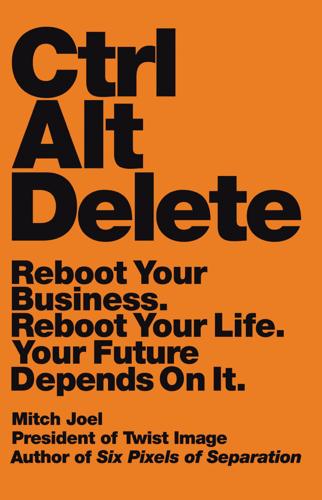
Ctrl Alt Delete: Reboot Your Business. Reboot Your Life. Your Future Depends on It.
by
Mitch Joel
Published 20 May 2013
This means that big data is coming to marketing, and the insights that we will soon have available to us—at the business level—will make what we’re spending on computers, servers, and capital infrastructure pale in comparison. This will finally give us true knowledge of what it takes to acquire customers and keep them. Consumers are already demonstrating their desires in this area by using their smartphones to do everything from scanning QR codes to sharing their experiences with their peers on Facebook and Twitter. When you combine their usage (the linear data) with the circular data (what they’re doing in their social graph), and with all of this new big data trending information, it’s easy to see how much this will affect everything we know about connecting to our consumers.
…
Homeplus is the number two supermarket in South Korea (after E-Mart) and was looking for a new and innovative way to become number one without increasing their number of stores. Because of the intense work ethic of Koreans, Homeplus decided to bring the store to these very busy people. Shoppers could download the Homeplus app, and by scanning the QR codes beneath each food item on these virtual walls, Koreans could turn their waiting time into productive shopping time. If orders were placed before the afternoon, Homeplus would be able to deliver the groceries on the same day. Yes, Koreans are early technology adopters and have a culture that engenders this type of technological sampling, but it speaks volumes to our ever-changing world and adoption of mobile technology.

Advertisers at Work
by
Tracy Tuten
Published 28 May 2012
We’ve worked on it both night and day. We’re really proud of what our team and our clients have created. Tuten: When you look around the industry, what’s most surprising to you? Raih: There is a sea change when you look around the industry seemingly daily. You know, even a month ago, we would talk about QR codes 7 and I would argue that QR codes are already passé. That is just one example of how quickly tools and platforms and ways to tell stories are changing. We as an industry have been asked to be creative in the medium and now that is not enough. We need to be creative in the delivery of the message. Tuten: With the nonstop news and industry developments, how do you stay up-to-date on what’s happening?
…
To overcome this, the trend is to provoke and to try to create the belief in relevance around the brands you are working with. The key is to really try to distill the problem and solutions. We are always after a good idea. A good idea is a good idea. With it, we can figure out what screen to put it on. A QR code is not a good idea. It is one potential arrow in the quiver. It is not an idea. Start with the idea. Then we will find the right production partners to put it on the most pertinent screens. Tuten: Give me an example of one of Zambezi’s great ideas. Raih: I would say one piece that was pretty funny is our work with vitaminwater.

Four Battlegrounds
by
Paul Scharre
Published 18 Jan 2023
License plate readers alert the police to certain vehicles, such as those from outside the region. In parts of Xinjiang, authorities have mandated that all vehicles install tracking devices using China’s version of the global positioning system (GPS), BeiDou. Chinese authorities have placed QR codes on peoples’ homes, giving visiting authorities instant access to information about the residents. In some areas, kitchen knives are stamped with QR codes to track their ownership. Smartphones, in particular, are an easy vector for intrusive surveillance. Ürümqi police use handheld devices to automatically scan smartphones for unauthorized audio and video, speeding up the process of searching for content.
…
ABBREVIATIONS ABC American Broadcasting Company ACE Air Combat Evolution ACLU American Civil Liberties Union AFWERX Air Force Works AGI artificial general intelligence AI artificial intelligence AIDS acquired immunodeficiency syndrome ALS amyotrophic lateral sclerosis (also known as Lou Gehrig’s disease) ASIC application-specific integrated circuit AU African Union AWACS airborne warning and control system AWCFT Algorithmic Warfare Cross-Functional Team BAAI Beijing Academy of Artificial Intelligence BBC British Broadcasting Corporation BERT Bidirectional Encoder Representations from Transformers BCE before common era C4ISR Command, Control, Communication, Cloud, Intelligence, Surveillance, and Reconnaissance CBC Canadian Broadcasting Corporation CBP Customs and Border Patrol CCP Chinese Communist Party CEIEC China National Electronics Import and Export Corporation CEO chief executive officer CFIUS Committee on Foreign Investment in the United States CIA Central Intelligence Agency CLIP Contrastive Language–Image Pretraining CMU Carnegie Mellon University COBOL common business-oriented language COVID coronavirus disease CPU central processing unit CSAIL Computer Science and Artificial Intelligence Laboratory DARPA Defense Advanced Research Projects Agency DC District of Columbia DDS Defense Digital Service DEA Drug Enforcement Administration DIU Defense Innovation Unit DIUx Defense Innovation Unit—Experimental DNA deoxyribonucleic acid DoD Department of Defense EOD explosive ordnance disposal EPA Environmental Protection Agency ERDCWERX Engineer Research and Development Center Works EU European Union EUV extreme ultraviolet FBI Federal Bureau of Investigation FedRAMP Federal Risk and Authorization Management Program FEMA Federal Emergency Management Agency FOUO For Official Use Only FPGA field-programmable gate arrays GAN generative adversarial network GAO Government Accountability Office GB gigabytes GDP gross domestic product GDPR General Data Protection Regulation GIF graphics interchange format GNP gross national product GPS global positioning system GPU graphics processing unit HA/DR humanitarian assistance / disaster relief HUD head-up display IARPA Intelligence Advanced Research Projects Activity ICE Immigration and Customs Enforcement IEC International Electrotechnical Commission IED improvised explosive device IEEE Institute for Electrical and Electronics Engineers IJOP Integrated Joint Operations Platform IoT Internet of Things IP intellectual property IP internet protocol ISIS Islamic State of Iraq and Syria ISO International Organization for Standardization ISR intelligence, surveillance, and reconnaissance ITU International Telecommunication Union JAIC Joint Artificial Intelligence Center JEDI Joint Enterprise Defense Infrastructure KGB Komitet Gosudarstvennoy Bezopasnosti (Комитет государственной безопасности) MAGA Make America Great Again MAVLab Micro Air Vehicle Lab MIRI Machine Intelligence Research Institute MIT Massachusetts Institute of Technology MPS Ministry of Public Service MRAP mine-resistant ambush protected NASA National Aeronautics and Space Administration NATO North Atlantic Treaty Organization NBC National Broadcasting Company NGA National Geospatial-Intelligence Agency NLG Natural Language Generation nm nanometer NOAA National Oceanic and Atmosphere Administration NREC National Robotics Engineering Center NSIC National Security Innovation Capital NSIN National Security Innovation Network NUDT National University of Defense Technology OTA other transaction authority PhD doctor of philosophy PLA People’s Liberation Army QR code quick response code R&D research and development RFP request for proposals RYaN Raketno Yadernoye Napadenie (Ракетно ядерное нападение) [nuclear missile attack] SEAL sea, air, land SMIC Semiconductor Manufacturing International Corporation SOFWERX Special Operations Forces Works SpaceWERX Space Force Works STEM science, technology, engineering, and mathematics TEVV test and evaluation, verification and validation TPU Tensor Processing Unit TRACE Target Recognition and Adaptation in Contested Environments TSA Transportation Security Administration TSMC Taiwan Semiconductor Manufacturing Company TTC Trade and Technology Council UAV unmanned aerial vehicle UK United Kingdom UN United Nations U.S.
…
New York Times, September 8, 2018, https://www.nytimes.com/2018/09/08/world/asia/china-uighur-muslim-detention-camp.html; “ ‘Eradicating Ideological Viruses’”; Austin Ramzy and Chris Buckley, “‘Absolutely No Mercy’: Leaked Files Expose How China Organized Mass Detentions of Muslims,” New York Times, November 16, 2019, https://www.nytimes.com/interactive/2019/11/16/world/asia/china-xinjiang-documents.html. 80“re-education” in Chinese Communist Party ideology: Buckley, “China Is Detaining Muslims in Vast Numbers.” 80writing or publicly speaking the Uighur language: Darren Byler, “The ‘Patriotism’ of Not Speaking Uyghur,” SupChina, January 2, 2019, https://supchina.com/2019/01/02/the-patriotism-of-not-speaking-uyghur/. 80Wi-Fi “sniffers”: “China’s Algorithms of Repression.” 80License plate readers: Chin and Bürge, “Twelve Days in Xinjiang.” 80all vehicles install tracking devices: Wong Siu-san and Sing Man, “Vehicles to Get Compulsory GPS Tracking in Xinjiang,” translated by Luisetta Mudie, Radio Free Asia, February 2, 2020, https://www.rfa.org/english/news/uyghur/xinjiang-gps-02202017145155.html; Tom Phillips, “China orders GPS tracking of every car in troubled region,” The Guardian, February 20, 2017, https://www.theguardian.com/world/2017/feb/21/china-orders-gps-tracking-of-every-car-in-troubled-region. 80QR codes on peoples’ homes: “‘Eradicating Ideological Viruses.’” 80kitchen knives are stamped with QR codes: Catherine Lai, “Xinjiang Town Orders Residents to Engrave Names and ID Numbers on to All Knives, Including Kitchen Tools,” Hong Kong Free Press, January 12, 2017, https://hongkongfp.com/2017/01/12/xinjiang-town-orders-residents-engrave-names-id-numbers-knives-including-kitchen-tools/; Chin and Bürge, “Twelve Days in Xinjiang”; 忻霖 ([Xīn Lín], “新疆温宿县下令民间刀具刻铸实名 全疆各医院病人先安检后看病 [Wensu County, Xinjiang ordered privately owned knives to be carved with real names | patients in hospitals across Xinjiang go through security checks before seeing a doctor],” rfa.org, January 11, 2017, https://www.rfa.org/mandarin/yataibaodao/shaoshuminzu/xl2-01112017102645.html. 80handheld devices to automatically scan smartphones: Chin and Bürge, “Twelve Days in Xinjiang.” 8073,000 prohibited pictures, videos, documents, and audio files: Raymond Zhong, “China Snares Tourists’ Phones in Surveillance Dragnet by Adding Secret App,” New York Times, July 2, 2019, https://www.nytimes.com/2019/07/02/technology/china-xinjiang-app.html. 80frozen data cards in dumplings: Byler, “Ghost World.” 80absence of a phone: Byler, “Ghost World”; Byler, “I Researched Uighur Society.” 81two phones: Chin and Bürge, “Twelve Days in Xinjiang.” 81live in Uighurs’ homes to monitor them: Darren Byler, “China’s Nightmare Homestay,” Foreign Policy, October 26, 2018, https://foreignpolicy.com/2018/10/26/china-nightmare-homestay-xinjiang-uighur-monitor/. 81Integrated Joint Operations Platform (IJOP): “China’s Algorithms of Repression.” 81“this panopticon that is envisioned in our dystopian nightmare”: Wang, interview. 81“eyes are so tired and reddened”: “China’s Algorithms of Repression.” 82“That’s how state terror works”: Bethany Allen-Ebrahimian, “Exposed: China’s Operating Manuals for Mass Internment and Arrest by Algorithm,” International Consortium of Investigative Journalists, November 24, 2019, https://www.icij.org/investigations/china-cables/exposed-chinas-operating-manuals-for-mass-internment-and-arrest-by-algorithm/. 82“As neighbors disappear”: Allen-Ebrahimian, “Exposed: China’s Operating Manuals for Mass Internment and Arrest by Algorithm.” 82fear of state control “isn’t a bug but a feature”: Allen-Ebrahimian, “Exposed: China’s Operating Manuals for Mass Internment and Arrest by Algorithm.” 82“for example, if you have been to a camp”: Wang, interview. 83“the people have sharp eyes”: This phrase is sometimes translated as “the masses have sharp eyes.”
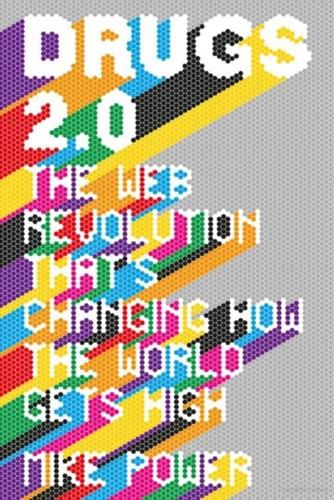
Drugs 2.0: The Web Revolution That's Changing How the World Gets High
by
Mike Power
Published 1 May 2013
Matthew sold five different kinds of synthetic marijuana, a heroin analogue, several hallucinogens, three or four versions of drugs that were like cocaine and many more. He was an early adopter of Twitter, using the microblogging site to inform customers of sales and offers and promotions, and was one of the first people in any trade to use QR codes – the scannable, almost bitmapped black-and-white icons that, when scanned and decrypted, would send customers to secret URLs on his site that had special deals. He remained sober while working, and ensured that all of his staff did too. His own drug habits while not working are a topic he chooses not to discuss.
…
D., 1 Lamere, Timothy, 1 Lancet, The, 1 Latvia, 1 Leary, Timothy, 1, 2 Legalhighguides, 1 Leonhart, Michele, 1 Lewman, Andrew, 1, 2 Liberty Gold, 1 Life magazine, 1 lignocaine, 1 Lilly, John, 1 Linder, David, 1 Linnaeus, Carl, 1 Llewellyn, Max, 1 Lloyd, Daniel, 1 London Toxicology Group (LTG), 1, 2 Loomis, Katrina, 1 lotus leaves, 1 Louwagie, Pam, 1 LSD, 1, 2, 3, 4, 5, 6, 7, 8, 9 and bizarre behaviour, 1 and drug myths, 1 online sales, 1, 2, 3, 4 LSD: The Beyond Within, 1 magic mushrooms, 1, 2, 3, 4, 5, 6, 7, 8, 9 and drug laws, 1 Mail on Sunday, 1, 2, 3 Makriyannis, Alexandros, 1 Manchin, Joe, 1 Mancuso, David, 1 Manson, Alasdair, 1 marijuana (cannabis), 1, 2, 3 American policy on, 1 and decriminalization debate, 1, 2 droughts, 1 as gateway drug, 1 ‘grit weed’, 1 and Mexican drugs war, 1 online sales, 1, 2, 3 popularity, 1 reclassification controversy, 1 replacements, 1, 2, 3, 4, 5, 6, 7, 8, 9 Markoff, John, 1 Marquis reagent, 1 Mathewson, Nick, 1 May, Theresa, 1 Mayhew, Christopher, 1, 2 MBZP, 1 MDA, 1, 2, 3 MDAI, 1, 2, 3 MDMA (Ecstasy), 1 and bingeing, 1 and Bluelight community, 1 brain effects, 1 compared with mephedrone, 1, 2 compared with methylone, 1 deaths, 1, 2, 3 decline in quality, 1, 2, 3 and decriminalization debate, 1, 2 global drought, 1, 2, 3, 4 increase in supply, 1 interaction with MAOIs, 1 and internet, 1, 2, 3 introduction to Britain, 1 and mass culture, 1, 2 MDA variant, 1, 2 and mephedrone substitution, 1 ‘molly’, 1 online sales, 1, 2, 3 popularity, 1, 2 popularity in China, 1 prices, 1 and safrole synthesis, 1 synthesis, 1 testing, 1, 2, 3 TMA derivative, 1 use in psychotherapy, 1 MDP-2-P, 1 MDPV, 1, 2, 3, 4, 5 Measham, Fiona, 1 Mendez, Eva, 1 mephedrone (Meow), 1, 2, 3, 4, 5 deaths, 1 and decriminalization debate, 1, 2, 3 increased use, 1, 2, 3 marketing and legislation, 1, 2 popularity, 1 replacements, 1, 2, 3, 4 mescaline, 1, 2, 3, 4, 5, 6, 7, 8, 9 and MDMA, 1, 2, 3 methadone, 1 methamphetamine, see crystal meth methcathinone, 1, 2 methiopropamine, 1, 2 methoxetamine (MXE; 3-MeO-2-Oxo-PCE), 1, 2, 3, 4, 5 methylone, see BK-MDMA methylsafrylamin, 1 Mexican drugs war, 1, 2 Miami zombie cannibal case, 1 Milne, Hugh, 1 MixMag survey, 1, 2, 3 mod culture, 1 monoamine oxidase inhibitors (MAOIs), 1 Moore, Demi, 1 morning glory seeds, 1 morphine, 1, 2 Morris, Hamilton, 1 Morse, Samuel, 1 Mother of All Demos, 1 mreah prew phnom tree, 1 MtGox, 1 Mulholland, John, 1 MySpace, 1 Nakamoto, Satoshi, 1 naphyrone, see NRG-1 Nasmyth, Peter, 1 National Security Agency (NSA), 1 Native Americans, 1 NatWest, 1 NBC Dateline, 1 needle exchange programmes, 1 Negron, Senator Joe, 1 NeoDoves, 1, 2, 3, 4 Netherlands (Holland), 1, 2, 3, 4, 5, 6, 7 and magic mushrooms, 1 and PMK-glycidate, 1 N-ethyl ketamine, 1 neurotransmitters, 1, 2 see also dopamine; serotonin New Orleans Times Picayune, 1 New York Times, 1, 2 New Yorker, 1 New Zealand, 1 Nichols, David E., 1, 2, 3, 4, 5, 6 Niemoller, Mark, 1 nitrous oxide, 1 Nixon, Richard, 1, 2 non-steroidal anti-inflammatories (NSAIDs), 1 nootropics, 1 norephrenine, 1 norketamine, 1, 2 Norris, Charles, 1 NRG-1 and NRG-2, 1 nuclear magnetic resonance, 1, 2, 3 nutmeg, 1 Nutt, David, 1 Obama, Barack, 1, 2, 3, 4 Operation Adam Bomb, 1 Operation Ismene, 1, 2, 3 Operation Kitley, 1 Operation Pipe Dream, 1 Operation Web Tryp, 1, 2, 3, 4, 5, 6, 7, 8 opium, 1 O’Reilly, Tim, 1 organized crime, 1, 2, 3 Orthopedics, 1 Osmond, Humphrey Fortescue, 1, 2, 3 Otwell, Clayton, 1 Oxycodone, 1 packet-switching, 1, 2 Panorama, 1 paracetamol, 1 Parkinson’s, 1 Parry, Simon, 1 party pills, 1 PayPal, 1, 2, 3, 4 Payza, 1 Pecunix, 1 pentylone, 1, 2 pesticides/herbicides, 1, 2 peyote, 1, 2, 3, 4, 5 pharmacokinetics, 1 phenazepam, 1 phenethylamines, 1, 2, 3, 4, 5, 6, 7, 8, 9, 10 Pillreports.com, 1 Pink Floyd, 1 piperazines, 1, 2, 3, 4, 5 piperidines, 1 piperonal, 1 piracetam, 1 Platt, Lord, 1 PMA, 1, 2 PMK, 1 Poland, 1, 2 Poppo, Ronald, 1 Portugal, 1 potassium permanganate, 1 Preisler, Steve (Uncle Fester), 1, 2 Price, Gabrielle, 1 Princess Bride, The, 1 Project MKultra, 1 Prozac, 1, 2 psilocin, 1, 2 Psilocybe cubensis, 1 Psilocybe semilanceata (liberty caps), 1 psilocybin, 1, 2, 3, 4, 5 see also magic mushrooms psychiatric patients, treated with LSD, 1 Punch, 1 punks, 1 Pursat, 1 QR codes, 1 Quick Kill, 1 Rachmaninov, Sergei, 1, 2 Ramsey, John, 1, 2, 3, 4, 5, 6 Reding, Viviane, 1 Register, The, 1 Reid, Brian, 1 Reid, Fergal, 1 Research Chemical Mailing List (RCML), 1 research chemicals, 1 arrival of legal highs, 1 custom syntheses, 1, 2 growth in availability, 1 and law enforcement, 1 new compounds statistics, 1 online sales, 1 overdoses and mislabelling, 1, 2, 3 and retail market, 1 and substance displacement, 1 users, 1 Reynolds, Simon, 1 ring substitution, 1, 2, 3, 4, 5, 6, 7, 8 Ritalin, 1 Robbins, Joshua, 1 Robinson-Davis, Trevor, 1 Rolling Stone, 1 Russia, 1 Ryan, Mark, 1 Sabag, Doron, 1 Sabet, Kevin, 1 safrole, 1, 2, 3, 4 salmonella, 1 Saltoun, Lord, 1 Salvia divinorum, 1, 2 Sandison, Ronald, 1 sannyasin, 1 Santos, Juan Manuel, 1 sapo, 1 sarin, 1 Saunders, Nicholas, 1, 2 Saunders, Rene, 1 Schumer, Senator Charles, 1 sclerotia (truffles), 1 scopolamine, 1 Scroggins, Justin Steven, 1 Second World War, 1 Serious Organised Crime Agency (SOCA), 1, 2, 3 serotonin, 1, 2, 3, 4, 5, 6, 7 serotonin syndrome, 1, 2 Shafer, Jack, 1 Shamen, the, 1 Shanghai, 1, 2, 3, 4, 5 Shen-Nung, Emperor, 1 Shepton Mallet, 1, 2 Shulgin, Alexander creation of MDMA, 1, 2, 3, 4 creation of methylone, 1 and drug legislation, 1 internet presence, 1 PIHKAL and TIHKAL, 1, 2, 3, 4, 5, 6, 7, 8, 9, 10, 11, 12, 13 and sex, 1, 2 The Shulgin Index, 1 Shulgin, Ann, 1 Shultes, Richard Evans, 1 Silk Road, 1, 2, 3, 4, 5, 6, 7, 8 SKUNK!

The Perfect Police State: An Undercover Odyssey Into China's Terrifying Surveillance Dystopia of the Future
by
Geoffrey Cain
Published 28 Jun 2021
She asked the family to report on their daily activities and whether they had noticed anything unusual about their neighbors’ activities. Ms. Ger’s questions were an intrusion, but Maysem’s family reasoned she was only doing her job. After asking her daily questions, Ms. Ger wrote down the answers and reported them back to the authorities. A few weeks later, in early July 2016, she began scanning a QR code (a type of barcode) containing the family’s personal information, hoisted to the outside of the apartment door, to signify she had checked the apartment and all appeared fine. Then she went next door, continuing the process until she had checked all ten households and reported to the local authorities.
…
“Construction workers showed up suddenly, without telling anyone, and put fences around neighborhoods overnight. They woke up wondering what happened,” Maysem said.2 Purchasing simple household items like kitchenware and groceries became a hassle. Eventually, knife salesmen were required to pay thousands of dollars for a machine that turned a customer’s ID card photo, ethnicity, and address into a QR code, a type of barcode that could be scanned with a smartphone for information, which was then lasered into the blade of any knife they sold.3 That way, the data and identity of knife purchasers were etched into the knives they bought, a precaution should a terrorist go on a knife-attack spree. “But it can’t get that much worse,” people told Maysem.

How to Prevent the Next Pandemic
by
Bill Gates
Published 2 May 2022
They’re reducing shipping costs and saving refrigerator space by making the packages smaller, and they’re simplifying the process for health workers by getting rid of powders that have to be mixed with liquid on site. Bar codes printed on the vials will let vaccinators use their cell phones to confirm that the vaccines are legitimate, just as you might scan a QR code to pull up the menu at a restaurant. When each vial is scanned, health officials can keep track of exactly how many have been used, which will tell them when the clinic is running low and needs to be resupplied. Advanced methods for delivering vaccines, such as replacing the needle and syringe with a small patch containing micro-needles—picture something that looks superficially like the nicotine patches that people use to stop smoking—could make the process safer for everyone, and they may make vaccines easier to deliver too
…
* * * — There are, of course, huge sectors of the economy where workplaces won’t change as much or will shift in different ways from what I’m describing here. If you’re a flight attendant, your job has probably evolved a lot in recent years but not because of increased digitization. If you’re a server in a restaurant, your customers might now use a QR code menu to decide what they want before placing orders through their phones. And if you work on a factory floor, technology has been changing your job since long before the pandemic.[*2] Digitization will eventually transform all of our lives in one way or another, though. Consider how the way you take care of your health may have changed since 2020.
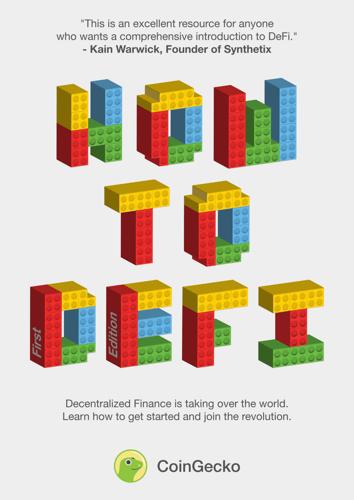
How to DeFi
by
Coingecko
,
Darren Lau
,
Sze Jin Teh
,
Kristian Kho
,
Erina Azmi
,
Tm Lee
and
Bobby Ong
Published 22 Mar 2020
You will be given a Secret Backup Phrase NEVER lose it NEVER show it to anyone If you lose the phrase, you can’t retrieve it If anyone else has it, they are able to access your wallet and do anything with it Step 6 You will be prompted to write the given secret backup phrase to confirm that you have noted it down Step 7 Congratulations! Your wallet is now created! You can use it to store Ethereum and ERC20 tokens Step 8 Below is your public key or your Ethereum address to your wallet Your QR code can be scanned if anyone wants to send you coins. ~ Recommended Readings Argent: The quick start guide (Matthew Wright) https://medium.com/argenthqargent-the-quick-start-guide-13541ce2b1fb A new era for crypto security (Itamar Lesuisse) https://medium.com/argenthq/a-new-era-for-crypto-security-57909a095ae3 A Complete Beginner’s Guide to Using MetaMask (Ian Lee) https://www.coingecko.com/buzz/complete-beginners-guide-to-metamask MyCrypto’s Security Guide For Dummies And Smart People Too (Taylor Monahan) https://medium.com/mycrypto/mycryptos-security-guide-for-dummies-and-smart-people-too-ab178299c82e Part Three: Deep Diving Into DeFi Chapter Five: Decentralized Stablecoins The prices of cryptocurrencies are extremely volatile.
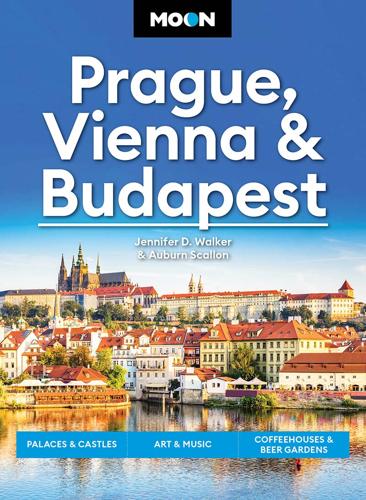
Moon Prague, Vienna & Budapest: Palaces & Castles, Art & Music, Coffeehouses & Beer Gardens
by
Jennifer D Walker
,
Auburn Scallon
and
Moon Travel Guides
Published 15 Oct 2024
Highlights include the breathtaking colonnaded hall and the lavish and ornate historic sitting room that resembles a Greek theater with a stage-like area adorned with Ionic columns and caryatids. The tour will also take you to the Hall of the Federal Council and the newly restored National Council meeting room. When you register for the tour, you will need to give your ID details in advance (make sure you print off the confirmation with the QR code or save it on your phone; you’ll need this to enter the building along with your ID). The entrance is on the street level, and you’ll also have to pass through a security check (some items may not be permitted inside the building, like water bottles, but you will get a ticket and can collect them when you leave).
…
Prices range roughly 385-1,270 CZK on different carriers and direct trains or transfers, with RegioJet offering the best prices. From Budapest: Trains run from Budapest Keleti to Vienna every 1-2 hours (2.5-3 hours, €12-55/5000-21,000 HUF). Trains are operated by multiple companies, like ÖBB Railjet (www.oebb.at) or MÁV (www.mavcsoport.hu)—you can buy tickets online and print them out, or show the QR code on your phone. Since summer 2020, there is now a direct train route by RegioJet (www.regiojet.com) going from Budapest Déli to Vienna and then directly onto Prague. This is the cheapest way to travel by train, and you get a free bottle of water and steward service in the price. This route departs Budapest twice a day, once in the morning (7:45am) and once in the afternoon (3:45pm), and stops in Wien Meidling before continuing to Wien Hauptbahnhof.
…
Bike-Sharing Nextbike www.nextbike.at If you want to cycle down the Danube from Melk to Krems, the Nextbike bike rental station right next to the railway station is the place get a bike. There are also locations in Abt-Karl Straße, Sparkassengasse, and outside the Konditorei Mistlbacher. You will need to download the Nextbike app, register online, or call the hotline (tel. 02/742-229-901). Once you’re registered, you will either enter a bike number or scan a QR code on the bike, after which you will get a code via SMS to unlock it. When your ride is done, you can deposit the bike at the Nextbike station next to the train station in Krems. The app and website will also show you other bike-rental locations (there are other spots in Melk if you can’t find any free bikes at the station).
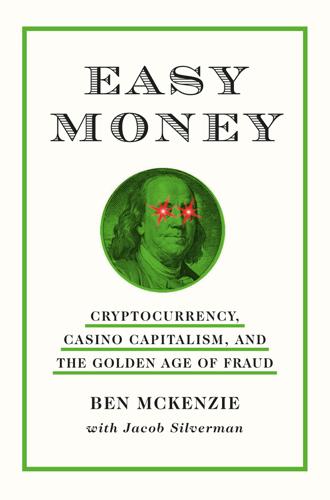
Easy Money: Cryptocurrency, Casino Capitalism, and the Golden Age of Fraud
by
Ben McKenzie
and
Jacob Silverman
Published 17 Jul 2023
Thankfully, Carmen, a young reporter and friend of Mario’s who had been alerted to his arrest, interceded and prevented the police from confiscating it. Mario was eventually released, but a question remained: Why had he been arrested in the first place? The day before, while watching a government presentation about the new Chivo Wallet system, Mario noticed something odd. There was a QR code on one of the slides in the deck, and when you scanned it, it took you to an address that had previously been used to scam people. In 2020, approximately 130 high-profile Twitter accounts had been compromised and used to promote a Bitcoin scam. The scammers only managed to make off with $121,000, but the case had briefly attracted global attention.
…
The scammers only managed to make off with $121,000, but the case had briefly attracted global attention. To Mario, this was alarming. The government was using a scam wallet address in the promotional materials for the new Bitcoin monetary system they had developed in secrecy and were about to deploy. Maybe it was the work of a technical novice who googled “crypto wallet QR code” and used the first result that came up, or perhaps it was some scam by a contractor. Either way, it was a disaster, and Mario alerted his fellow Salvadorans via Twitter to the ridiculousness of the situation. The next day Mario was arrested. Mario knew his stuff. A longtime technologist working on civic-minded projects, he had done stints with organizations like the United Nations World Food Programme.

Recoding America: Why Government Is Failing in the Digital Age and How We Can Do Better
by
Jennifer Pahlka
Published 12 Jun 2023
Lacking direction from the feds on how the public might verify their vaccine status, California launched a site that let you enter your personal information, looked you up in the state vaccine registry, and sent you a QR code you could keep on your phone to prove you’d been vaccinated. As with covidtests.gov, the process took between a few seconds and a few minutes. The team also decided to make the code freely available, and other US states and other countries have borrowed it. This means that when businesses were validating vaccination status, my California-issued QR code worked just as well at a restaurant in New York as it worked at the one down my street. It’s radically simple but, again, that’s the point.

Fixed: Why Personal Finance is Broken and How to Make it Work for Everyone
by
John Y. Campbell
and
Tarun Ramadorai
Published 25 Jul 2025
Some examples of payments systems that have been newly established or radically transformed in recent years include banks’ internal accounts; interbank payments systems, including ACH transfer, wire transfer, and SWIFT; mobile banking platforms such as M-PESA; personal transactions services such as Zelle and Venmo; the QR-code-based payments systems in China such as Alipay and Tencent; high-tech electronic payments in India backed by the Unified Payments Interface (UPI); and, of course, cryptocurrencies. Interestingly, payments technology is being deployed more quickly and effectively in emerging economies, which are unencumbered by legacy systems, than in more advanced economies.
…
See also starter kit for personal finance personal information: fintech and harvesting of, 186–187, 197; required to receive disclosures, 208–209 “phishing for phools,” 55 Phishing for Phools (Akerlof and Shiller), 274n8 phone bias, 293n14 physical commitment devices, 86 Point (online lender), 249 points, fixed-rate mortgage, 120, 229, 247 Policy Bazaar, 183 Ponzi scheme, Bernard Madoff and, 26, 72 population, growth in global, 12–13 portable mortgages, 248, 315n20 Posner, Richard, 208 postal savings systems, 220, 241 Post Office (UK), 220; Horizon scandal and, 311n50 premiums: deductibles and, 252; health insurance, 274n12; long-term insurance and, 253–254 prepayment penalties, 268n22 present, downweighting future against, 47–49 present bias, 48–49 price manipulation, rules against, 227 prices, failure to shop around and raised, 56–58 prime borrowers, 90, 92, 307n18 privacy, cheaper credit and, 91 privacy paradox, 187 privacy policies, fintech firms and, 186–187 private key, cryptocurrency and, 190–191 prize-linked savings accounts, 223, 240, 241 probability, conditional, 41–42 property taxes, deferred for retirees, 261, 316n36 prospect theory, 291–292n7 public pensions, 14, 20; pay-as-you- go, 153 Putnam, Ruth, 4, 166, 263 QR-code based payment system, 184 qualified mortgages (QMs), 217, 310n44 race: credit screening and, 303n19; effect on returns on housing investment, 114; gaps in college success and, 285n11; mortgage rates and, 120; on-time graduation and, 105. See also African Americans Ramadorai, Tarun, 186, 275n14, 284–285n5 Ramsey, Dave, 265n6 rates of return, effect on wealth inequality, 21–22, 23 Reagan, Ronald, 267n20 real estate investment, 293n15 real interest rates, 266n12 real options problem, refinancing mortgage as, 120–121 realtor commissions, 113 redlining, 193, 303n24 reference points, financial decision making and, 38–39 refinancing mortgages, 118–121; automatic, 229, 247, 315n18; cost of, 119; delaying, 289n41; discretionary, 247–248; failure to, 54, 61; when to refinance, 119–120 Registered Education Savings Plan (RESP) (Canada), 240, 310n42 registered investment advisors (RIAs), 227 regulation: of celebrity endorsements, 227; cryptocurrency exchanges and lack of, 191–192; of DeFi products, 195–199; of deposit insurance, 188–189; fencing off investments from poorer people, 25–26; fragmentation of, 215–216; of home valuation, 249; lack of fintech, 187–189; preventing from going too far, 218–220; of public health, 56 regulatory sandboxes, testing new DeFi products using, 195–196, 304n32 reinforcement learning, limits of, 43–45 reinsurance market, 296n46 rent, 58–59 rents, apartments, chonsei and, 64–65 rent seeking, 58–59 replacement rate, 159 representativeness, 43 Reserve Bank of India (RBI): Household Finance Committee report on household finance, 73, 73–74; regulation of banks, 309n39.
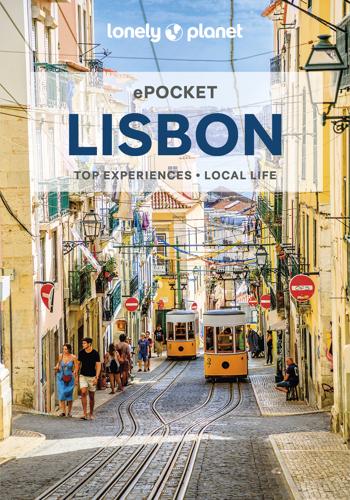
Lonely Planet Pocket Lisbon
by
Sandra Henriques
and
Joana Taborda
Published 15 Apr 2023
This happened in the early 1990s when workers began to lay the foundations for a parking garage. Since then, visitors have been guided through the guts of the building, discovering secrets of past civilisations. LONELY PLANET/GETTY IMAGES © map Google map www.fundacaomillenniumbcp.pt/nucleo-arqueologico yTop Tip AScan Lisboa Romana’s QR code on the pavement near the entrance to learn more about the city’s Roman past. AAncient Roman Galleries hide underneath nearby Rua da Conceição. Twice a year (April and September) this site, run by Lisbon City Council, is open to visitors. 5Take a Break AHead to Nicolau Lisboa (www.ilovenicolau.com) for all-day breakfast in a retro, aqua-green stylish setting.
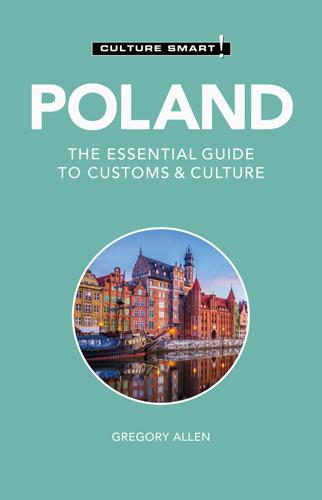
Poland - Culture Smart!
by
Allen, Gregory;Lipska, Magdalena;Culture Smart!;
Published 15 Jun 2023
If you’re unsure what to do, take your cue from the other passengers. It is also possible to buy single-or multiple-use tickets using apps (moBilet, mPay, SkyCash, zBiletem i jakdojade.pl); however, make sure to read the instructions on ticket validating carefully as some tickets require you to scan a QR code once on board. If you’re going to be in town for a long stint, weekly and monthly tickets are available at the kiosks or at any post office. Tickets are checked randomly by “undercover” ticket inspectors. Fines for traveling without a ticket are the only thing that is not cheap about Polish public transportation, so don’t take any chances.

Rome Like a Local
by
Dk Eyewitness
We definitely recommend renting two wheels for outside of the city centre, especially along the ancient Appian Way and along the banks of the Tiber, where things are much more relaxed. Lime, Tier and Dott rental bikes have a monopoly in Rome, with electric, pedal-assist bikes giving riders an extra boost. Simply find a bike (they’re dotted across the city), scan its QR code to unlock it and fully retract the cable lock in order to free up the wheels. There’s no need to return it to the same spot; just be sure to leave it somewhere sensible and remember to lock it again once you’ve finished your journey. www.li.me www.ridedott.com www.tier.app By public transport Rome’s public transport system, which is run by the ATAC, mainly comprises tramway, trolleybus, bus and metro lines.
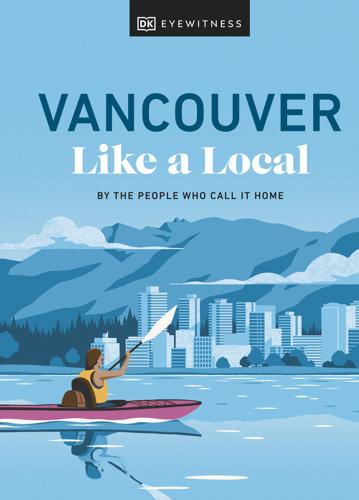
Vancouver Like a Local
by
Jacqueline Salomé
g Public Art g Contents Google Map THE WALL FOR WOMEN Map 1; 655 Burrard Street, Downtown; ///shark.thigh.observes The Wall for Women isn’t just an art piece – it’s a powerful message. This towering mural depicts a 42-ft- (13-m-) tall female figure, who represents a survivor of domestic abuse. The subject matter isn’t just implied symbolically. Hidden among the artwork’s Eastern European motifs (a trademark of the artist, Vancouver-raised Ola Volo) are six integrated QR codes. Scan each in turn to learn more about domestic abuse and donate to a local women’s housing project. (Hint: they’re largely found in the woman’s pant legs and in the heel of her shoe.) » Don’t leave without wandering over to the pink, basketball-inspired alley known as “Alley-Oop” at 668 W Hastings Street.
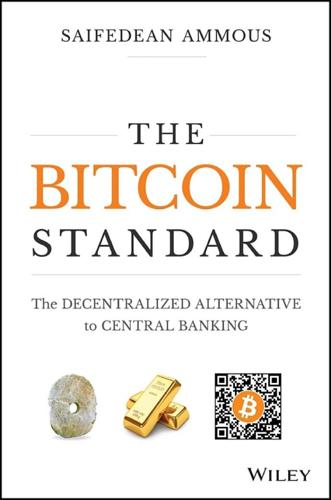
The Bitcoin Standard: The Decentralized Alternative to Central Banking
by
Saifedean Ammous
Published 23 Mar 2018
For more information about Wiley products, visit www.wiley.com. Library of Congress Cataloging‐in‐Publication Data is Available: ISBN 9781119473862 (Hardcover) ISBN 9781119473893 (ePDF) ISBN 9781119473916 (ePub) Cover Design: Wiley Cover Images: REI stone © Danita Delimont/Getty Images; gold bars © Grassetto/Getty Images; QR code/Courtesy of Saifedean Ammous To my wife and daughter, who give me a reason to write. And to Satoshi Nakamoto, who gave me something worth writing about. About the Author Saifedean Ammous is a Professor of Economics at the Lebanese American University and member of the Center on Capitalism and Society at Columbia University.
…
Anyone who joins the Bitcoin network generates a public address and a private key. These are analogous to an email address and its password: people can send you bitcoins to your public address while you use your private key to send bitcoins from your balance. These addresses can also be presented in Quick Response (QR) code format. When a transaction is made, the sender broadcasts it to all other network members (nodes), who can verify the sender has enough bitcoins to fulfill it, and that he has not spent these coins on another transaction. Once the transaction is validated by a majority of the CPU behind the network, it is inscribed onto the common ledger shared by all network members, allowing all members to update the balance of the two transacting members.

Radicals Chasing Utopia: Inside the Rogue Movements Trying to Change the World
by
Jamie Bartlett
Published 12 Jun 2017
Afghanistan—and then a similar experience working in Libya with rebels fighting Gaddafi—turned her into a fully committed anarchist who thought state power was the root of most of the world’s problems.17 In 2013 a former US military employee told her about bitcoin, and she immediately thought that it was a way to circumnavigate the state entirely. Bitcoin, which was invented in 2009, is digital cash, just a string of numbers. Anyone can download a bitcoin wallet or QR code on to their computer or phone, buy bitcoins with traditional currency from a currency exchange and use them to buy or sell a growing number of products and services as easily as sending an email. Transactions are secure, fast and free, with no central authority controlling value or supply, and no middlemen taking a slice.
…
All I had to do was agree with the Bitnation constitution, which is a twelve-line poem, and sign up on the site.22 I input my age, height and a photo, two witnesses watched and typed in their names, and that generated a ‘World Citizenship ID’. A ‘hash’ of this ID (a unique string of numbers that can be used, in conjunction with a key, to re-create the original file) was then uploaded onto a blockchain, where it will now stay, unchanged, forever. Here’s my QR code: Several services are available to the Bitnation citizen. As I was travelling across Europe with Tommy Robinson and Pegida UK, campaigning against Angela Merkel’s open stance toward refugees, Susanne was working on a project to help them. She realised most refugees had no ID, which meant they couldn’t prove who they were or access any services.

The Metaverse: And How It Will Revolutionize Everything
by
Matthew Ball
Published 18 Jul 2022
Without intermediaries, and because Tencent wanted to build up its social messaging network, WeChat offered tiny transaction fees: 0%–0.1% for peer-to-peer transfers and less than 1% for merchant payments, with no fees for real-time delivery or payment confirmations. And because this payment capability was built upon common standards (QR codes) and built into a messaging app, it was easy for everyone with a smartphone to adopt and use. WeChat’s success also helped Tencent build up the domestic video gaming industry, too, which would have otherwise been limited by the lack of credit cards across the country. In the West, these systems would normally be at the mercy of the hardware gatekeepers.
…
Traveler, 9 OnlyFans, 261 “on rails” experiences, 77 Open Handset Alliance (OHA), 212–13 OpenSea, 202, 301 open-source, 15, 136, 175, 212–13, 231–33, 287 OpenXR, 193, 287–88 Otoy, 223 Ovid, 5n ownership, 115, 128, 227 blockchains and, 217–18, 223, 227 entitlements as a façade, 59 interoperability and, 125, 128 records of, 10, 40–41, 124 unrestricted right to resale, 218 see also intellectual property; virtual goods Pac-Man, 8, 173, 183 Palm, 273 Pandora, 308 patents, 143–44, 154, 150, 282 payment rails, 164–67 ACH (Automated Clearing House), 168–71, 177, 188, 217, 226, 296 app stores and, 183–88 blocking blockchain, 199–202 CHIPS (Clearing House Interbank Payment System), 168–70 constrained virtual world platform margins, 191–93 digital first vs. physical first, 202–5 Fedwire, 168–70 high costs and diverted profits, 188–90 new, 205–6 peer-to-peer payment networks, 61, 171–72, 177 “programmable,” 208–9 Square’s Cash App, 172, 210 stopping disruptive technologies through, 193–99 Tencent’s WeChat, 205–6, 209, 214, 303–4 the 30% standard, 120, 172–80, 183–84, 186–92, 197, 201, 203–4, 286 today, 167–72 Visa, 167, 172–73, 184–85, 188, 199–200, 203, 217, 231 wire payments, 168–72, 177, 188, 217, 296 PayPal, 24, 62, 168, 171–72, 184–85, 203, 210, 216–17 paywalls, 15, 226 Peloton, 254–56, 258–59 personal computers, xiv, 22, 60, 64–65, 158–59 Pfizer, 166 Pichai, Sundar, 143, 239 pinching, 152–53 “pinch-to-zoom” concept, 149–50, 151 Pixar, 29–30, 36–37, 82, 89–90, 118, 136 Planet Labs, 119, 156–57, 275 PlayerUnknown’s Battlegrounds (PUBG), xiii, 91, 115–16, 117, 303 PlayFab, 107, 108, 117 PlayStation consoles, 32, 65, 81, 89–90, 92, 95, 112, 147, 162 GNMX APIs, 175 in-game billboards, 263 payment rails and, 173–77 real-time gaming chat in, 67 VR2 platform, 162 see also Sony PlayStation Network, 129, 132–35, 174, 280–82 Pokémon, 202 Pokémon Go, 115 Politiken, xiv Pong, 154–55 Population: One, 146–47, 268 PornHub.com, 261 privacy, 151, 197 “progressive decentralization,” 214 “Protocol Wars,” 42, 62, 129 Psyonix, 137 “Pygmalion’s Spectacles,” 5 QR codes, 206 “race to trust,” 285–86 racism, 129, 293–94 Rakuten, 136, 184 random-access memory, 97 reader apps, 184–85, 187, 190 Ready Player One, 21–22, 144 RealFace, 144 Rec Room, 115 Red Dead Redemption 2, 112 Reddit, 28, 229 refresh rate, 145–46, 162 remote learning, 34, 252 Renderman, 118 rent-seeking, 15, 299 Reporters Sans Frontières (Reporters Without Borders), 11, 258 resolution, 93, 98, 100, 145, 160–61 “revenge porn,” 292 “revenue leakage,” 134, 221 Riccitiello, John, 21, 158 Riot Games, 115 Rival Peak, 260 Robinhood, 28, 201 Roblox, 10–13, 77–78, 90–93, 108–18 Adopt Me!

Bank 3.0: Why Banking Is No Longer Somewhere You Go but Something You Do
by
Brett King
Published 26 Dec 2012
One of the primary reasons the credit card was invented was to give people with money the ability to increase the utility of that money by giving them a card that could be used to make a purchase, rather than their having to go to their bank to withdraw the necessary amount of cash. In the modern world, credit cards also enable them to act on impulse. Let’s look at another scenario. Tesco in South Korea created a virtual store in the subway where commuters can buy their groceries out of a virtual wall. Consumers only need to scan QR codes with their smartphones and products are added to their virtual cart and then delivered to their homes as soon as they are back. Figure 6.3: Tesco subway customer in South Korea ordering groceries on his phone Therefore the mobile’s real strength lies in the device’s ability to plug the individual into the utility of money in a way that is contextual to the purchase use case.
…
Ironically, the second viable technology utilising either an application IP-based or call-based solution is workable right now today, without any development of a supporting platform. There are already providers in the market that supply secure authentication utilising both methods without even the need for a POS terminal at all. We’ve discussed Square, PAYware, PayPalHere and others such as QR-code-based payment options already. Which of these two methods, i.e. NFC or phone-based, or application/call-based will come out on top? Neither. It will be a combination of the two, but over time the simplicity of NFC will win out for real-time interactions at the retailer’s store or at the train station, for example, whereas application technology will work for virtual stores.

The Business Blockchain: Promise, Practice, and Application of the Next Internet Technology
by
William Mougayar
Published 25 Apr 2016
Using Guardtime’s large scale keyless data authentication, in combination with a distributed ledger, citizens carry their ID credentials which unlock access to their healthcare records in real-time. From that point forward, the blockchain ensures a clear chain of custody, and it keeps a register of anyone who touches these records, while ensuring that compliance process is maintained.9 Other healthcare usages might include: Using a combination of multisignature processes and QR codes, we can grant specific access of our medical record or parts of it, to authorized healthcare providers. Sharing our patient data in the aggregate, while anonymizing it to ensure privacy is maintained. This is helpful in research, and for comparing similar cases against one another. Recording and time-stamping delivery of medical procedures or events, in order to reduce insurance fraud, facilitate compliance and verification of services being rendered.

CTOs at Work
by
Scott Donaldson
,
Stanley Siegel
and
Gary Donaldson
Published 13 Jan 2012
It was a spoof of “Star Wars,” and one of the things we did was about QR [quick response] codes. Suppose a device stopped working. Well, what I would normally have to do is go look at the device number, go log on. Basically, we had an app where you could take a picture of the QR code with your cell phone, and it would go into the asset management system, pull up the record, and then you could take a picture of your badge, which had a QR code on it, and then that would tell you who the submitter was. My advanced technology group team did a proof of concept of using facial recognition with a cell phone camera for authentication. So it allows things like this that you would never have been able to do before.

Imaginable: How to See the Future Coming and Feel Ready for Anything―Even Things That Seem Impossible Today
by
Jane McGonigal
Published 22 Mar 2022
The drones formed images reminding people to wear masks and spelled out slogans that promoted the government’s pandemic economic recovery policies. In Philadelphia and London, drone constellations sent messages of thanks to frontline and health care workers. And in 2021, in Shanghai, 1,500 drones created a massive illuminated QR code in the sky; onlookers could snap a photo of the code, which opened a website for a popular video game—perhaps the world’s first example of drone constellation advertising. Looking at these three clues, I can’t help but wonder: Will there be hate speech, harassment, and conspiracy theories via “sky media” in the future, the way they exist on social media today?
…
Other types of businesses are experimenting with zero-waste models today, in big and small ways that could add up to major transformation by the year 2033. Consider these further signals of change: In 2020, Starbucks, McDonald’s, and Burger King started testing reusable coffee cups and burger packaging. Customers in these trial runs were given five days to return the reusable containers, which had unique QR codes. Customers who didn’t return the containers within five days were automatically charged a fifteen-dollar “keep it” penalty. Trials of this kind have shown a 90–95 percent return rate so far.16 The fashion retailer Eileen Fisher will now buy back any item of used Eileen Fisher clothing, in any condition, for five dollars, to resell, repurpose as art materials, or donate to women in need.17 Meanwhile, IKEA recently opened its first-ever secondhand store, in Stockholm, where shoppers can buy used IKEA furniture.18 Most major brands and retailers will likely experiment with ways to extend the life cycle of their products.

X-T3 user guide
by
FUJIFILM Corporation
Published 10 May 2019
Highlight a language and press MENU/OK. 3 Pair the camera with the smartphone or tablet. Press MENU/OK to pair the camera with a smartphone or tablet running the FUJIFILM Camera Remote app. PAIRING REGISTRATION PAIR WITH SMARTPHONE? N To skip pairing, press DISP/BACK. IMAGES CAN BE EASILY TRANSFERRED TO SMARTPHONE BY PAIRING SCAN QR CODE OR SEARCH FOR "FUJIFILM Camera Remote" APP ON THE WEB SET SKIP HELP 41 2 First Steps and launch the latest version of the FUJIFILM Camera Remote App on the smart device before proceeding. For more information, visit: http://app.fujifilm-dsc.com/en/camera_remote/ 4 Check the time. When pairing is complete, you will be prompted to set the camera clock to the time reported by the smartphone or tablet.
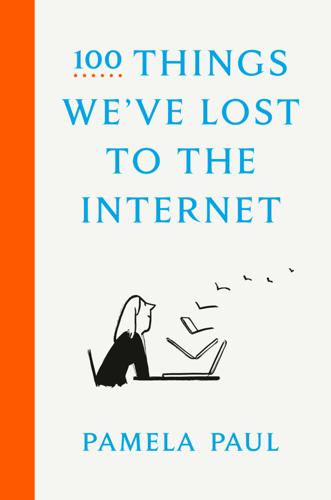
100 Things We've Lost to the Internet
by
Pamela Paul
Published 14 Oct 2021
Nor can you lose your speech or tear it up dramatically in front of a crowd because that, too, is on your phone, nor can you throw your ticket in the trash and be done with an obligation you wish you’d never agreed to in the first place. It’s hard to lose anything that exists as an image or block of text when it’s in the link and the attachment, and is always backed up. You have the automated confirmation. You have the scannable QR code. You took a screenshot of it because you were smart with your smartphone. One of life’s great and ever-repeated stressors is, blessedly, gone. Unless, of course, you lose your phone. [ 6 ] THE MEET-CUTE How many couples do you know who actually met for the first time in an elevator?

The Zero Marginal Cost Society: The Internet of Things, the Collaborative Commons, and the Eclipse of Capitalism
by
Jeremy Rifkin
Published 31 Mar 2014
Shoppers scan the bar code of the products they take off the shelves on their iPhone app before putting them in their shopping carts. When they are finished shopping, they press the “done” button and the app provides them with a custom QR (quick response) code. The self-checkout terminal scans the QR code on the smart phone, adds up the price of the items, and asks the customer to pick a payment option.26 Despite efforts by brick-and-mortar retailers to automate more and more of their operations to reduce their labor costs, they continue to lose ground to online retailers whose marginal labor costs are heading to near zero.
…
Behrokh, 96–97 Kickstarter, 256 Ki-moon, Ban 285 Koenig, Friedrich, 44 Konrath, Sarah, 280 Kuhn, Thomas, 9 Kümmel, Reiner, 71 Kurzweil, Ray, 84 Lamberth, Laurie, 74–75 Lange, Oskar, 5–7 last worker standing, 121–133 and the end of work, 121–128 even knowledge workers are expendable, 128–133 Latif, Majib, 288 laws of thermodynamics, govern all economic activity, 10–11 Layard, Richard, 277 Leontief, Wassily, 5, 105 Lessig, Lawrence, 175, 177–180, 185, 188 Lewis, James W., 281 Linux, 170, 175–176, 199, 309 live healthier lives, how to, 275 local exchange trading systems (LETS), 259–262 Locke, John, 60–62 Loescher, Peter, 14 The London Independent, 188 Lovelock, James, 184 L3C laws, 265 Luther, Martin, 58–59 Lymphangioleiomyomatosis (LAM), 241–242 Lynch, Mike, 129 Lynn, Mary Scott, 147 Makerbot Industries, 94 Makers Movement, 93–94, 99, 103 manufacture vs. infofacture, 90 marginal cost economy. see near zero marginal cost society Margulis, Lynn, 184 market economy, 4, 61 rise of the 32–38 Martin, Dean, 144 Marx, Karl, 33, 41, 105 massive open online courses (MOOCs), 4, 109–119, 247, 309–310 and the decline of the brick and mortar classroom, 113–119 negatives of, 117–118 the one-room schoolhouse with two billion students, 109–113 and peer-to-peer grading, 115–116 and service learning, 111–113, 264 and teachers as facilitators, 110 see also Coursera; edX; Udacity materialism/materialist(s), 276–279 mercantilist policies, 37 Mestrallet, Gérard, 141 microcurrencies, 259–262 microgrid(s), 103–104, 107, 294–295 microplot(s), 239 micropower plant(s), 69, 101, 102, 146, 267, 294–295 Millennial Generation, 19, 226, 230, 252, 264, 280–283 Mill, John Stuart, 63 Moglen, Eben, 175–176 monopoly or oligopoly, 6–8, 23, 198, 202, 307 and AT&T, 49–51 and effect on capitalism, 3 “natural monopoly,” 8, 50–51, 136–138, 203–204 temporary, 8 Montreuil, Benoit, 219–220 Moore, Gordon, 79–82 Moore’s Law, 79–80, 82, 147, 169 More, Sir Thomas, 31 Morgan Stanley, 54, 292 Mosaic, 146, 256–257 Moss, Frank, 242 music sharing, 232 Music Xray, 130 Myspace, 201 Napster, 170, 232 National Human Genome Research Institute, 169 Resources Defense Council (NRDC), 147 Science Foundation, 96 Telecommunications and Information Administration (NTIA), 149 near zero marginal cost society, 68–151 ascent of the prosumer and the build-out of the smart economy, extreme productivity, the Internet of Things, and free energy, 69–87 getting closer to, 84–87 the last worker standing, 121–133 and marginal cost controversy, 135–138 MOOCs, 109–119 reluctance to come to grips with, 5 3D printing, 89–108 see also paradigm shift from market capitalism to Collaborative Commons network neutrality, 197–198, 203 The New Capitalist Manifesto (Haque), 253 Networked Commons, 119, 151, 173, 190, 194, 202, 212, 221, 222, 229–233, 237–241, 309 Newmark, Craig, 249 The New York Times, 5, 129, 251, 281 Noam, Eli, 151, 194 Northern Renaissance, 36, 300 Noubel, Jean-Francois, 262 Obama, President Barack, 71–72, 128 Occupy Movement, 57 oil cost of, 87, 137–138, 233 crude oil reserves are dwindling, 86–87 and infrastructure, 72 mass production of automobiles, effect on, 52–53 and the Second Industrial Revolution, 47–54 spills, 165, 290 Standard Oil Company, 48–49, 51 see also fossil fuel(s); Hall, Andy online higher education. see massive open online courses (MOOCs) Open Source Initiative (OSI), 176 “optimum general welfare,” 3 Organization for Economic Co-operation and Development (OECD), 21, 277 The Origin of Species (Darwin), 64 Ostrom, Elinor, 158–162, 175, 190 Paine, Thomas, 65 paradigm shift from market capitalism to Collaborative Commons, 1–25 and changing the economic paradigm, 9–11 and the Internet of Things, 11–16 and the rise of the Collaborative Commons, 16–25 Parkifi, 145–146 Patagonia, 263 patent(s), 138, 165–167, 170, 174–177, 180–181, 202 patient-driven research (PDR), 19, 240–247 peer-to-peer social lending, 255–257 Perens, Bruce, 176 Perlow, Jason, 128 Perry, Mark J., 122–123 Personal Genome Project, 180 The Philosophy of Money (Simmel), 259 phone, importance of, 49–51 population, key to stabilization of, 285 poverty, 21, 107–112, 209, 264, 275–278, 283–286 print, and the impact it had on the way we do business, 35–36, 178–179 printing press(es), 33–37, 44–45 privacy, age of, 75–77 property relations, notion of, 30–32 prosumer(s) ascent of the, 135–151 beyond governments and markets, 150–151 and the clean web, 144–147 definition of, 4, 90 and free wi-fi for everyone, 147–149 and power to the people, 138–144 protests to reclaim the public Commons, 187–188 QR code, 127 Quigg, Donald J., 166 rallying around free software, 174–177 Raspberry Pi, 80 Raymond, Eric S., 176–177 RelayRides, 228 rental(s)/renting. see social capital and the sharing economy reputation rankings on the web, 257–259 reviews, consumer-generated, 248–249 Rifkin, Milton, 305–306, 309 rise in collaborative innovation, 21 Rochdale Society of Equitable Pioneers, 212–213 Rockefeller, John D., 48–49 Rose, Carol, 157–158 Rowe, Jonathan 190 Royal Dutch Shell, 49, 54, 142 Ruben, Andy, 237–238 Rural Electric Administration (REA), 209–210 Say, Jean-Baptiste, 3 Say’s Law, 3 scarcity. see abundance Schelgel, Heather, 262 Scherzer, Norman, 243 Schlatter, Richard, 30, 62 Schor, Juliet, 280 Schumacher, E.
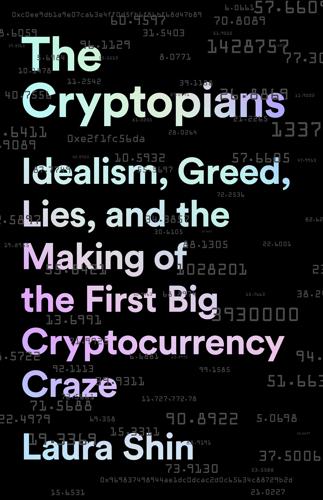
The Cryptopians: Idealism, Greed, Lies, and the Making of the First Big Cryptocurrency Craze
by
Laura Shin
Published 22 Feb 2022
To lighten things up, they got bikes, and on the middle floor, Mihai and Roxy’s friend Lorenzo Patuzzo, the carpenter, built a wall to create an extra bedroom that, during the day, functioned as a family room where they would watch Game of Thrones. They also had weekly barbecues that were sometimes drunken affairs but not extravagant. Since most of them were broke and no one was being paid, on the door they put a Bitcoin QR code at which they could receive coins for beer money. Once, when a Bitcoin Suisse employee brought a whole case of beer, they were so happy, they gave him a promissory note for four thousand ether. But soon, tensions in the house began to rise past the normal annoyances of living and working together.
…
He made a digital version of a “paper wallet,” a list of one’s private keys on actual paper; his version was a website with one input field for a password to encrypt the private key and one button to generate the address.6 (A cryptocurrency address, or public key, is like a front slot on a mailbox that only allows people to put money in; the private key is needed to send money out.) The site output both encrypted and unencrypted versions of the user’s private key, plus QR codes for the address and private key. Since MyEtherWallet did not hold people’s coins, it also did not record users’ passwords—safekeeping those was up to them. If a user lost a password, his or her money was gone forever. Knowing his limitations, Kosala begged Taylor to help him design the site. Four days later, while she was celebrating her birthday on a boat near Catalina Island and he was in Los Angeles, they tried domain names on GoDaddy, but some were really expensive, like $200.
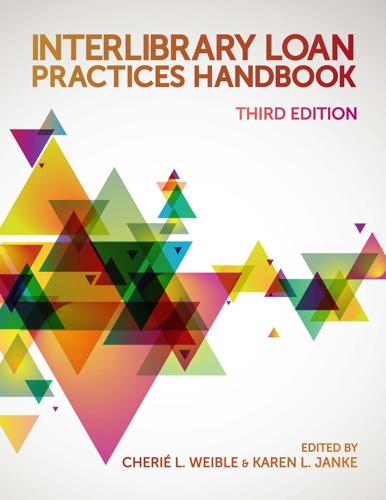
Interlibrary Loan Practices Handbook
by
Cherie L. Weible
and
Karen L. Janke
Published 15 Apr 2011
This collection presents a complete view of the interlibrary loan (ILL) process, with contributions from all areas of the technical services community, providing • Guidance on how to do ILL efficiently and effectively, with advice on being a considerate borrower and lender • Details of preferred staffing and management techniques, showing how best practices can be implemented at any institution • Discussion of important issues that can fall between the cracks, such as hidden copyright issues, and the logistics of lending internationally As consortia and other library partnerships share ever larger fractions of their collections, this book gives library staff the tools necessary for a smoothly functioning ILL system. InterlibrarY Loan Practices handbook, 3rd Ed. You may also be interested in InterlibrarY Loan Practices handbook Third Edition Weibleâ•… /â•… Janke American Library Association / alastore.ala.org 50 E. Huron Street, Chicago, IL 60611 1 (866) SHOPALA (866) 746-7252 Scan this QR code to go to the ALA Online Store from your smartphone (app required). ISBN 978-0-8389-1081-8 9 780838 910818 Edited by Cherié L. Weible & Karen L. Janke

The Purpose Economy: How Your Desire for Impact, Personal Growth and Community Is Changing the World
by
Aaron Hurst
Published 31 Aug 2013
They are creating the infrastructure to support sustainable products at a massive scale. The market-moving power of TSC is tremendous—together they employ well over fifty-seven million people and their combined revenues total over $1.5 trillion.7 The goal is eventually to communicate this information directly to consumers through a product label or scannable QR code, much like the nutrition labeling that is required in many markets today. In the not-so-distant future, when buying a T-shirt, laundry detergent, or even wine, consumers will be able to make informed choices in a much more standardized way than they can now. And though the sustainable goods market is now crossing over to the more risk-averse populations, there is still much more work to be done before it can reach the hardest-to-reach groups.

Who Is Government?: The Untold Story of Public Service
by
Michael Lewis
Published 18 Mar 2025
Rosemary Freitas Williams, a former assistant secretary of public affairs at VA, told me that joining the civil service is basically like being in the Witness Protection Program: “No one ever knows about the good you do.” Williams came to the federal government after 22 years in broadcast journalism, and she couldn’t believe how little attention people such as Walters get for all their innovative work. “This guy wanted to put QR codes on headstones, so anybody could walk into a national cemetery and learn some veteran’s story of service and heroism with their smartphone,” she told me. “I felt like it could change everything: the way we grieve, the way we learn history. I was just stunned. NCA still uses fax machines for forms, not all the workforce has an email address, but Ron got the Veterans Legacy Memorial going.”
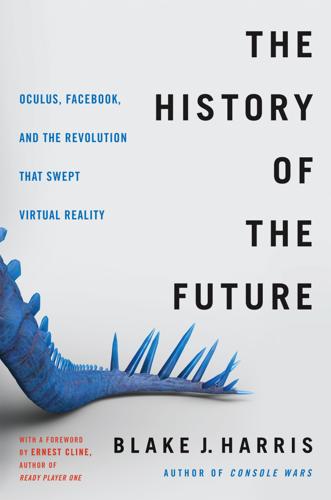
The History of the Future: Oculus, Facebook, and the Revolution That Swept Virtual Reality
by
Blake J. Harris
Published 19 Feb 2019
So as much as he admired Abrash, and knew Abrash to be above technological exaggeration, Iribe was skeptical that Valve had put together a demo that wouldn’t turn his stomach. That skepticism heightened when Abrash brought him into a small, low-ceilinged room that was empty save for the following: Dozens of black-and-white QR-code-like fiducial markers plastered up and down the wall A bulky headset with exposed circuit boards and loose cables A man seated in the corner of the room, sitting behind a computer: Atman Binstock “I’m going to run you through the demo,” Binstock explained, then typed a few commands into his computer and suddenly—whoosh!
…
In contrast to the “seated experience” that the Oculus Rift would offer, the HTC Vive promised a “room scale experience”—allowing users to move freely around an environment of up to 15 x 15 feet. In this respect, the Vive appeared to be almost like a next-gen version of the “Valve Room”; and this time, instead of all those crazy QR codes, the Vive needed only a pair of “SteamVR base stations” to track an entire room. “But that’s not all . . .” announced HTC’s Executive Director of Global Marketing, after following Chou on stage. “We realize that the promise of virtual reality only truly becomes real when we can put product in the hand of consumers.

Robots Will Steal Your Job, But That's OK: How to Survive the Economic Collapse and Be Happy
by
Pistono, Federico
Published 14 Oct 2012
Picture yourself in Korea going to work. You have got a few things to buy for dinner, but have no time. So you take the subway, and while waiting for the next train to arrive you see the walls covered with displays that look exactly like a supermarket. Just grab your cell phone, chose what you want, scan the QR code, checkout. When you come back home, you will find your grocery delivered on your doorstep. Quite convenient, is not it? Here are the results of the experiment that took place last year: online sales between November 2010 and January 2011 increased by 130%, with the number of registered members rising by 76%.
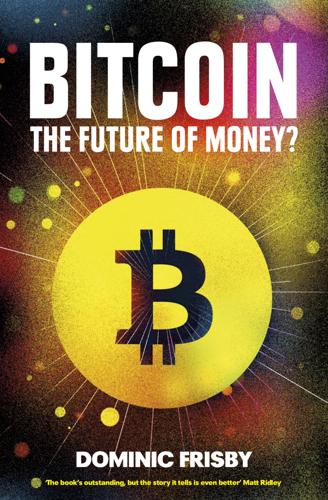
Bitcoin: The Future of Money?
by
Dominic Frisby
Published 1 Nov 2014
Satoshi tends to use British spellings – so the American ‘labor’ or ‘flavor’ will be ‘labour’ and ‘flavour’; the American ‘modernize’ or ‘formalize’ will be ‘modernise’ and ‘formalise’114 – although he is inconsistent in this regard. For example, ‘decentralized’ is sometimes spelt with a ‘z’. In UK English, either is acceptable. Several times he refers to a ‘mobile’ rather than the American ‘cell phone’. For example, ‘The cash register displays a QR-code encoding a bitcoin address and amount on a screen and you photo it with your mobile.’115 He says ‘maths’ not the American ‘math’.116 He refers to ‘flats’ rather than ‘apartments’.117 Consider the following quote from Satoshi: ’Sorry to be a wet blanket. Writing a description for (Bitcoin) for general audiences is bloody hard.

The Best Interface Is No Interface: The Simple Path to Brilliant Technology (Voices That Matter)
by
Golden Krishna
Published 10 Feb 2015
,” CNN, April 30, 2012. http://earlystart.blogs.cnn.com/2012/04/30/whats-trending-want-to-know-how-attractive-you-are-theres-an-app-for-that/ 23 Eoghan Macguire, “Save the Whales? There’s an App for That,” CNN, April 23, 2012. http://edition.cnn.com/2012/04/22/world/whale-iphone-app/index.html 24 “Dead? There’s an App for That,” CNN, April 18, 2012. http://www.cnn.com/video/?/video/us/2012/04/18/dnt-in-qr-code-tombstones.wlfi&iref=allsearch&video_referrer= 25 Paromita Shah, “Opinion: Being Arrested? Yes, there’s an App for That,” CNN, March 17, 2012. http://inamerica.blogs.cnn.com/2012/03/17/opinion-undocumented-immigration-being-arrested-app-for-that/ 26 Sanjay Gupta, MD, “Are You Sick? There’s an App for That!
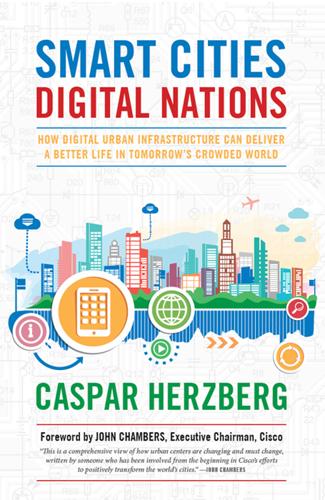
Smart Cities, Digital Nations
by
Caspar Herzberg
Published 13 Apr 2017
Bangalore’s workforce of 8,500 is young indeed, the single greatest concentration of Generation Y and Millennials in the global company. The “seamless” experience of IT applies here in a quality of work/life balance. The campus is open; workstations can be assigned by an employee’s preference for a particular day (as well as monitored for light, temperature, and other features) via personal devices and QR codes. Rather than unyielding forests of cubicles, employees can choose to work in gardens or conduct meetings in gaming centers or telepresence rooms. With an intramural system keeping track of the “reservations” for workspace, the campus is able to maximize space usage (it stands at approximately 58 percent as of late 2014).4 Bangalore’s promise lies in its combination of fluidity and density.

Gigged: The End of the Job and the Future of Work
by
Sarah Kessler
Published 11 Jun 2018
The chapters of this book alternate between five of their stories. It’s not intended to be a complete, bird’s-eye view of the gig economy. Any economy is built by humans, and this book is about them. PART I THE END OF THE JOB CHAPTER 1 A VERY OLD NEW IDEA At South by Southwest 2011, the napkins featured QR codes. Flyers rained down from party balconies, and the grilled cheese—provided by group messaging app GroupMe—was free. Startups looked forward to the tech-focused “Interactive” portion of the famous music festival in Austin, Texas, like a popular high school student looks forward to the prom. One of the new companies among them, it was widely assumed, would be crowned a “breakout hit,” just as Twitter had once “broken out” by introducing its app to the tech-savvy SXSW crowd.
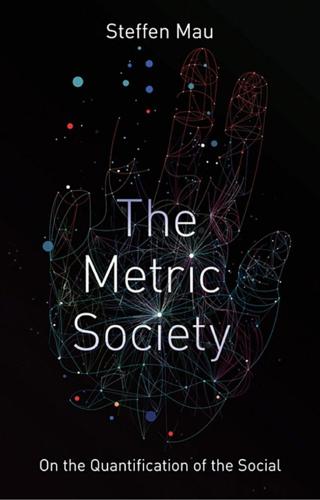
The Metric Society: On the Quantification of the Social
by
Steffen Mau
Published 12 Jun 2017
Giving the thumbs up or down, allocating marks or scores and compiling league tables, as opposed to describing, weighing up or simply absorbing impressions. Examples are legion: every day, we are prompted to rate the cleanliness of public toilets, the quality of hotel breakfast buffets (with eight subcategories) or the friendliness of taxi drivers. Passengers on the Deutsche Bahn are invited by a scannable QR code sticker on the seat in front of them to ‘Please rate your journey with us today’. In public places – whether at the bank or in the airport customs queue – we find more and more HappyOrNot terminals (‘Our Smileys for your business – because happy customers inspire change’) where we can register our satisfaction or dissatisfaction by pressing a button.
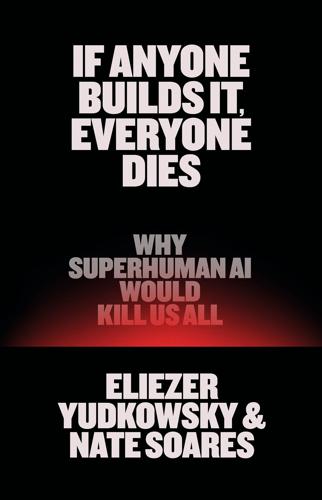
If Anyone Builds It, Everyone Dies: Why Superhuman AI Would Kill Us All
by
Eliezer Yudkowsky
and
Nate Soares
Published 15 Sep 2025
Why isn’t the world taking more note? What could society do differently, if enough of us decide not to die? What would it take for Earth to not build machine superintelligence? An online supplement to this book is available at the website IfAnyoneBuildsIt.com. At the end of each chapter you’ll find a URL and a QR code that links you to a supplement for that chapter. It will look like this: IfAnyoneBuildsIt.com/intro People have all sorts of conflicting intuitions about artificial intelligence, and we’ve heard a wide variety of questions and objections over the years, coming from a wide range of presuppositions and viewpoints.
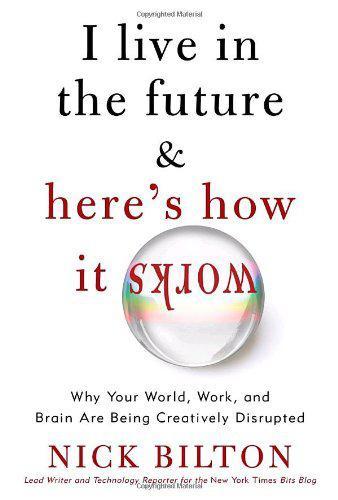
I Live in the Future & Here's How It Works: Why Your World, Work, and Brain Are Being Creatively Disrupted
by
Nick Bilton
Published 13 Sep 2010
Online, through a computer or smart phone, you can access additional content for each chapter: videos, links to articles and research, and interactive experiences that enable you to delve deeper into the topics covered in that chapter, taking you beyond the printed page. At the beginning of each chapter you will see an image called a QR Code, just like the one above. Using a free application you can download from nickbilton.com you will be able to snap an image of these codes that will then take you to the additional content directly on your mobile phone. Become part of the I Live in the Future community by commenting on chapters of interest and joining a continuing discussion with me and your fellow readers online at nickbilton.com and with the free I Live in the Future app for iPhone and iPad.

Makers
by
Chris Anderson
Published 1 Oct 2012
The Homebrew Printing Club This all started in industrial tooling companies in the 1980s, but over the past decade the technology has spread to regular folk, just as the PC did. To see how, take the subway to an otherwise undistinguished part of Third Avenue in Brooklyn, and knock on the metal door with the big mobile-phone readable QR code on it. Wait for some stylishly disheveled young man to open it and let you in. Welcome to the Botcave. In this converted brewery, Bre Pettis, Zach Smith, and their team of hardware engineers at MakerBot Industries are making the first mainstream $1,000 3-D printers. Rather than using a laser, the MakerBot Thing-O-Matic printer builds up objects by squeezing out a 0.33-mm-thick thread of melted ABS plastic, which comes in multi-colored reels.

Death Glitch: How Techno-Solutionism Fails Us in This Life and Beyond
by
Tamara Kneese
Published 14 Aug 2023
In smart home hauntings, nostalgia for the deep past collides with ghostly futures. As objects and structures become smarter, the data of the dead will become more entwined with their physicality. Despite careful engineering, networked objects rely on constant upkeep on the part of humans and physical infrastructures to survive. Once the QR codes, operating systems, and URLs become obsolete, leaving behind a trail of error messages, perhaps only the once-smart objects will remain. In the end, the inherent vice of digital technologies is a saving grace. Data—no matter how carefully collected, harnessed, and deployed—do not offer true salvation.

The Dark Cloud: How the Digital World Is Costing the Earth
by
Guillaume Pitron
Published 14 Jun 2023
Parts of your identity could be spread across an incalculable number of data centres around the world, without you having the faintest idea of what it is used for. You are putting a finger into a vast machine with no understanding of its parts, let alone its purpose. In 2018, the mighty American Civil Liberties Union (ACLU) warned against the true intentions of e-scooter rental companies: ‘When you scan a QR code, you are unwittingly hopping onto a two-wheeled data-hoarding device that is collecting far more of your personal information than the product really needs.’29 The issue is so serious, in fact, that non-profits have recently worried that all sorts of positioning data could be used by governments for surveillance purposes.
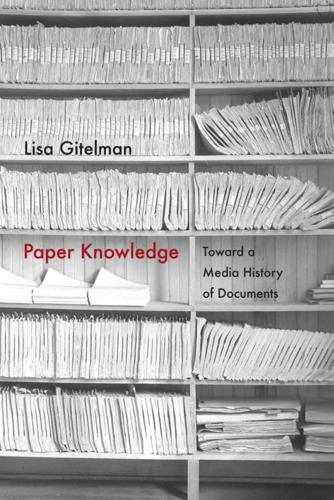
Paper Knowledge: Toward a Media History of Documents
by
Lisa Gitelman
Published 26 Mar 2014
Universal product codes (upc ), often referred to as barcodes, and quick response (qr ) codes (matrix or two-dimensional barcodes) work as a sort of inverse in alignment with captcha , since barcodes are specifically designed for “the algorithmic eyes” of a machine and not for human eyes, while they additionally position users as the subjects of databases as well as of systems, institutions, and bureaucracies.88 Indeed, pattern codes like these represent an endgame of sorts for the genre of the document, a displacement of docer into the realm of the machine: not the end, but rather an end imagined within the repertoire of the so-called posthuman. Scan the barcode on a product label or the qr code on an airline boarding pass, and the know-show function of the document in question is in a sense self-allegorized by numerical processing within the relevant system architecture.89 Not quite text (from a reader’s standpoint) and not entirely image (at the scanner), barcodes like these require a fixity that makes them perfect content for pdf s as well as for paper.
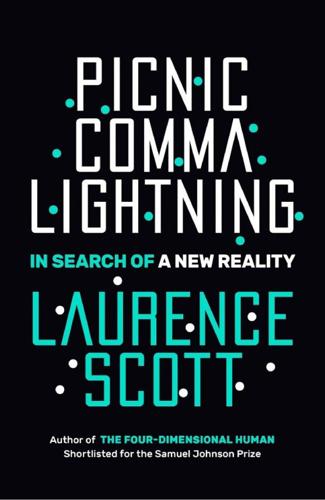
Picnic Comma Lightning: In Search of a New Reality
by
Laurence Scott
Published 11 Jul 2018
In this gap between attraction and repulsion, we can feel the fluidity of our desires, their exquisite feebleness, and our own lack of both will and ability to be transported fully into the past. On one of these walking tours in particular, as a different collection of mortals straggle around Hodge, I see that the plinth bears a new sign. He has been enrolled in a ‘Talking Statues’ scheme. If you scan the QR code on the sign, you will receive a phone call. The cat will explain himself, in the meowing voice of Nicholas Parsons. Rather than being aloof, the statue has arrived in the present with a revived neediness. ‘Take a good15 look at me,’ he purrs, ‘examine my expression.’ In one sense, Parsons is taking over the job of our guide, an example of automation undermining the need for real-life, taxpaying workers.

Super Founders: What Data Reveals About Billion-Dollar Startups
by
Ali Tamaseb
Published 14 Sep 2021
There are plenty of founders like the Collison brothers—those whose earlier endeavors didn’t hit $10 million but who capture the basic essence of a Super Founder anyway, and hence why the $10 million bar should not be taken literally. Vijay Shekhar Sharma, founder of Paytm, the multibillion-dollar Indian payment app that allows users to pay using QR code, had started a news and content website in college; it was later acquired for $1 million. Before founding Spotify, the popular music-streaming service, Daniel Ek built an online advertising company in Sweden that he sold for $1.5 million. More than just selling companies, Super Founders share a bent toward building things and putting their backs into their ideas.

Cloudmoney: Cash, Cards, Crypto, and the War for Our Wallets
by
Brett Scott
Published 4 Jul 2022
Two of these companies are Alibaba and Tencent, and both have colossal payments divisions – Alipay (Ant Financial) and WeChat Pay. These mobile payments systems have made dramatic strides within China, and today are ubiquitous there. The WeChat app is like a multi-purpose Facebook with payments built in. Western media have fixated upon the fact that even beggars in Shanghai carry QR codes to receive WeChat payments, illustrating how it reaches into the most marginalised corners of society. But what happens if only two companies have a chokehold on the Chinese mobile payments space? Do they become huge honeypots of critical personal data? Well, yes. The Chinese central bank – the People’s Bank of China – can gain access to the online payments data of people who use both platforms, and has set up the Nets Union Clearing Corp to get more oversight of mobile payments: normally mobile payments companies plug into the banking system in the background, but in this system they plug directly into the central bank.

Bitcoin Billionaires: A True Story of Genius, Betrayal, and Redemption
by
Ben Mezrich
Published 20 May 2019
One thing was for sure, this wasn’t some startup in the Valley looking to court seed funding from the cabal of pleated khaki pants on Sand Hill Road—this was different. “Bitcoin, the digital currency, with a lowercase b,” Voorhees said, pointing to the miniature barrel. “As Charlie implied, you send bitcoin with a lowercase b from your digital wallet to the address embedded in the QR code printed on the side of the can. It’s that simple, but that’s only a tiny part of the story.” Cameron knew from his research that the first documented time bitcoin had ever been used to purchase a product happened on May 22, 2010. On that historic day, a Florida programmer named Laszlo Hanyecz was hungry for pizza and had decided he would use some of the bitcoin he’d accrued to quash his hunger; there was only one problem: no merchants accepted bitcoin as payment at that time.

Volt Rush: The Winners and Losers in the Race to Go Green
by
Henry Sanderson
Published 12 Sep 2022
His face made clear that any further questions were unnecessary. He pointed to the car park and told me to head off. No one showed us to the car or told us how it worked. ‘Thank you for accelerating the transition to sustainable energy,’ a notice said. My father and I walked out into the cold, found our car and entered with some trepidation. I had to scan a QR code and grapple with the large touch screen, which immediately checked for a software update. I grabbed a young man who was walking by to get his help. I asked where the back windscreen wiper was and he laughed. ‘Teslas don’t have those,’ he said. Then off I went, silently, as if something was missing.

Fodor's Big Island of Hawaii
by
Fodor’s Travel Guides
Published 1 Aug 2022
The online program required passengers to upload proof of a negative COVID test or proof of vaccination, both of which allowed you to bypass 5-day quarantine. The pre-travel test (from approved labs) had to be taken 72 hours prior to departure and then uploaded as a PDF file into the Safe Travels website. A QR code was then emailed to you. Travelers were also advised to bring a printed copy of their test result or actual vaccine card with them on their flight, as well. At this writing, there are no state restrictions for interisland travel. A COVID-19 pre-travel test or quarantine is not required for traveling between islands, regardless of vaccination status.

Principles of Corporate Finance
by
Richard A. Brealey
,
Stewart C. Myers
and
Franklin Allen
Published 15 Feb 2014
The biggest change in this edition is not to the printed text but to the Beyond the Page digital extensions and applications (see Pedagogical Features, below). These pieces are an integral part of the e-versions of the book, but they are also easily accessible via the Web using the QR codes and shortcut URLs provided. They provide additional examples, applications, spreadsheet programs, and opportunities to explore topics in more depth. BEYOND THE PAGE ● ● ● ● ● Principles of corporate finance mhhe.com/bma The QR codes are easy to use. First, use your smartphone to download any QR-enabled barcode reader from your provider’s marketplace. Focus your smartphone’s camera on any code in the book, and you’ll be able to access the online chapter content instantly.
…
Students can learn how to solve specific problems step-by-step and apply key principles to answer concrete questions and scenarios. “Beyond the Page” Interactive Content and Applications New to this edition! Additional resources and hands-on applications are just a click away. Students can scan the in-text QR codes or use the direct Web address to learn more about key concepts and try out calculations, tables, and figures when they go “Beyond the Page.” Excel Treatment Spreadsheet Functions Boxes These boxes provide detailed examples of how to use Excel spreadsheets when applying financial concepts.
…
This site contains information about the book and the authors as well as teaching and learning materials for the instructor and student, including: • “Beyond the Page” content A wealth of additional examples, explanations, and applications are available for quick access on the website. Each “Beyond the Page” feature is called out in the text with a QR code or icon that links directly to the OLC. • Excel templates There are templates for select exhibits, as well as various end-of-chapter problems that have been set as Excel spreadsheets—all denoted by an icon. They correlate with specific concepts in the text and allow students to work through financial problems and gain experience using spreadsheets.

Trick Mirror: Reflections on Self-Delusion
by
Jia Tolentino
Published 5 Aug 2019
The story broke in another enormous schadenfreude tsunami, with the joke falling first on the Mast Brothers and then, ultimately, as it always does, on the dummies who bought their product. This is what you gentrifiers get with your hard-ons for artisanal garbage! the tweets and blog posts cackled. This is what you Instagram addicts get for paying three months’ rent money for a festival no one had ever heard of! This is what you get for being so rich that you need a QR code to make a glass of fucking juice! Right around this vicious and satisfying point in the scam news cycle, popular identification often begins to slide toward the scammer, who, once identified, can be reconfigured as a uniquely American folk hero—a logical endpoint of our national fixation on reinvention and spectacular ascent.
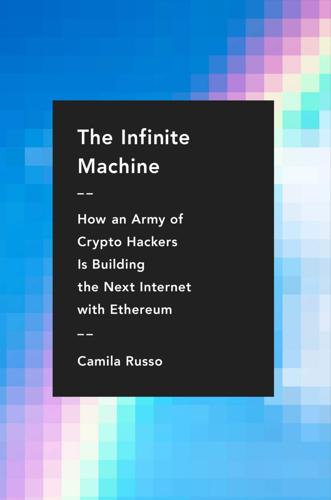
The Infinite Machine: How an Army of Crypto-Hackers Is Building the Next Internet With Ethereum
by
Camila Russo
Published 13 Jul 2020
Step 4 told him to “move his mouse around the screen to generate a random wallet, and once you’re done you will be moved on to the next screen.” “This is so weird,” he thought, as he complied, his anxiety surging when he realized there was no back button. Next he clicked on a button that downloaded an Ethereum wallet to his computer, and then there was a Bitcoin wallet address and QR code for him to send his bitcoin to. He went to his Bitcoin wallet, copied the address—a jumbled-up string of numbers and letters—and letting out a muffled scream, “Aaaahhh!” he clicked send. And just like that, he had parted with half of his perfectly good bitcoin, which were now traveling into some cryptographic maze.

The Unusual Billionaires
by
Saurabh Mukherjea
Published 16 Aug 2016
With the emergence of digital banking, Axis Bank is also preparing to take on the new breed of payment banks whose founders, most prominently, Vijay Shekhar of Paytm, are active on social media. Anand, the head of retail banking at Axis Bank, is active on Twitter with more than 5000 followers. I also noticed a QR code for downloading the Axis Bank mobile app strategically placed on the reverse side of employee visiting cards! In the same vein, the bank’s brand strategy in corporate banking has been aligned with the business strategy of projecting the bank as an integrated universal bank. The Axis Bank brand is an overarching brand taking precedence over any other brand within it and all of them have been aligned with a uniform branding linked with Axis Bank.

Essential: How the Pandemic Transformed the Long Fight for Worker Justice
by
Jamie K. McCallum
Published 15 Nov 2022
While many aid networks were led by nonessential volunteers, essential workers also formed mutual aid associations that served the common good even beyond their paid jobs. This activism first emerged in the same place the virus did. In 2018, a Beijing-based delivery driver who went by the pseudonym Xiong Yan attached a unique QR code to the back of his moped. When a driver scanned it, they would be automatically added to a secret group chat on an app beyond the boss’s panoptic eye. The welcome message: “Aims: solidarity, mutual assistance, friendship, determination, sharing, and winning together.” “No matter if you ride for Ele.me or for Meituan, for Fengniao, Shansong, Dada, or Shunfeng, we’re all in the same hustle.”6 The Drivers’ Alliance, a mutual aid network for delivery workers, was born.

This Is for Everyone: The Captivating Memoir From the Inventor of the World Wide Web
by
Tim Berners-Lee
Published 8 Sep 2025
First published 2025 by Macmillan This electronic edition published 2025 by Macmillan an imprint of Pan Macmillan The Smithson, 6 Briset Street, London EC1M 5NR EU representative: Macmillan Publishers Ireland Ltd, 1st Floor, The Liffey Trust Centre, 117–126 Sheriff Street Upper, Dublin 1 D01 YC43 Associated companies throughout the world ISBN 978-1-0350-2370-7 Copyright © Tim Berners-Lee 2025 Cover image © iStock The right of Tim Berners-Lee to be identified as the author of this work has been asserted in accordance with the Copyright, Designs and Patents Act 1988. Pan Macmillan does not have any control over, or any responsibility for, any author or third-party websites (including, without limitation, URLs, emails and QR codes) referred to in or on this book. This book is sold subject to the condition that it shall not, by way of trade or otherwise, be lent, hired out, or otherwise circulated without the publisher’s prior consent in any form of binding or cover other than that in which it is published and without a similar condition including this condition being imposed on the subsequent purchaser.

You've Been Played: How Corporations, Governments, and Schools Use Games to Control Us All
by
Adrian Hon
Published 14 Sep 2022
Qian Sun, “Suzhou Introduced a New Social Scoring System, but It Was Too Orwellian, Even for China,” Algorithm Watch, September 14, 2020, https://algorithmwatch.org/en/story/suzhou-china-social-score. 12. “A Chinese City Withdraws ‘Civility Code’ Following Online Criticism.” 13. “Circular on Using SZ QR Code for Prevention and Control of COVID-19, and Procedures for Application,” Xi’an Jiaotong-Liverpool University, accessed November 28, 2021, www.xjtlu.edu.cn/en/novel-coronavirus-pneumonia/government-notices/procedures-for-application-of-suzhou-health-code. 14. Qian Sun, “Suzhou Introduced a New Social Scoring System, but It Was Too Orwellian, Even for China.” 15.
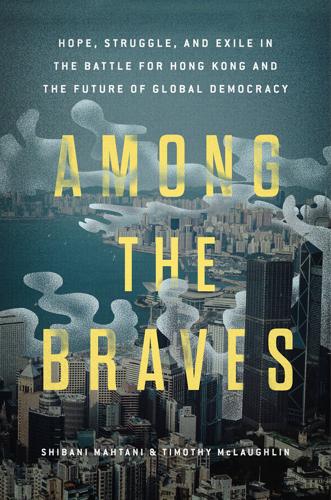
Among the Braves: Hope, Struggle, and Exile in the Battle for Hong Kong and the Future of Global Democracy
by
Shibani Mahtani
and
Timothy McLaughlin
Published 7 Nov 2023
Above the images, translated into nine languages, were variations of the same appeal: “Bear witness to Hongkongers’ fight for freedom. Tell our story—especially if we can no longer do it ourselves. Fight for Freedom. Stand with Hong Kong.”13 Those trying to look for the group behind the campaign wouldn’t have found much. A QR code printed on the ads linked back to a website called freedomhkg.net, created by a “group of Hongkongers from all walks of life, living in Hong Kong and across the world.” On the website, they offered only the explanation that they had raised over $1.5 million from 20,000 donors to fund the ad campaign.
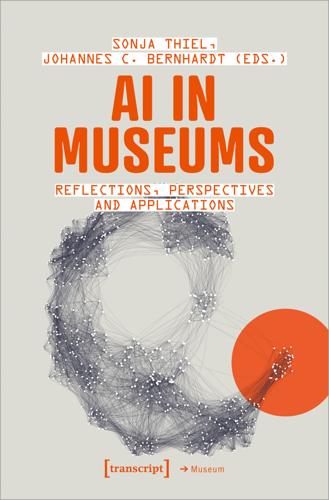
AI in Museums: Reflections, Perspectives and Applications
by
Sonja Thiel
and
Johannes C. Bernhardt
Published 31 Dec 2023
Chat with Six Femmes Fatales—Insights into the Results The chats were made accessible free of charge via the museum’s mobile application.6 The application, like a messenger service, lists all the characters with their respective profile picture as well as status updates written by the students (see fig. 2). In addition, QR codes were positioned next to the artworks throughout the exhibition, 6 See https://www.hamburger-kunsthalle.de/en/app. Melanie Fahden and Anja Gebauer: With AI to Art! and scanning them opened chats directly in a browser. All six fictional characters greeted users with a distinct form of address and submitted different introductory and follow-up questions (How are you?

Digital Gold: Bitcoin and the Inside Story of the Misfits and Millionaires Trying to Reinvent Money
by
Nathaniel Popper
Published 18 May 2015
Mark would later say that during this time he was spending his daylight hours at the office and his nights at his apartment, alone with his cat Tibanne, furiously working his way through hundreds of pieces of paper containing the private keys to Mt. Gox’s Bitcoin wallets. He had driven around in his car and collected the papers from the three locations in Tokyo where he had stored them (he had kept the keys on paper so they would not be vulnerable to hackers). Once he was back in his apartment with the QR codes—essentially complex bar codes—he began scanning in the private keys one at a time, with his computer’s webcam. A combination of fear and sickness slowly overtook him as each one of the wallets he scanned in showed up on his computer screen as empty. It would be hard for others to verify Mark’s narration of what happened during those days because he kept such tight control over all the exchange’s accounts.

The Blockchain Alternative: Rethinking Macroeconomic Policy and Economic Theory
by
Kariappa Bheemaiah
Published 26 Feb 2017
Cryptid Identity Cryptid takes data provided by institutions, encrypts it, and permanently stores it on the Blockchain. The user is provided with a password and a unique Cryptid identification number that points to the information on the block chain. The ID can be stored on almost anything from magnetic stripes to QR codes making it easier to use. Case Identity and KYC Case is a multisignature, multifactor Bitcoin wallet, which is biometrically secured. A transaction can only occur if validation from two of three keys is confirmed. In a way, it is a collation of 2FA, biometrics, and Bitcoin technologies. By generating and storing each key in a different location they avoid any risk of single point of failure.

The Future Is Faster Than You Think: How Converging Technologies Are Transforming Business, Industries, and Our Lives
by
Peter H. Diamandis
and
Steven Kotler
Published 28 Jan 2020
The following year Amazon Go opened seven more stores and has plans for three thousand more by 2021. The New York Times describes passing through the store’s turnstiles as “similar to entering the subway, with an [in-store] experience that is more closely akin to shoplifting.” Upon entering, visitors scan a QR code on their phone and the AI does the rest. Cameras track customer movement down the aisles and weight sensors built into the shelves do the same for the products. Just grab what you want, drop it into your backpack and head home. On your way out the door, the cost is automatically charged to your Amazon account.
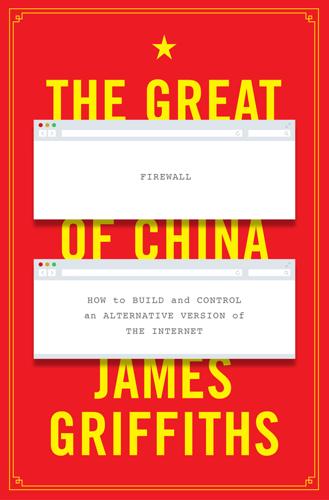
The Great Firewall of China
by
James Griffiths;
Published 15 Jan 2018
Along with Alibaba’s similar, competing service, WeChat Pay took mobile payments from a niche and often annoying practice to absolute dominance in a matter of years. Such is the popularity of mobile payments in China that foreigners often find it difficult to pay with cash, and even buskers print QR codes to allow people to donate money electronically. While not enough credit is given to Chinese consumers and merchants for being faster in adopting and propagating mobile payments than their counterparts in many other countries, Tencent still deserves a huge amount of recognition, creating not only a platform for this growth, but also subsidising it at times to encourage the use of mobile payments.

New Laws of Robotics: Defending Human Expertise in the Age of AI
by
Frank Pasquale
Published 14 May 2020
Sarah Schwarz, “YouTube Accused of Targeting Children with Ads, Violating Federal Privacy Law,” Education Week: Digital Education (blog), April 13, 2018, http://blogs.edweek.org/edweek/DigitalEducation/2018/04/youtube_targeted_ads_coppa_complaint.html; John Montgallo, “Android App Tracking Improperly Follows Children, Study,” QR Code Press, April 18, 2018, http://www.qrcodepress.com/android-app-tracking-improperly-follows-children-study/8534453/. 39. James Bridle, “Something Is Wrong on the Internet,” Medium, November 6, 2017, https://medium.com/@jamesbridle/something-is-wrong-on-the-internet-c39c471271d2. 40. Nick Statt, “YouTube Will Reportedly Release a Kids’ App Curated by Humans,” Verge, April 6, 2018, https://www.theverge.com/2018/4/6/17208532/youtube-kids-non-algorithmic-version-whitelisted-conspiracy-theories. 41.

Binge Times: Inside Hollywood's Furious Billion-Dollar Battle to Take Down Netflix
by
Dade Hayes
and
Dawn Chmielewski
Published 18 Apr 2022
The promotional drumbeat continued across the Disney empire. Dancing with the Stars host Tom Bergeron talked up the streaming service during one Disney-themed episode of ABC’s long-running competition show. Buses wrapped in Disney+ ads ferried guests to and from Walt Disney World in Orlando, Florida. Disney Store employees wore lanyards emblazoned with QR codes, enabling shoppers to scan them with their phones and start instantly downloading the Disney+ app. With anticipation this high, there was a high risk of backlash. Users who had rushed to download Disney+, some of them gladly submitting their credit cards nearly three months before the service became available, encountered an error message on day one.

The Equality Machine: Harnessing Digital Technology for a Brighter, More Inclusive Future
by
Orly Lobel
Published 17 Oct 2022
With government agencies drowning in data, she sees enormous potential in those oceans of information. The Anti-Human Trafficking Intelligence Initiative (ATII), a non-profit formed in 2019, is similarly partnering with law enforcement agencies and private sector companies to fight against human trafficking. ATII developed a phone app through which victims can scan QR codes placed in the bathrooms of hotels and other public places identified as potential loci of trafficking victims. Once the data is received, law enforcement can obtain cell phone records. It takes a lot of information to determine if someone is trafficking people, including the person or group’s patterns, website postings, and travel.
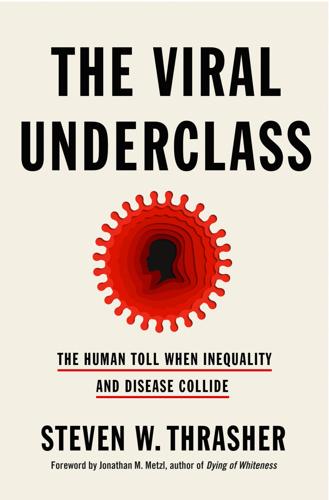
The Viral Underclass: The Human Toll When Inequality and Disease Collide
by
Steven W. Thrasher
Published 1 Aug 2022
At the same time, people who were elderly, disabled, or experiencing homelessness often lacked the prophylactic possibilities of literacy and computer literacy. And yet, even as the pandemic unduly slaughtered people like them, U.S. governmental agencies often required them to use internet sign-ups, QR codes, or even two-factor cell phone authentication to access the prophylactic possibility of vaccination. The postcolonial scholar Achille Mbembe described necropolitics as revealing how “the ultimate expression of sovereignty resides, to a large degree, in the power and the capacity to dictate who may live and who must die.”

Flowers of Fire: The Inside Story of South Korea's Feminist Movement and What It Means for Women's Rights Worldwide
by
Hawon Jung
Published 21 Mar 2023
.”* To help the next generation of survivors, the campaigners also created their own easy-to-understand, step-by-step guidebook for students on how to respond to digital sex crimes—including where to seek help, how to support victims, and even how to publicize their cases to the media if necessary. Posters with a QR code linked to the online guidebook were plastered at all K-12 schools across South Gyeongsang Province, a project funded by anonymous online donors. “Our case is coming to an end, but digital sex crimes at school are an ongoing story,” Park said. “We wanted to share our trials and errors with children so that they can respond better and eventually help those who’d come later.”
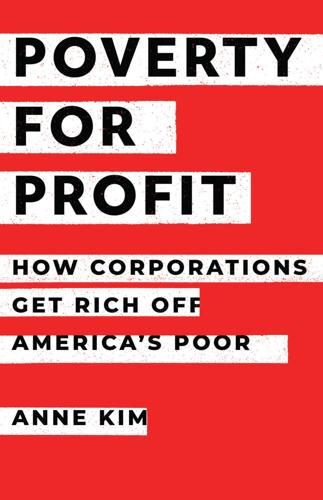
Poverty for Profit
by
Anne Kim
Here are a few ways to keep up to date with our books, events, and the issues we cover: Sign up at www.thenewpress.com/subscribe to receive updates on New Press authors and issues and to be notified about local events www.facebook.com/newpressbooks www.twitter.com/thenewpress www.instagram.com/thenewpress Please consider buying New Press books not only for yourself, but also for friends and family and to donate to schools, libraries, community centers, prison libraries, and other organizations involved with the issues our authors write about. The New Press is a 501(c)(3) nonprofit organization; if you wish to support our work with a tax-deductible gift please visit www.thenewpress.com/donate or use the QR code below. Also by Anne Kim Abandoned: America’s Lost Youth and the Crisis of Disconnection © 2024 by Anne Kim All rights reserved. No part of this book may be reproduced, in any form, without written permission from the publisher. Requests for permission to reproduce selections from this book should be made through our website: https://thenewpress.com/contact.
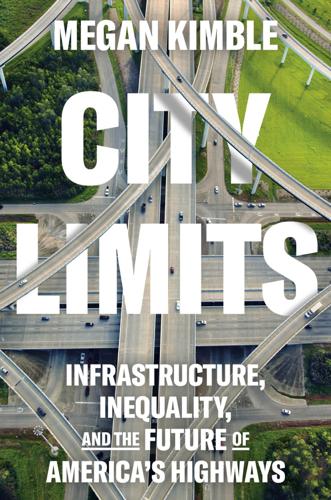
City Limits: Infrastructure, Inequality, and the Future of America's Highways
by
Megan Kimble
Published 2 Apr 2024
He pulls out seats and offers cold bottled water before asking, in Spanish, “What can I help you with?” “We live down at the end of Ishmeal,” Elda says. The man sits in a swiveling office chair. “We’re directly affected by the I-45 expansion. We’re going door to door to try to get signatures, but through an online survey.” The man sees the QR code on the flyer she’s just handed him and goes to get his smartphone. “I wasn’t sure when that was going to happen,” he calls from the other room. He’d heard about the project years ago but lost track of it. “It’s on a pause,” Jesus says. “We’re trying to get people who support us to see if we can stop it permanently.”

The Long Boom: A Vision for the Coming Age of Prosperity
by
Peter Schwartz
,
Peter Leyden
and
Joel Hyatt
Published 18 Oct 2000
COMpUTER WOfild. This OPTION could ACTUAlly help solve SOME NAqqiNq psoblEMs. COMPUTER code WAS bEcowiNq so cowplex ThAT ThE bEST WAy TO solve ThE pRoblews ARisiNq FROM cowplExiiy WAS TO open The code up TO All ACROSS ThE NET. Also CUSTOMERS WER dEMANdiNq iNTEROpERAbiliTy ANd The AbiliTy TO TAJ|QR codE TO ThEiu NEtds. By 36 The Lowq BOOM purrinq ITS codi ON T!HE INTERNET, MICROSOFT would fully MOVE INTO the INTERNET ERA ANd IEAVE behiNd Ths PC ERA T!W IT hAd dowiiWEd, Ths cowpANy woul ThfiN COMPETE ON The QUAliTy ANd PRICE Of ITS AppliCATIONS ThAT RAN ON T^E COM' WON BASE code, IT would Rise Awd fftll ON ITS SERVICE ANd The QENUINE value IT bRouqhT TO ThE MAfikerplACE.
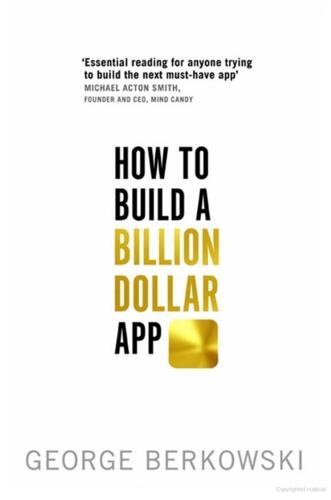
How to Build a Billion Dollar App: Discover the Secrets of the Most Successful Entrepreneurs of Our Time
by
George Berkowski
Published 3 Sep 2014
In August 2012 it announced a deal with Starbucks, whereby the coffee giant would accept the Square Wallet app at all 7,000 of its locations (at the same time Square took a $25 million investment from the company).2 The Square Wallet app stores your credit-card information, and then allows you to pay at any store accepting Square payments by simply scanning the Square App (in this case a QR code) on a Starbucks register. The key to success in this type of partnership is sustainable mutual benefit: Square clearly benefits from a high-profile partner, masses of PR, and great in-store positioning for its super-easy-to-use payments app; Starbucks gets a huge image boost as a progressive, technology-friendly company that already offers free wi-fi in all its stores, making it yet more attractive for the coffee-dependent tech crowd.

Lonely Planet Amsterdam
by
Lonely Planet
Bike Sharing & Apps Donkey Republic (www.donkey.bike) Unlock/lock a bike via Bluetooth. Rates per 24 hour are €12. You'll need to return the bike to the same location, or pay €20 extra. FlickBike (www.flickbike.nl) Locate bikes around town via this app; rental per 30 minutes costs €1. Scan the QR code to unlock/lock the bike. It can be returned to any Amsterdam bike rack. Spinlister (www.spinlister.com) Like Airbnb for bikes: rent a bike straight from an Amsterdammer. Prices vary. Bike Tours A bike tour is an ideal way to get to know Amsterdam. Bike rental is included in prices (tour companies also rent bikes).
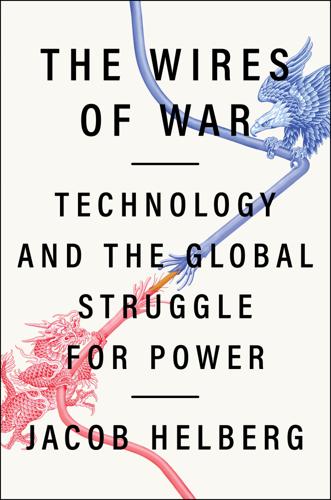
The Wires of War: Technology and the Global Struggle for Power
by
Jacob Helberg
Published 11 Oct 2021
Thanks to a proliferation of “online to offline” services—such as ride-hailing, bike-sharing, and food delivery—and the widespread adoption of mobile payment technology, Chinese companies have access to a trove of data that is both mind-bogglingly vast and incredibly detailed. In China, beggars display QR codes for Alipay and WeChat donations. One Chinese bike-share company alone sends 20 terabytes of data to the cloud each day.25 Whereas U.S. tech companies possess a great deal of data on our online habits—such as our searches and “likes”—China’s tech giants know what you like to buy at the grocery store and where you get your hair done.
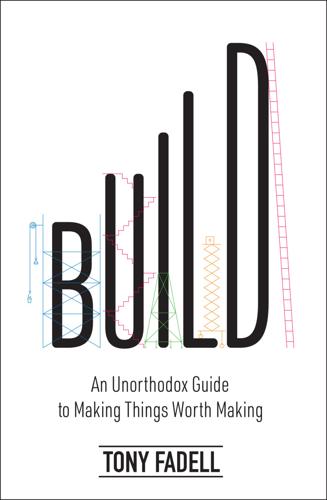
Build: An Unorthodox Guide to Making Things Worth Making
by
Tony Fadell
Published 2 May 2022
They post an update on LinkedIn and people immediately reach out. Oh! This person is available. That’s exciting. Of course, as with everything, it helps to know the right people. The key to finding them is networking. By that I don’t mean going to a conference and working the room, handing out your business cards or QR codes and cornering potential employers as they try to eat their stack of tiny sandwiches. I just mean make new relationships, beyond business—talk to people outside your bubble. Get to know what else is out there. Meet some new human beings. Networking is something you should be doing constantly—even when you’re happily employed.
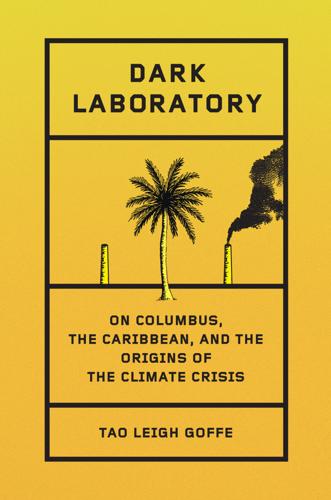
Dark Laboratory: On Columbus, the Caribbean, and the Origins of the Climate Crisis
by
Tao Leigh. Goffe
Published 14 Mar 2025
They carried with them a knowledge of West African and Caribbean botanicals that healed many and derives from the legacy of their foremothers like Queen Nanny. For the backdrop of my painting, the red bauxite earth gestures to current climate debates on the extractive economy and what Maroons have done to protect it from mining. I sutured three canvas panels with gold thread to bring these elements together. A QR code at the natural history museum activates the sonic component of the painting I designed. The soundtrack I produced is an assemblage of sounds of nature I have recorded over the years. I chose to mix these with dancehall riddims: Jamaican instrumentals that are shared and remixed. Titled “Kill Them with the No!

Blockchain Revolution: How the Technology Behind Bitcoin Is Changing Money, Business, and the World
by
Don Tapscott
and
Alex Tapscott
Published 9 May 2016
There are still two billion49 people without a bank account, and in the developed world, prosperity is actually declining as social inequality continues to grow. In developing economies, mobile is often the only affordable means of connecting. Most financial institutions have mobile payment apps that combine cameras and QR codes. However, the fees needed to support these intermediaries make micropayments impractical. Consumers at the bottom of the pyramid still can’t afford the minimum account balances, minimum payment amounts, or transaction fees to use the system. Its infrastructure costs make micropayments and microaccounts unfeasible.

Shutdown: How COVID Shook the World's Economy
by
Adam Tooze
Published 15 Nov 2021
Some containment measures were high tech. In Shanghai, before leaving either the train station or the airport, travelers were required to sign up for a contact tracing app.18 If you could not remember your own movements, a quick text to one of the cell phone providers would produce a list. Yunnan province installed QR codes in all public places so that people could scan themselves on entry.19 In most of China, control worked through more hands-on methods led by neighborhood committees, backed up by the regime’s “grid management” system of local party organizations. This had been a focus of recent efforts on the part of the CCP to consolidate its grip on China’s sprawling new megacities.20 In 2020, that investment in what was called “social administration innovation” paid dividends.
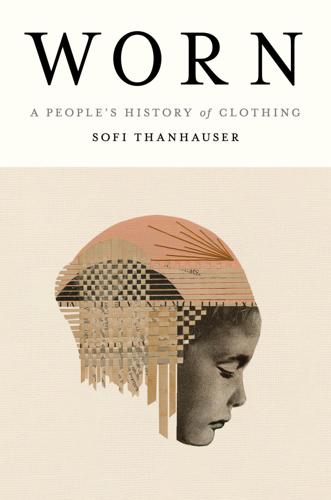
Worn: A People's History of Clothing
by
Sofi Thanhauser
Published 25 Jan 2022
The warp and the weft could be used to make any number of images, just as matter is composed of “the same molecules just bonded or woven together in a different combination.” On the molecular level, Velma noted, things were not always as they appeared. “Things seem to be woven together so tightly but yet there are these spaces in between things that are immense.” Velma made weavings using cassette tape as a weft. She wove a large square QR code into the corner of an American flag, where the stars are normally placed. However, the idea of calling what Velma does less “traditional” than what some of her former classmates were doing begs the question of what “traditional” Navajo weaving really is. Indeed, what is now understood as “traditional” Navajo weaving was shaped by a long legacy of colonial interaction

AI 2041: Ten Visions for Our Future
by
Kai-Fu Lee
and
Qiufan Chen
Published 13 Sep 2021
So far, she had come up empty-handed by searching public channels. A few days earlier, however, on her walk to the office, she had noticed some mysterious graffiti left on the plywood barrier to a Landmark construction site on her route. To her surprise, when she held her phone up to the image, it detected a QR code that took her to a secret online forum. As she scrolled through the forum, she quickly realized it was the online base for a group of Landmark workers organizing against the layoffs—a kind of underground automation-resistance movement. On the forum, anonymous workers had called for a day of protest.
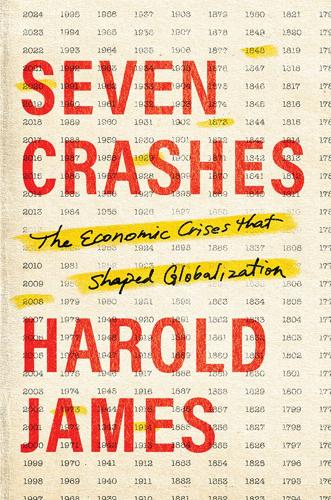
Seven Crashes: The Economic Crises That Shaped Globalization
by
Harold James
Published 15 Jan 2023
At this point, and in response to the entry of eBay into the Chinese market, Ma set up Taobao Marketplace as a consumer ecommerce site; within two years it became the dominant player in the Chinese market. The key to its success was an escrow system, which ensured that suppliers were only paid when customers received and were satisfied with the goods they had bought. Ma also pushed a new payment technology, using QR codes that allowed payments to be made through a smartphone with a service called Alipay, launched in 2004. Ma’s system was unconventional in the sense that he self-consciously rejected both the traditional statist approach—planning—but also conventional financing. His first two ventures had failed because government officials took his ideas and developed them, unsatisfactorily and destructively in his view, with all the power of the state.
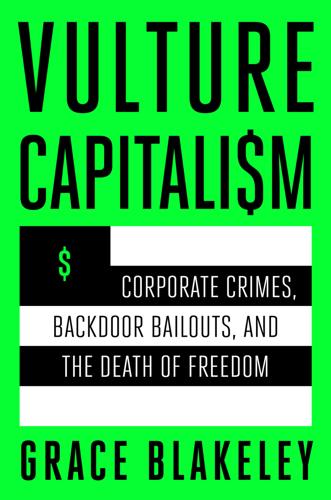
Vulture Capitalism: Corporate Crimes, Backdoor Bailouts, and the Death of Freedom
by
Grace Blakeley
Published 11 Mar 2024
In 2020, 124 countries declared states of emergency in response to the pandemic.104 In Moscow, quarantine rules were enforced through surveillance set up through the city’s vast network of facial recognition cameras.105 In Bahrain, the mandatory BeAware app transmits information on people’s location directly to authorities—and similar measures have been used in Norway and Kuwait.106 France implemented a decree allowing the government to monitor mask wearing on public transport using CCTV.107 In Israel, the government’s pandemic response made use of the dystopian-sounding database known as “the Tool,” which sweeps up data from cell phones about “the location of the device, the cell and antenna zone to which it is connected, every voice call and text message sent or received by the cellular device, and internet browsing history.”108 The Chinese state also developed its own app—the health code—in partnership with the tech giants Tencent and Alibaba. The app uses “opaque algorithms to assess a user’s risk of contagion and restrict their movements.”109 Users input sensitive personal data and are then assigned a red, yellow, or green QR code, which indicates the person’s contagion risk and must be scanned to access venues. In some states, such as Hangzhou, the app is linked to a person’s social security and medical records. Many states are now attempting to make the app a permanent fixture in China, including through proposals to expand it to include a “personal health index” that assigns the user a score based on their sleep, exercise, and eating habits.110 It would be easy to frame these developments as examples of states overstepping the line between public and private power.

The Content Trap: A Strategist's Guide to Digital Change
by
Bharat Anand
Published 17 Oct 2016
“Moments,” according to Zhang, “was a feature that single-handedly undermined Weibo [Tencent’s Twitter-like microblog]: It allowed you to upload your pictures and comment on friends’ pictures—except that your comments were private: Only your direct friends could see them. This is a major difference from Weibo and Facebook. Users feel they are in control.” Features continued to be added to WeChat: first, a news service; then QR Code, a feature that allowed users to scan a bar code and purchase a product through Tencent’s e-commerce platform with one click. (Some described this as the first real threat to Alibaba.) By 2013 WeChat had more than 300 million users. That December it went international, gaining nearly 100 million users outside China within a year.
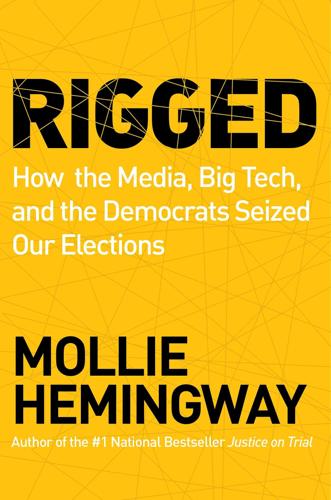
Rigged: How the Media, Big Tech, and the Democrats Seized Our Elections
by
Mollie Hemingway
Published 11 Oct 2021
And the power-hungry ballot-marking devices blew circuit-breakers in numerous locations. Poll workers, many of whom had no hands-on training because of the pandemic, were often befuddled by the new technology,” O’Brien said.24 J. Alex Halderman, a University of Michigan professor of computer science, said he’d analyzed the voting system, which issues a “QR” code for each ballot—a machine-readable optical label that contains information about the item to which it is attached—and found that “there’s nothing that stops an attacker from just duplicating one, and the duplicate would count the same as the original bar code.”25 Halderman had also tested whether voters could catch deliberately placed errors on their ballot, and only 7 percent did.

We Are the Nerds: The Birth and Tumultuous Life of Reddit, the Internet's Culture Laboratory
by
Christine Lagorio-Chafkin
Published 1 Oct 2018
Slowe later recalled, “Whenever we would say we’re from Reddit it was like freaking rock stars walking around the place.” The venue was cavernous: a series of dimly lit rooms connected by narrow hallways. In each room, a group of Redditors perched on banquettes and around tables, exchanging contact information, scanning each other’s QR codes for a Reddit-powered game, and completing scavenger hunts designed to foster in-person conversations among usually pseudonymous Redditors. At 1:30 a.m., Angel finally pulled herself away from a conversation and ducked out of the bar, her head buzzing. To her surprise, the streets were still dense with people—was it really as late as she thought?
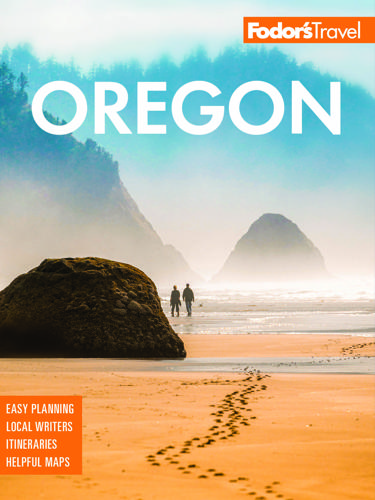
Fodor's Oregon
by
Fodor's Travel Guides
Published 13 Jun 2023
There are more than 180 stations throughout the city, and some 1,500 bikes, each with a small basket (helmets are not provided, however, so consider bringing your own). Just choose a plan (single rides start at 20 cents per minute), sign up through the website or by downloading the app, find a bike and scan the QR code to unlock it, and you’re off. E Portland P 866/512–2453 w biketownpdx.com. SOCCER Portland Timbers SOCCER | Portland’s major-league soccer team plays home matches during their 34-game season at Downtown’s Providence Park from March through October. The city has many ardent soccer fans known as the Timbers Army.

Lonely Planet Belgium & Luxembourg
by
Lonely Planet
A If you arrive at a full stand and so can’t drop off the bike (not uncommon on Saturday nights in popular nightlife areas), enter your code and you should get an extra five minutes to find an alternative. In Hasselt, Mechelen and Kortrijk, Mobit (www.mobit.eu; 1/2/3/4hr hires €1.35/3.30/5.70/8.70) short-hop bikes use a QR-coded key-release system activated by smartphone using the app. Your account is debited per 20 minutes of usage. Boat Antwerp, Namur and Liège have short-hop passenger services on limited stretches of river. Other boat trips, like the Bruges–Damme run, tend to be taken as a tour rather than as transport.
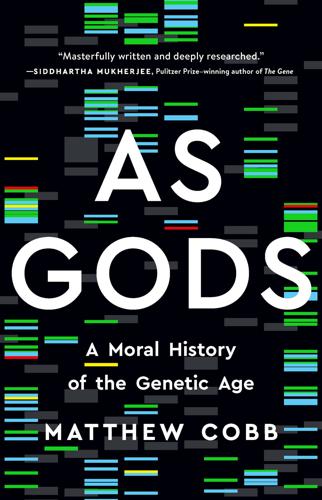
As Gods: A Moral History of the Genetic Age
by
Matthew Cobb
Published 15 Nov 2022
Footnotes i By 2015, 226 cases of vCJD had been identified worldwide; 81 per cent of the patients had lived for at least six months in the United Kingdom. At a global level it looks like we dodged a bullet, but on a personal scale this was a terrible tragedy – all of these people died horribly. ii Since 2016, US consumers have been able to find out if a product contains GM material, but only by using an unhelpful QR code or ringing a telephone number on the product label. iii In 1956 French researchers claimed to have altered ducks by injecting DNA from one type into another. The results did not withstand criticism and the experiment turned into folklore, with Sydney Brenner joking that the experiment had in fact involved crossing a duck and an orange to facilitate French cuisine.
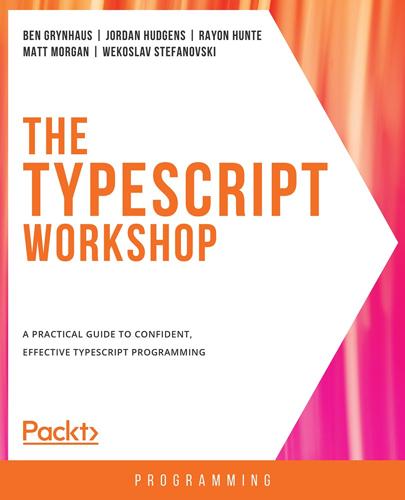
The TypeScript Workshop: A Practical Guide to Confident, Effective TypeScript Programming
by
Ben Grynhaus
,
Jordan Hudgens
,
Rayon Hunte
,
Matthew Thomas Morgan
and
Wekoslav Stefanovski
Published 28 Jul 2021
We really hope you enjoyed reading our book and found it useful for learning TypeScript. It would really help us (and other potential readers!) if you could leave a review on Amazon sharing your thoughts on The TypeScript Workshop. Go to the link https://packt.link/r/1838828494. OR Scan the QR code to leave your review. Your review will help us to understand what's worked well in this book and what could be improved upon for future editions, so it really is appreciated. Best wishes, Ben Grynhaus, Jordan Hudgens, Rayon Hunte, Matt Morgan, and Wekoslav Stefanovski

Engineering Security
by
Peter Gutmann
Alternatively, if the device has display capabilities, it can generate a barcode on-demand on its display, providing a channel that’s very difficult for an attacker to intercept or spoof [320][321]. Barcode-based interaction with cell-phones (although not for security purposes) is already widespread in Japan in the form of quick-response (QR) codes printed in magazines, posters (sometimes the entire poster consists of little more than a gigantic QR code and perhaps some teaser text), business cards, and similar locations, although they haven’t spread much to other countries yet. Pretty much anything can be pressed into service as a form of location-limited channel mechanism, even something as basic as the time-to-live (TTL) or hop limit counter on IP packets [322].

Devil Take the Hindmost: A History of Financial Speculation
by
Edward Chancellor
Published 31 May 2000
In the Interlaken region you can take in the ‘big three’ mountains of Eiger, Mönch and Jungfrau. In fact, definitely don’t miss the Jungfrau Region, where you can dive into a roster of summer and winter sports. GRAND train Tour APP Download the Grand Train Tour App to use as your guide along the tour. The QR Code can be found. Rhaetische Bahn LUCERNE–INTERLAKEN EXPRESS Seat reservations Seat reservations are mandatory on the Glacier Express, Bernina Express and Gotthard Panorama Express, and are recommended for the GoldenPass and Luzern–Interlaken Express. Interlaken – Zweisimmen – Montreux Route details Length: 117km (3.45 hours) Places: Interlaken, Zweisimmen, Gstaad, Rochers-de-Naye, Montreux This route sends you through two worlds.
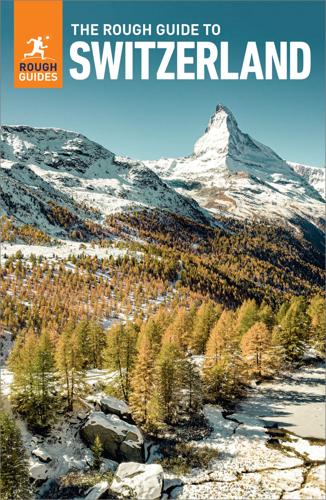
The Rough Guide to Switzerland (Travel Guide eBook)
by
Rough Guides
Published 24 May 2022
In the Interlaken region you can take in the ‘big three’ mountains of Eiger, Mönch and Jungfrau. In fact, definitely don’t miss the Jungfrau Region, where you can dive into a roster of summer and winter sports. GRAND train Tour APP Download the Grand Train Tour App to use as your guide along the tour. The QR Code can be found. Rhaetische Bahn LUCERNE–INTERLAKEN EXPRESS Seat reservations Seat reservations are mandatory on the Glacier Express, Bernina Express and Gotthard Panorama Express, and are recommended for the GoldenPass and Luzern–Interlaken Express. Interlaken – Zweisimmen – Montreux Route details Length: 117km (3.45 hours) Places: Interlaken, Zweisimmen, Gstaad, Rochers-de-Naye, Montreux This route sends you through two worlds.
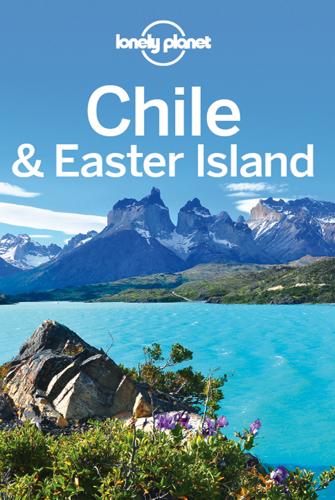
Lonely Planet Chile & Easter Island (Travel Guide)
by
Lonely Planet
,
Carolyn McCarthy
and
Kevin Raub
Published 19 Oct 2015
There are three basic but well-made alerce refugios (rustic shelters) with bathrooms and wood-burning stoves in the park, built along its 16km of trails that traverse rivers via well-built wooden bridges. It’s all very high-tech as well – iPod Touches are available for rent (CH$15,000 per day), and can be used to read Quick Response (QR) codes throughout the park. To get here, catch the once-a-day Lago Tagua-Tagua–bound bus from Puerto Montt (7:45am) or Puerto Varas (8:20am), which meets the ferry at the edge of Lago Tagua-Tagua. Make sure you have called ahead to park officials, who will meet you on the other side of the Tagua-Tagua ferry crossing for the final 10-minute boat ride to the park.
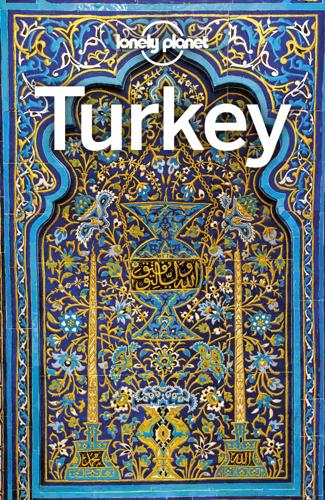
Lonely Planet Turkey
by
Lonely Planet
oBezmigah Cafe & RestaurantCAFE (map Google map; %0462-544 4444; Bedestan; h10am-10pm) If you climb up through the forgettable lower floors of Trabzon’s historic covered marketplace (Bedestan), you emerge in this magical, low-lit space of giant square columns and hefty architectural squinches, all lavished with rugs, lanterns, swords, old cameras, samovars and toy cars. As well as coffees, tea and nargile, there’s a limited menu of snacks plus competent, fair-value garnished meals (₺25). 8Information Tourist Office (%0462-326 4760; www.homeoftrabzon.com; Atatürk Alanı; h8am-10pm Jun-Sep, to 5pm Oct-May) The website, free booklet and QR-coded map offered by this helpful tourist office are likely to inspire you to rent a car and drive up into the many beautiful mountain pasturelands in the country behind the city. 8Getting There & Away AIR Busy Trabzon Airport (TZX; Trabzon Havalimanı; www.trabzon.dhmi.gov.tr; off Atatürk Bulvarı) is 5.5km east of the city centre.